iOpener
≡ ⠿
General description
This is a collection of general knowledge or interesting information compiled by RDP. It used to be included in the Post Family Network help but has now been compiled separately.
Historical
Catherine II of Russia
(Catherine the Great)
Born: May 2, 1729 Szczecin Poland
Died: November 17, 1796 (aged 67) Pushkin Russia
Office: empress (1762-1796), Russian Empire
Noted for: “Instruction of Catherine the Great”
Dynasty: Romanov dynasty
Catherine the Great
Russian Yekaterina Velikaya, also called Catherine II
Russian in full Yekaterina Alekseyevna
Original name Sophie Friederike Auguste, Prinzessin von Anhalt-Zerbst.
German-born empress of Russia (1762–96) who led her country into full participation in the political and cultural life of Europe, carrying on the work begun by Peter the Great. With her ministers she reorganized the administration and law of the Russian Empire and extended Russian territory, adding Crimea and much of Poland.
Sophie Friederike Auguste, Prinzessin (princess) von Anhalt-Zerbst, was the daughter of an obscure German prince, Christian August von Anhalt-Zerbst, but she was related through her mother to the dukes of Holstein. At age 14 she was chosen to be the wife of Karl Ulrich, duke of Holstein-Gottorp, grandson of Peter the Great and heir to the throne of Russia as the grand duke Peter. In 1744 Catherine arrived in Russia, assumed the title of Grand Duchess Catherine Alekseyevna and married her young cousin the following year. The marriage was a complete failure.
How Catherine became EmpressRussia at the time was ruled by Peter the Great’s daughter, the empress Elizabeth, whose 20-year reign greatly stabilized the monarchy. Elizabeth prepared the way for Catherine.
Catherine, however, would not have become empress if her husband hadn't been neurotic, rebellious, obstinate, perhaps impotent, almost alcoholic and, most seriously, a fanatical worshipper of Frederick II of Prussia. Catherine, by contrast, was clear-headed and ambitious. Her intelligence, flexibility of character, and love of Russia gained her much support.
She was bored at court, but found comfort in reading extensively and in preparing herself for her future role as sovereign. Catherine possessed considerable charm, a lively intelligence and extraordinary energy. She had at least three lovers; none of her three children was fathered by her husband.
Grigory Grigoryevich, Count OrlovThe empress Elizabeth died on 5 Jan 1762 (25 Dec 1761, old style) while Russia, allied with Austria and France, was engaged in the Seven Years’ War against Prussia. Shortly after Elizabeth’s death, Peter, now emperor, ended Russia’s participation in the war and lined up with Frederick II of Prussia. Peter made no attempt to hide his hatred of Russia and his love of his native Germany. But Catherine had the support of the army, the court and public opinion in both Moscow and St. Petersburg. On 9 Jul 1762 (28 Jun 1762, old Style), she proclaimed herself empress and autocrat in the Kazan Cathedral.
First years as empressTruly dedicated to her adopted country, Catherine intended to make Russia a prosperous and powerful state. Since her early days in Russia she had dreamed of establishing a reign of order and justice, of spreading education, creating a court to rival Versailles and developing a national culture that would be more than an imitation of French models.
The state treasury was empty when Elizabeth died so Catherine (in 1762) secularized the property of the clergy. She preserved friendly relations with Prussia, France and Austria. In 1764 she resolved the problem of Poland by installing one of her old lovers, the weak Stanislaw Poniatowski as king of Poland.
Expansion of Russia, 1300–1796Catherine was frustrated in her attempts at reform so she seized the pretext of war with Turkey in 1768 to change her policy; henceforth, emphasis would be placed above all on national grandeur. Since the reign of Peter the Great, the Ottoman Empire had been the traditional enemy of Russia; inevitably, the war fired the patriotism and zeal of Catherine’s subjects. Turkey had not yet been defeated, continued fighting and Russia encountered unforeseen difficulties.
First, a plague broke out in Moscow; it created a climate of disaffection and popular agitation.
In 1773 Yemelyan Pugachov incited the greatest uprising of Russian history prior to the revolution of 1917.
In June 1774 Pugachov’s Cossack troops prepared to march on Moscow. At this point, the war with Turkey ended in a Russian victory and Catherine sent her crack troops to crush the rebellion. Catherine realized that the people were more to be feared than pitied, and rather than free them, she must tighten their bonds.
Before her accession to power, Catherine had planned to emancipate the serfs, on whom the economy of Russia, which was 95 percent agricultural, was based. she turned her attention to organizing and strengthening the serf system that she had condemned as inhuman. She imposed serfdom on the Ukrainians who had until then been free.
Ninety five percent of Russian people did not benefit directly from the achievements of Catherine’s reign. Rather, their forced labour financed the immense expenditures required for her ever-growing economic, military, and cultural projects.
Influence of Grigory PotemkinOrdinarily, the empress did not mix business and pleasure; her ministers were almost always selected for their abilities. In Potemkin she found an extraordinary man whom she could love and respect and with whom she could share her power. As minister he had unlimited powers, even after the end of their liaison, which lasted only two years. Potemkin must be given part of the credit for the somewhat extravagant splendour of Catherine’s reign. He had a conception of grandeur that escaped the German princess. He was avid for territories to conquer and provinces to populate; an experienced diplomat with a knowledge of Russia that Catherine had not yet acquired and as audacious as Catherine was methodical, Potemkin was treated as an equal by the empress from 1774 to his death in 1791.
Russian EmpireThe annexation of Crimea from the Turks in 1783 was Potemkin’s work. Through that annexation and the acquisition of the territories of the Crimean khanate†, Russia held the north shore of the Black Sea. Catherine also sought to renew the alliance with Austria, Turkey’s neighbour and enemy, and renounced the alliance with Prussia and England, who were alarmed by Russian ambitions.
†Crimean Khanate - self-defined as the Throne of Crimea and Desht-i Kipchak and, in old European historiography and geography known as Little Tartary, was a Crimean Tatar state existing from 1441-1783.
Catherine IICatherine’s glorification reached its climax in a voyage to the Crimea arranged by Potemkin in 1787. In a festive Arabian Nights atmosphere, the empress crossed the country to take possession of her new provinces; the emperor of Austria, the king of Poland and innumerable diplomats came to honour her and to enjoy the splendours of what became known as “Catherine's fleet” because Catherine and her court traveled partly by water.
Effects of the French Revolution Partitions of Poland, 1772–95Catherine, like all the crowned heads of Europe, felt seriously threatened by the French Revolution. The divine right of royalty and the aristocracy was being questioned, and Catherine, although a “friend of the Enlightenment,” had no intention of relinquishing her own privileges: “I am an aristocrat, it is my profession”. After the national uprising led by Tadeusz Kosciuszko in 1794, Catherine wiped Poland off the map of Europe by dividing it between Russia, Prussia, and Austria in 1795.
Catherine’s last years were darkened by the execution of Louis XVI, the advance of the revolutionary armies, and the spread of radical ideas. The empress realized, moreover, that she had no suitable successor. She considered her son Paul an incompetent and unbalanced man; her grandson Alexander was too young yet to rule.
Legacy of Catherine the GreatRussians continue to admire Catherine, the German, the usurper and profligate, and regard her as a source of national pride. Because Russia, under her rule, grew strong enough to threaten the other great powers, she figured in the Western imagination as the incarnation of the immense, backward, yet forbidding country she ruled. One of Catherine’s principal glories is to have been a woman who, just as Elizabeth I of England and Queen Victoria gave their names to periods of history, became synonymous with a decisive epoch in the development of her country.
At the end of Catherine’s reign, Russia had expanded westward and southward over an area of more than 200,000 square miles, and the Russian rulers' dream of access to the Bosphorus Strait had become an attainable goal. At the end of her reign Catherine claimed that she had reorganized 29 provinces. An uninhibited spender, she invested funds in many projects. More than a hundred new towns were built; old ones were expanded and renovated. As commodities were plentiful, trade expanded and communications developed. These achievements, together with the glory of military victories and the fame of a brilliant court have won her a distinguished place in history.
Catherine had young lovers up to the time of her unexpected death from a stroke at the age of 67 and her official favourite changed at least a dozen times; she chose handsome and insignificant young men, who were only, as one of them himself said, “kept girls.” She didn't love her son Paul, the legitimate heir. On the other hand, she adored her grandsons, particularly the eldest, Alexander, whom she wished to succeed her.
She carried on an extensive correspondence with most of the important personages of her time. She was a patron of literature and a promoter of Russian culture; she herself wrote, established literary reviews, encouraged the sciences, and founded schools. Her interests and enthusiasms ranged from construction projects to lawmaking and the collection of art objects; she touched everything - not always happily but always passionately. She was a woman of elemental energy and intellectual curiosity, desiring to create as well as to control.
She also wrote a guideline for law-makers. Her instructions were:
- All men should be considered equal before the law.
- The law should protect, not oppress, the people.
- The law should only forbid harmful acts.
- Serfdom should be abolished.
- Capital punishment and torture should cease.
- The principle of absolutism should be upheld.
| ≡ | ⇧ |
The Tudors
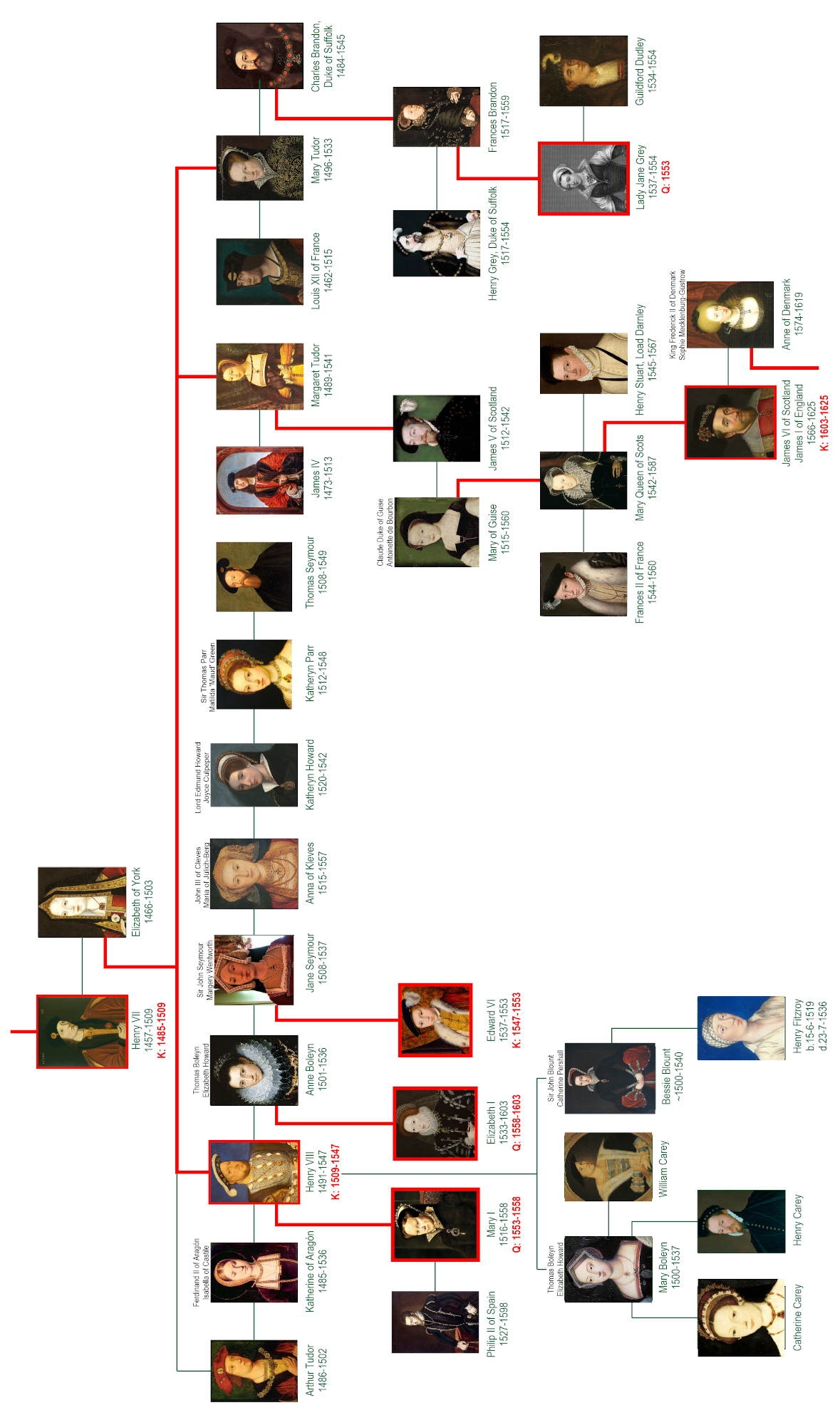
| ≡ | ⇧ |
Henry VIII and his six wives
Born: 28 Jun 1491
Died: 28 Jan 1547
Reigned: 22 Apr 1509 - 28 Jan 1547
Married: see below
“Divorced, beheaded, died; divorced, beheaded, survived” says the rather trite and somewhat disrespectful classroom rhyme. It is also wrong as Henry had his marriages to Katherine of Aragón, Anne Boleyn and Anna of Cleves annulled - divorces were very, very rare because ...
... in the 16th century, marriage was 'for life' so a divorce (being the termination of a union) didn't make way for a re-marriage; an annulment however meant the marriage never existed so a new marriage could take place. But even Henry's annulments were only sanctioned by the Church of England, as it became; they were not sanctioned by the Pope.
You could, however, view Henry's wives differently:
| Katherine of Aragón | the bitter, abandoned, first wife | the betrayed wife |
| Anne Boleyn | the original 'other' woman | the temptress |
| Jane Seymour | a bit of a doormat | the good woman |
| Anna of Cleves | the ugly one | the ugly sister |
| Katheryn Howard | the one who slept around | the bad girl |
| Kateryn Parr | the saintly nurse | the mother figure |
| Lucy Worsley, Six Wives, BBC, MMXVI | Antonia Fraser, The Six Wives of Henry VIII |
Henry was distantly related to all six of his wives through their common ancestor Edward I.
For a chart, see here
For a timeline, see here
And, of his six wives, only Katherine of Aragón and Anne Boleyn were crowned Queen Consort. Lack of money meant the other four were wives but not actually queens.
No 1. Katherine of Aragón
Born 16 Dec 1485, m.1509, an.1536, died 7 Jan 1536
Catalina de Aragón, Princes of Spain, was born to Isabella I of Castile and Ferdinand II of Aragón - she became Henry VIII's first wife and the mother of Mary I.
 |
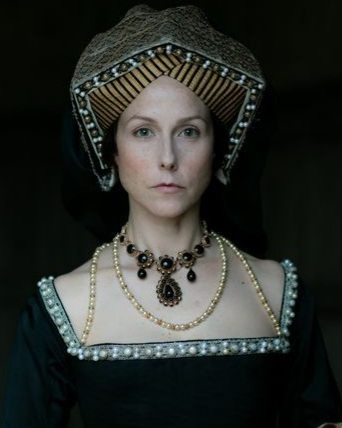 |
 |
||
| Katherine of Aragón | From "Six wives" | Paola Bontempi |
Other actresses who've played Katherine of Aragón:
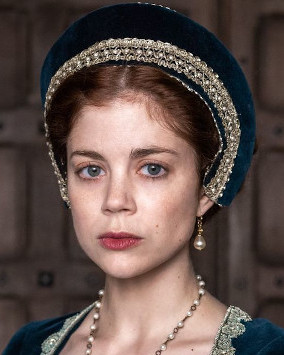 |
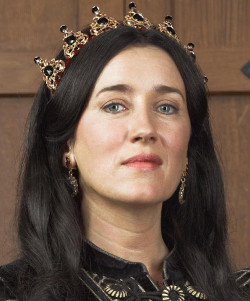 |
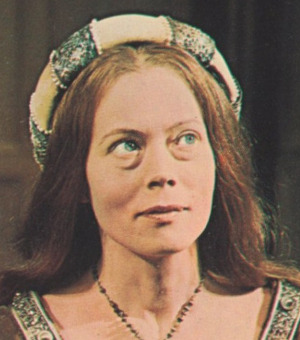 |
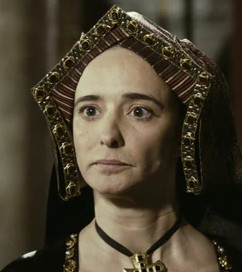 |
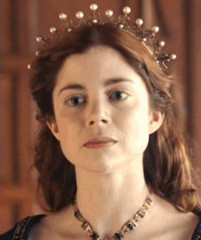 |
||
| Charlotte Hope | Maria Doyle Kennedy | Annette Crosbie | Ana Torrent | Annabelle Dowler |
In modern texts, her name is most commonly spelled Catherine, although she spelled and signed her name with a "K," which was an accepted spelling in England at the time.
Katherine had 9 siblings:
| Alonso de Estrada | 1470 - 16 Feb 1530 |
| Isabella of Aragón | 2 Oct 1470 - 23 Aug 1498 |
| Juana de Aragón | 1471 - 1522 |
| John, Prince of Asturias | 30 Jun 1478 - 4 Oct 1497 |
| Alonso of Aragón | 14 Aug 1478 - 24 Feb 1520 |
| Joanna of Castile | 6 Nov 1479 - 12 Apr 1555 |
| Maria of Aragón | 29 Jun 1483 - 7 Mar 1517 |
| Katherine of Aragón | 16 Dec 1485 - 7 Jan 1536 |
| Miguel Fernández Caballero de Granada | 1495 - 1575 |
| John of Aragón, Prince of Girona | 3 May 1509 - 3 May 1509 |
She was originally/first married to Arthur, Henry VIII's elder brother. She was a year older than Arthur and six years older than Henry. After Arthur died in 1502, a papal dispensation was obtained to enable her to marry Henry (VIII), although the marriage did not take place until he came to the throne in 1509. During those 7 years, Katherine was kept in penury while Henry VII argued with Ferdinand and used her as a weapon fighting for her dowry. When she finally married Henry VIII he was 18 years old and she was 24. Katherine became pregnant in 1510, but sadly had a stillborn daughter. She became pregnant again in 1511 and gave birth to Henry, Duke of Cornwall, who died 52 days later. She then gave birth to a boy in 1513 and to another boy who died within hours in 1515. Finally in 1516, at the age of 31, she bore a healthy daughter, Mary. So Katherine had had three sons and a daughter all of whom died before she had Mary. After giving birth to Mary, Katherine is quoted as saying “We are both young. If it was a daughter this time, by the Grace of God sons will follow”. Unfortunately, she never did have that son Henry so desperately wanted - it would be two years before she conceived again and the pregnancy ended with a short-lived girl.
Henry not only loved Katherine but he clearly respected her too for he made her Regent while he was away fighting in Thérouanne, France. His absence prompted James IV of Scotland (married to his sister Margaret) to invade England but Katherine sent 26,000 troops up to Flodden (Nr Branxton, Northumberland) to challenge him; the invasion was successfully quoshed and James was killed.
Although Henry truly loved Katherine, as he professed many times, he became increasingly concerned that he did not have a son to continue the Tudor dynasty. By the late 1520s, it was clear that Katherine (now in her mid-40s) would not bear any more children and Henry, desperate for a legitimate son, started scheming to break his marriage to Katherine so that he could marry again. This was before he proposd to Anne. Indeed, in 1528, a 'sweating sickness' broke out in London and Henry ran to the country with Katherine. He didn't take Anne - he sent her a warning once he had escaped and she went back to Hever. All three of them survived the 'sweat'.
Henry, at the time a Roman Catholic, sought the Pope's approval for an annulment on the grounds that Katherine had first been his brother's wife. He used a passage from the Old Testament (Leviticus Chapter 20 Verse 21): "If a man shall take his brother’s wife, it is an impurity; he hath uncovered his brother’s nakedness; they shall be childless." [Is this true even if the brother has died?] The Pope refused to annul the marriage but, in 1531, Henry separated from Katherine anyway - she was 46, he was 40. Thomas Cranmer finally pronounced the marriage null and void on 23 May 1533 after Henry had bigamously married Anne the previous January. This act led to England breaking from the Roman Catholic Church and the establishment of the (Protestant) Church of England.
Shortly after marrying Anne Boleyn, Henry banished Katherine to Kimbolton Castle. She didn't see Henry, or their daughter Mary, again before she died at Kimbolton on 7 Jan 1536 when she was aged 50.
William Shakespeare, in the play Henry VIII, called Katherine "The queen of earthly queens" (2.4.138).
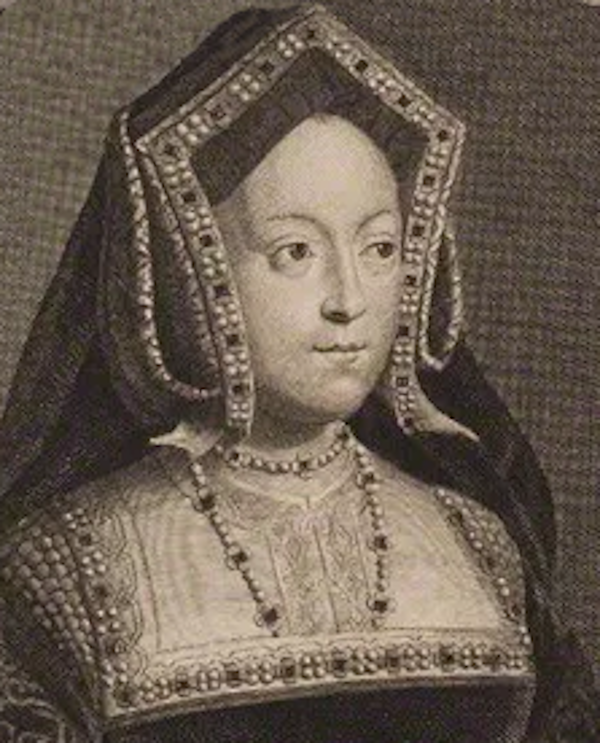 |
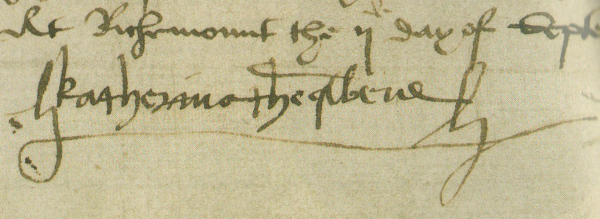 |
||
| A portrait (NPG D18834 cropped) |
Her signature |
| ≡ | ⇧ |
No 2. Anne Boleyn - Marchioness of Pembroke
Born 1501†, m.1533, an.1536, died 19 May 1536
Anne was born to Thomas Boleyn (later Earl of Wiltshire) and Elizabeth Howard - she became Henry VIII's second wife and the mother of Elizabeth I.
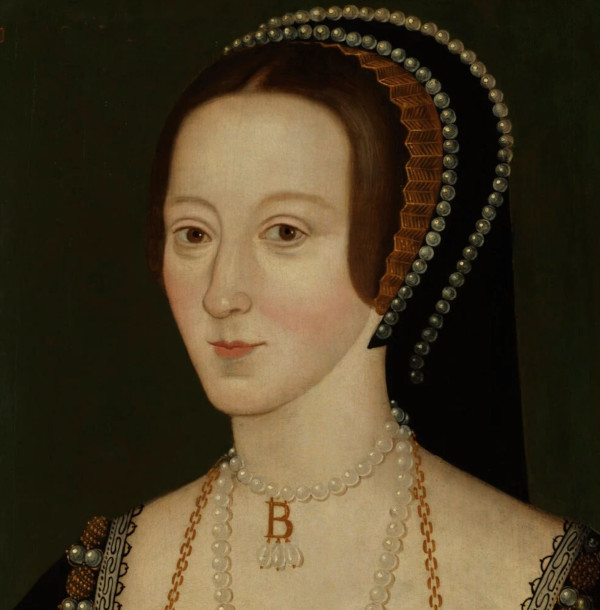 |
 |
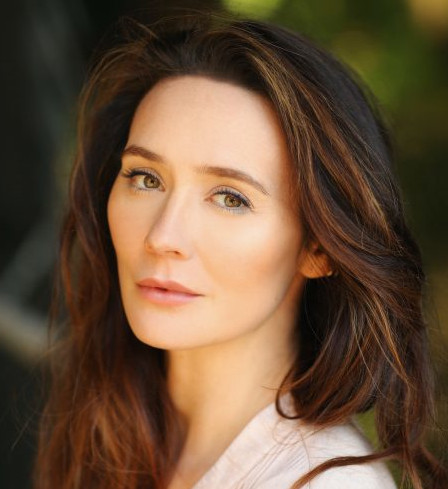 |
||
| Anne Boleyn | From "Six wives" | Claire Cooper |
Other actresses who've played Anne Boleyn:
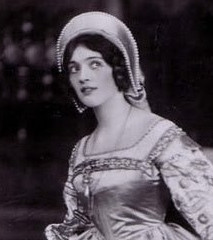 |
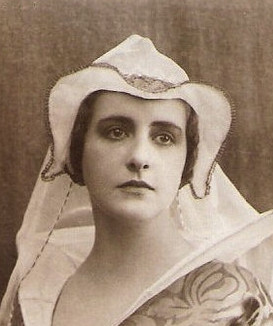 |
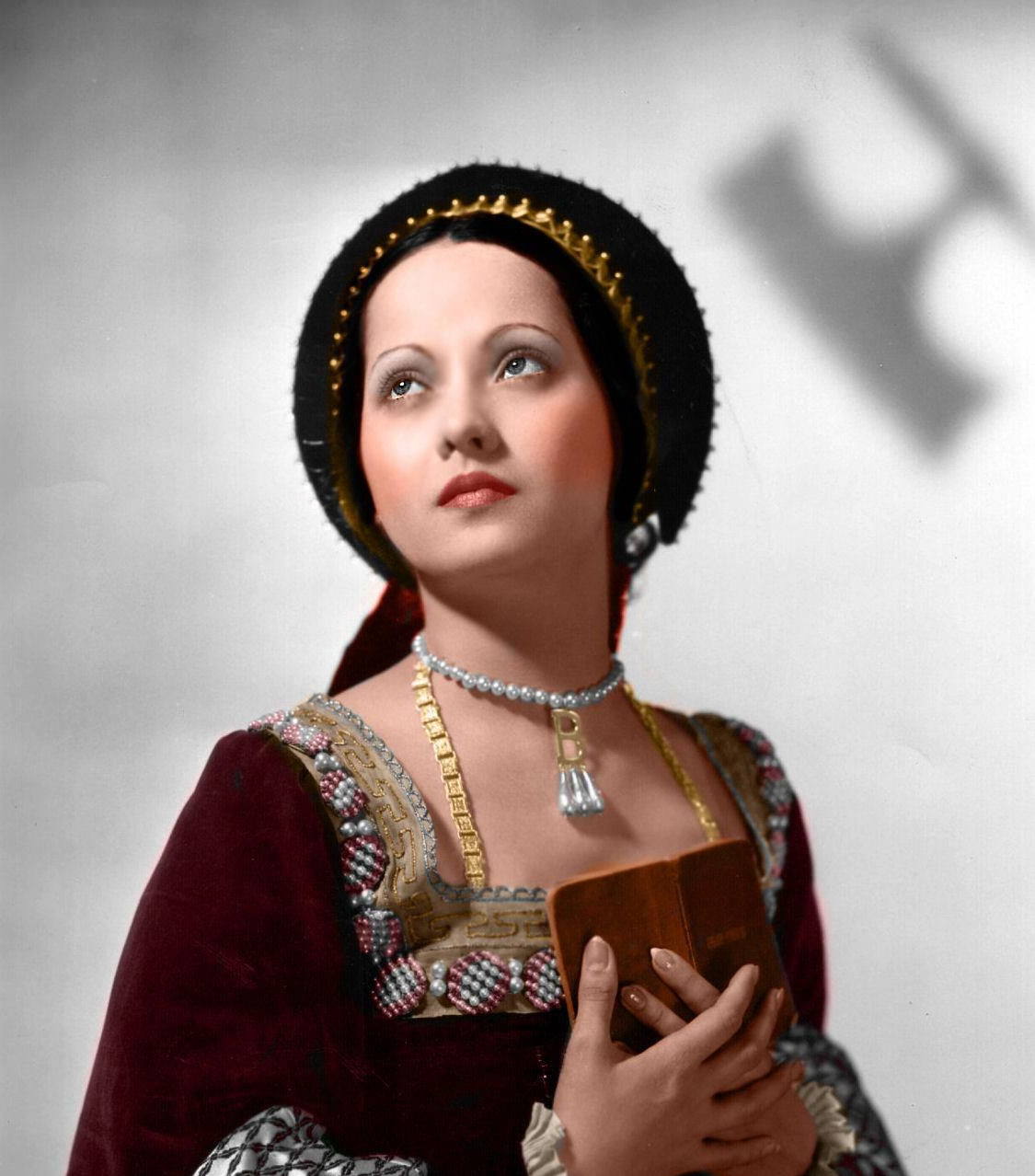 |
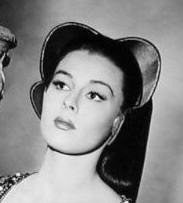 |
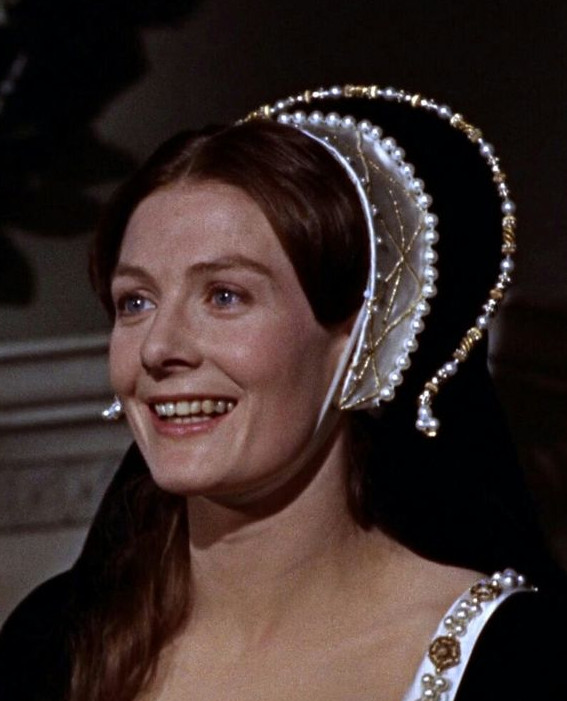 |
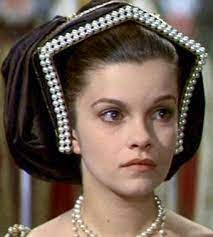 |
||
| Laura Cowie (1911) | Henny Porten (1920) | Merle Oberon (1933) | Elaine Stewart (1953) | Vanessa Redgrave (1966) | Geneviève Bujold (1969) | ||
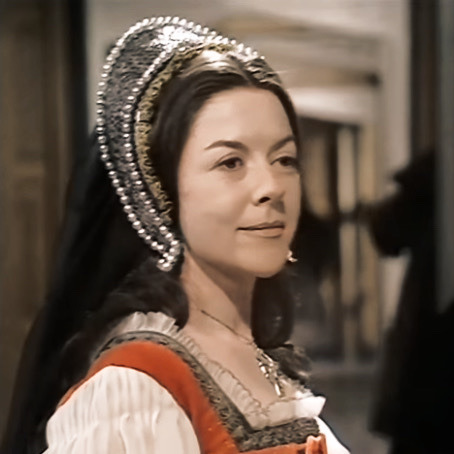 |
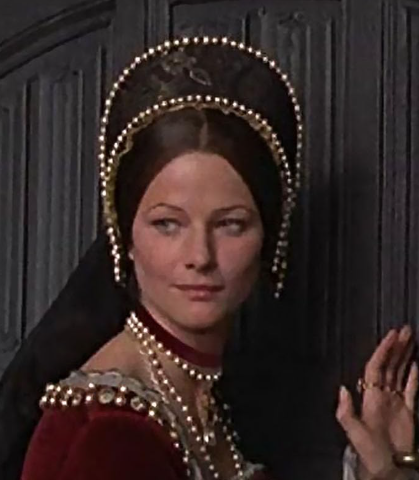 |
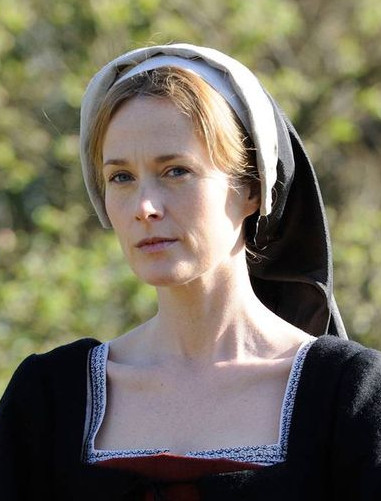 |
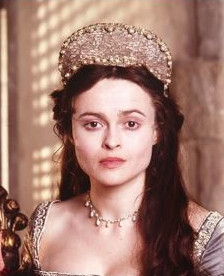 |
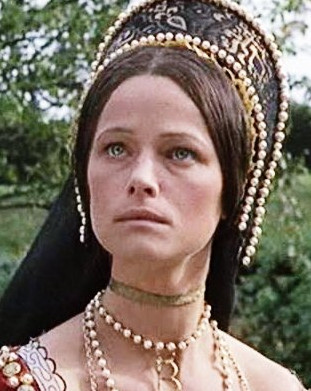 |
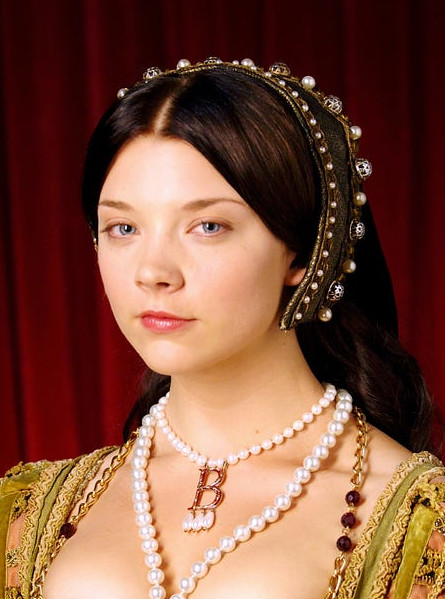 |
||
| Dorothy Tutin (1970) | Charlotte Rampling (1972) | Natasha Little (2000) | Helena Bonham-Carter (2003) | Jodhi May (2003) | Natalie Dormer (2008) | ||
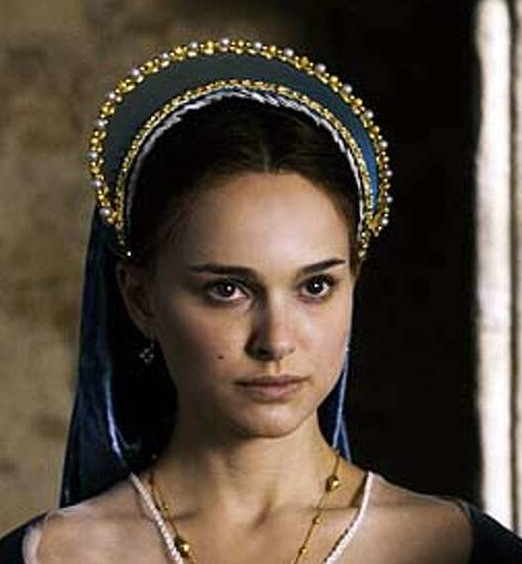 |
 |
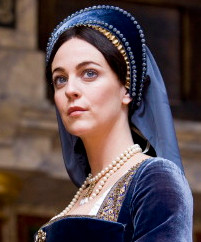 |
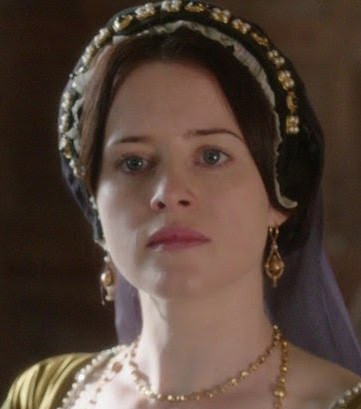 |
 |
 |
||
| Natalie Portman (2008) | Daisy Doidge-Hill (2008) (young anne) |
Miranda Raisin (2010) | Claire Foy (2015) | Claire Cooper (2016) | Jodie Comer (2021) |
Anne was the daughter of Sir Thomas Boleyn and Lady Elizabeth (née Howard). She was of nobler birth than Jane Seymour, Henry's later wife. She was dark-haired with beautiful features and a lively disposition. She spoke very good French and lived in France for part of her life - largely as a lady-in-waiting to Queen Claude. She had good manners and knew arithmetic, English grammar, history, genealogy, reading, writing and spelling; she could dance, play music, sing, embroider, do needlework, and household management. In addition, she could play card games and chess and was proficient at falconry, archery, horseback riding and hunting. She was quite the feminist.
Anne resisted the king's attempts to seduce her and refused to become his mistress as her elder sister Mary Boleyn had been. It soon became the one absorbing object of the King's desires to secure a divorce from his wife Katherine of Aragón so that he could marry Anne. He wrote many 'love' letters to Anne. She had gone back to Hever Castle in July 1526 to get away from Henry's pursuits and it was when he came back to court in the autumn, to find her gone, that the love letters started. In Aug 1528 he wrote one in which he said "wishing myself (especially an evening) in my sweetheart’s arms, whose pretty dukkys I trust shortly to kiss". It was at this stage that phase one of 'idealise/devalue/discard' of a sociopath kicked in triggering Henry's obsession. Of the letters he wrote, 17 still exist (astonishingly in the Vatican)†† although they are all undated so, although the context gives a good idea, the sequence in which they were written (and should be read) is open to interpretation.
While still married to Katherine, Henry bigamously married Anne, probably on St Erkenwald's Day - 14 Nov 1532. Anne soon became pregnant and so a second wedding service was held in London on 25 Jan 1533. Later that year, on 23 May, Cranmer declared the marriage of Henry and Katherine null and void [so was Mary born in or out of wedlock and therefore a rightful heir to the throne or not?‡]. Five days later, Cranmer declared the marriage of Henry and Anne to be good and valid.
Soon after that, the Pope launched sentences of ex-communication against the King and the Archbishop. And as a result of Henry's marriage to Katherine being declared null and void, Rome broke away from England and the English monarch became head of the Church of England.
Henry blamed his Lord Chancellor, Thomas Wolsey, and charged him with treason. Later he appointed Sir Thomas More as Chancellor and the Boleyn family's chaplain Thomas Cranmer as Archbishop of Canterbury.
Anne was crowned Queen Consort of England on 1 Jun 1533, and she gave birth to Henry's second daughter Elizabeth on 7 Sep 1533. Sadly, Anne had another stillborn daughter in 1534 and a stillborn (possible) son in 1536 but she failed to produce a living male heir.
Henry eventually grew tired of waiting for the son that Anne could not produce so he set about getting their marriage annulled so that he could marry again - he wanted their marriage quoshed; Cromwell wanted her out of the way altogether so he set about concocting her conviction and death.
Henry may have been brain-damaged at his accident in January 1536. And he was a sociopath and this goes a long way towards explaining why he treated so many of his subjects and wives so badly. He cycled through the classic stages of 'idealise/devalue/discard' on many occasions and with many people besides Anne. For instance, he had Sir Richard Empson and Edmund Dudley sent to the tower for execution on his second day as king. One might say Anne was not so much the love of his life as an object of his desire.
Despite a horrific lack of witnesses and evidence, Anne was found guilty of adultery, incest, and high treason. Many of the dates when she was alleged to have conducted these affairs simply didn't match up. But five people, with whom she was said to have had relations, her brother George Boleyn and four others, Sir Henry Norris, Sir William Brereton, Sir Francis Weston and Mark Smeaton, were all executed on 17 May 1536. The five men had been sentenced to be hanged, drawn and quartered but, because they were all in the service of the royal court, the sentence was commuted to death by beheading. And here comes the 'discard' phase of a sociopath's obsession: Anne herself was beheaded on 19 May 1536. Although Henry was having her executed for treason, he put her up in decent accommodation (the Queen's Lodgings) in the tower and had her beheaded by the best French swordsman - not the usual British axe.
Henry'd been courting Anne for seven years and he was married to her for three but the day after she was beheaded, Henry was betrothed to Jane Seymour (20 May 1536) and he married her ten days later (30 May 1536).
After the ascension to the throne on 17 Nov 1558 and subsequent coronation of her daughter, Elizabeth I on 15 Jan 1559, Anne was venerated as a martyr and heroine of the English Reformation, particularly due to the works of John Foxe (Actes and Monuments). Over the centuries, she has inspired or been mentioned in numerous artistic and cultural works. Henry's marriage to Anne and her execution made her a key figure in the political and religious upheaval at the start of the English Reformation. She didn't actually denegrate Catholic beliefs - she merely wished to dismantle the hierarchy in the church which kept the teachings of the bible from the people.
† Elizabeth Norton's Anne Boleyn Papers p.32 report that Anne was 'placed' with Margaret of Austria and wrote to her father saying she'd be a "worthy woman when I come to court". These words seem more like those of a young teenager than a six-year-old which makes her birth more likely to have been 1501 than 1507.
Also, Anne's father, Thomas, wrote in a letter to Thomas Cromwell “When I married I had only £50 a year to live on for me and my wife as long as my father lived, and yet she brought me every year a child”.
†† The 'love' letters
The so called love letters were written over three years from August 1526 to 1529 and they weren't dated so the order in which they took place can only be judged from the seasons and the logic of what is written - remembering that Anne is wanting to keep Henry 'at bay'.
††† oyer and terminer
A commission under which a court is empowered to hear and determine a criminal case.
‡ The Succession Acts
- 1st Succession Act, 1534
- declared Mary as illegitimate (because Katherine of Aragón's marriage had been annulled) and therefore Elizabeth was heir presumptive. It also declared Anne was Queen
- 2nd Succession Act, 1536
- denied both Mary and Elizabeth succession.
- 3rd Succession Act, 1543
- gave both Mary and Elizabeth succession rights (after Edward VI) but not legitimacy.
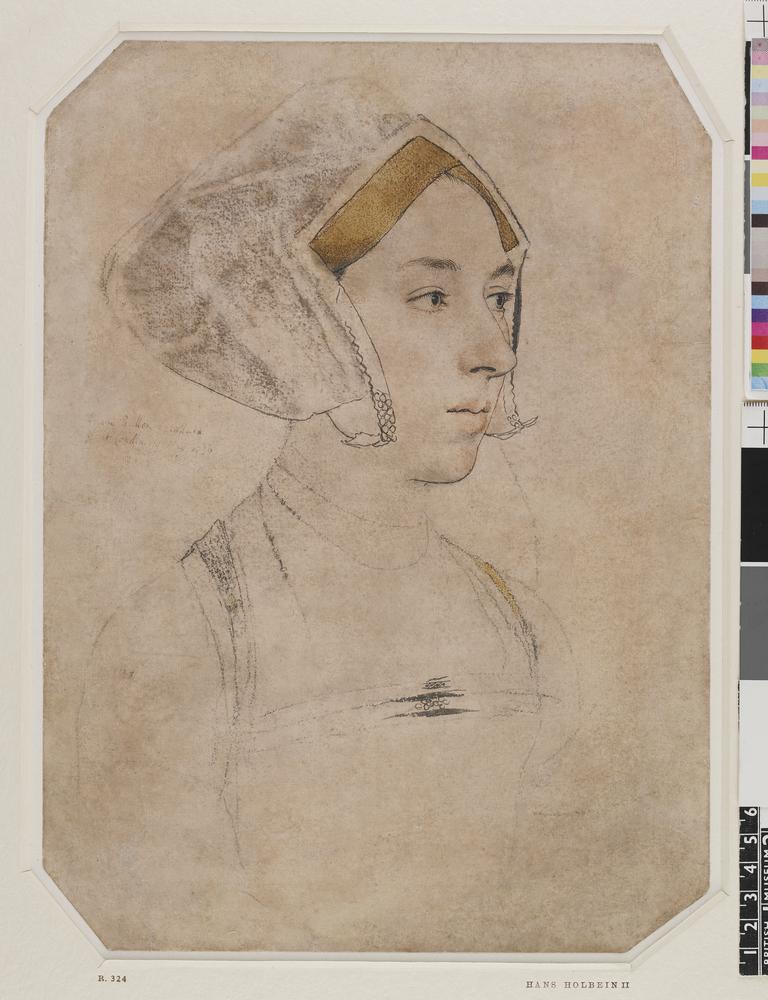 |
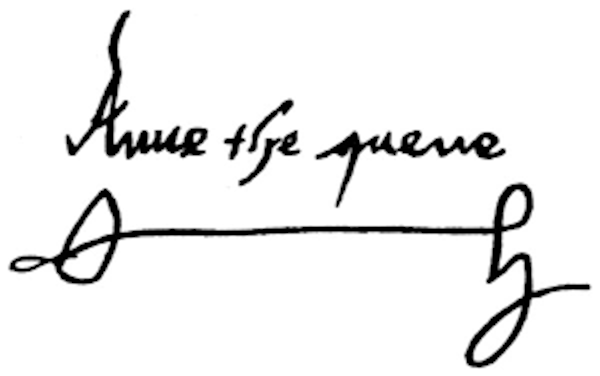 |
||
| A sketch of her by Holbein | Her signature |
| ≡ | ⇧ |
No 3. Jane Seymour
Born 1508, m.1536, died 24 Oct 1537
Henry's third wife and mother of Edward VI.
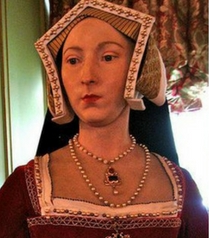 |
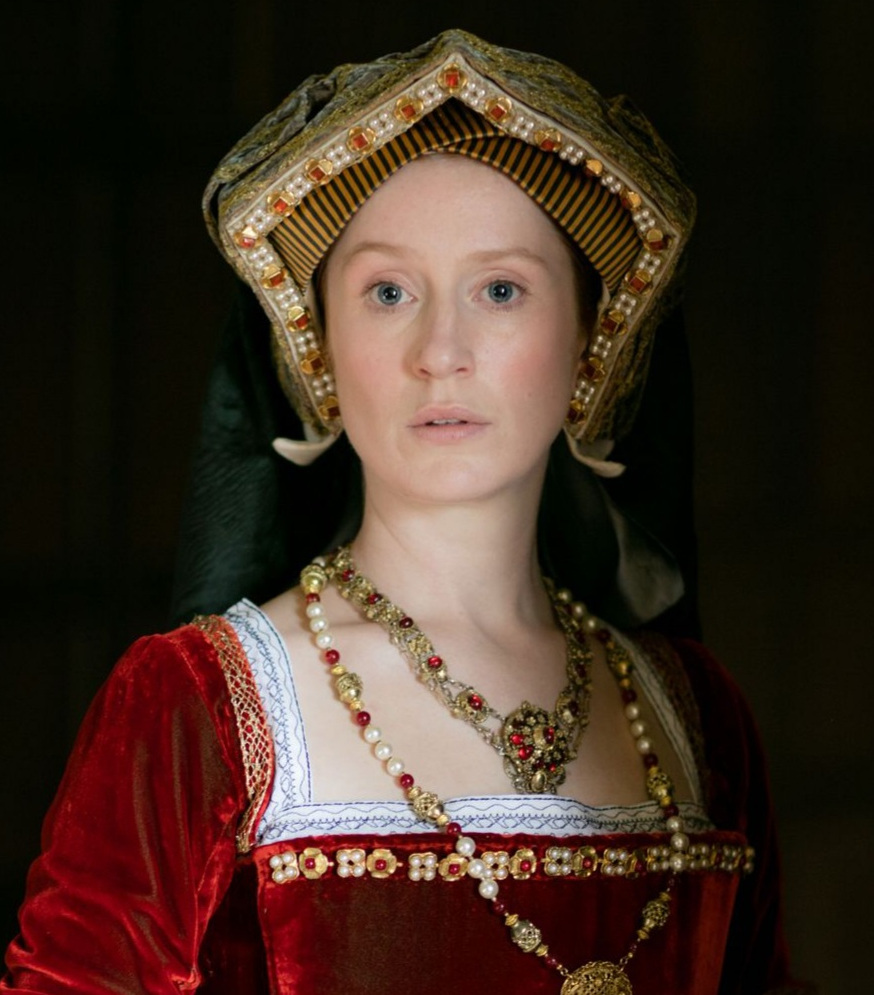 |
 |
||
| Jane Seymour | From "Six wives" | Elly Condron |
Other actresses who've played Jane Seymour:
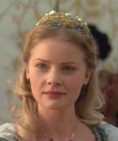 |
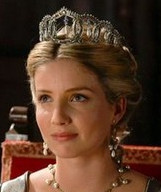 |
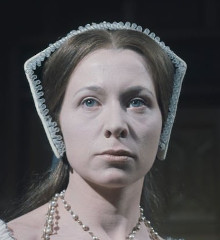 |
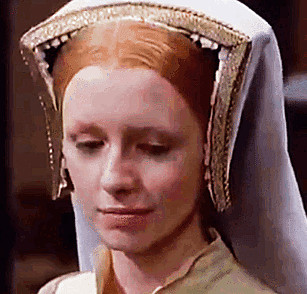 |
 |
||
| Anita Briem | Annabelle Wallis | Anne Stallybrass | Jane Asher | Lesley Paterson |
She served Katherine of Aragón as maid-of-honour and was one of Anne Boleyn's ladies-in-waiting.
Jane, the daughter of Sir John Seymour, and Margery (née Wentworth), was most likely born at Wolfhall, Wiltshire, although West Bower Manor in Somerset has also been suggested. Her birth date is not recorded although it is thought to be about 1508. She was of lower birth than most of Henry's wives, only being able to read and write a little, but was much better at needlework and household management, which were considered much more necessary at that time.
Jane was a much quieter, and Catholic, person who didn't have the outgoing character that Anne had shown. And she may also have observed how to (or at least how not to) deal with Henry during her time in the courts of Katherine and Anne before her.
Jane was betrothed to Henry VIII on 20 May 1536 (the day after Anne's execution!) and married him on 30 May 1536 at the Palace of Whitehall, London - she was 28, Henry was 45. Almost a year and a half after the marriage, Jane gave birth to a male heir, Edward, but she died twelve days later from postpartum complications. Jane was not actually crowned Queen but she was Henry's only wife to receive a proper Queen's burial. When Henry himself died, he chose to be buried next to her in St George's Chapel, Windsor. It is unclear if this decision was purely sentimental or a political signal designed to reinforce the legitimacy of his youthful heir, Edward VI.
 |
 |
||
| A sketch of her by Holbein | Her signature |
| ≡ | ⇧ |
No 4. Anna of Cleves (Anna von Kleve)
Born 28 Jun or 22 Sep 1515, m.1540, an.1540, died 16 July 1557
Anna was a German princess, Henry's fourth wife.
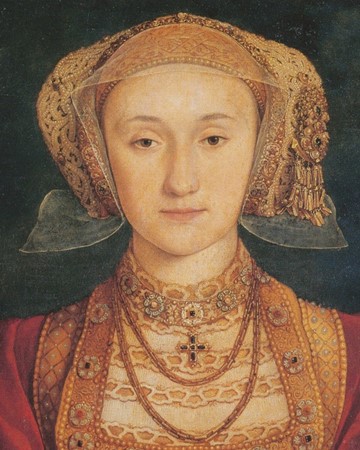 |
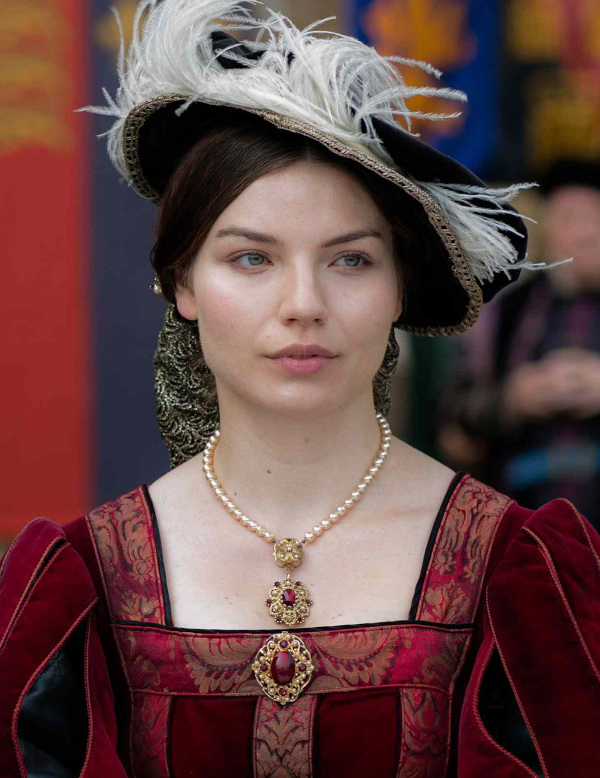 |
 |
||
| Anna of Cleves | From "Six wives" | Rebecca Dyson Smith |
Other actresses who've played Anna of Cleves:
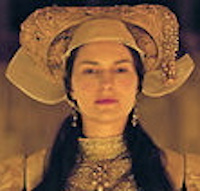 |
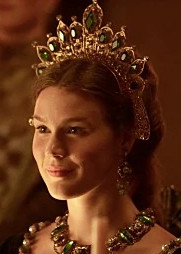 |
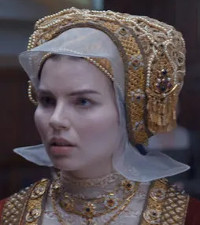 |
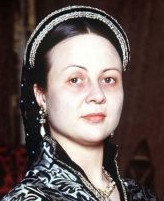 |
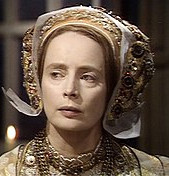 |
||
| Catherine Siggins | Joss Stone | Ann Foster | Pia Gerard | Elvi Hale |
Given the fates of Henry's first three wives, finding a fourth proved quite difficult and took two years.
Anna of Cleves' portrait (painted by Hans Holbein) was sent to King Henry for him to evaluate her as a future wife. Her brother didn't allow Holbein to paint whilst looking directly at Anna and her little sister's faces so they had to wear veils whilst being painted but Henry fell in love with her portrait and wanted her brought to him. When she arrived, he was not impressed - he complained of her not looking like her portrait. Her pre-contract of marriage with Francis I, Duke of Lorraine, was cited as grounds for annulment, even though their marriage did not proceed. Anna did not resist the annulment, claiming the marriage had not been consummated and was rewarded with a generous monetary settlement, several palaces and Hever Castle, the former home of the Boleyns - Henry's former in-laws. She was given the name "The King's Sister" and was a lifelong friend to him and his children; Anna of Cleves was approximately the same age as Henry VIII's eldest surviving daughter, Mary. She outlived the King and all his wives, dying at Chelsea Old Manor on 16 Jul 1557; the most likely cause of her death was cancer. She was buried in Westminster Abbey on 3 Aug 1557.
This Anna was Queen Consort of England, although not crowned, for just six months in 1540, from 6 Jan to 12 Jul. It's rumoured that Henry referred to her as "a Flanders mare", and the label has stuck.
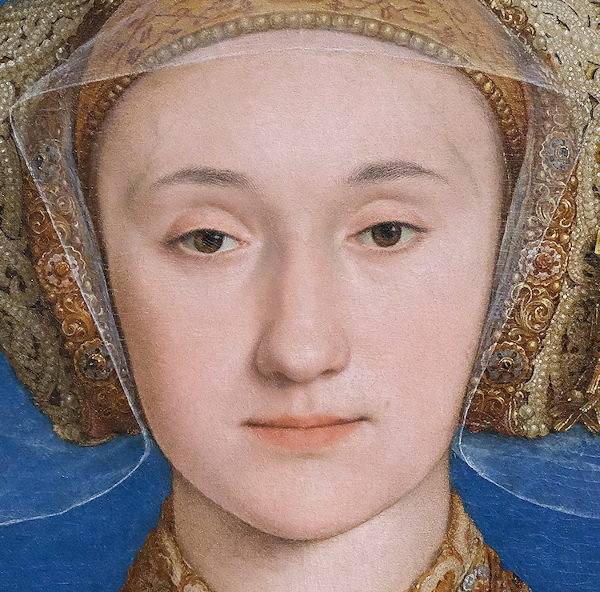 |
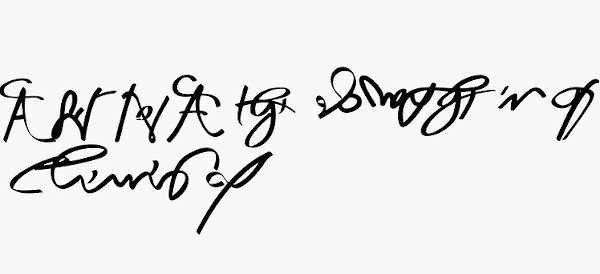 |
||
| A portrait of her | Her signature |
| ≡ | ⇧ |
No 5. Katheryn Howard
Born 1521, m.1540, died 13 Feb 1542
She was Henry's fifth wife, between 1540 and 1542.
 |
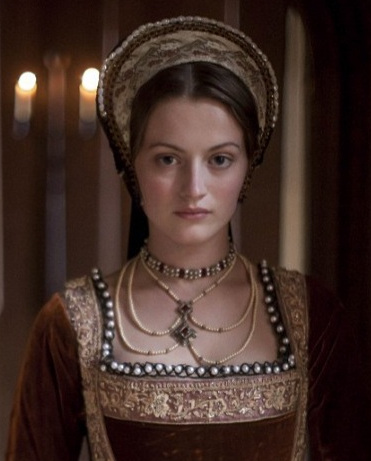 |
 |
||
| Katherine Howard | From "Six wives" | Lauren McQueen |
Other actresses who've played Katheryn Howard:
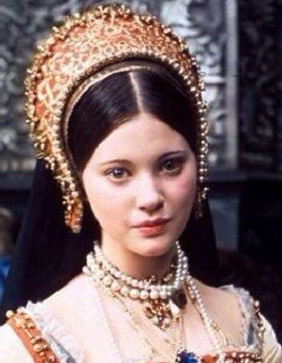 |
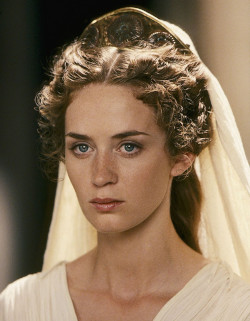 |
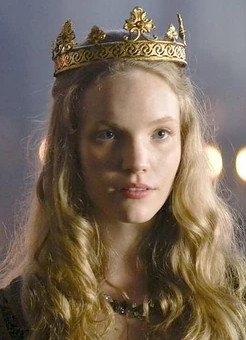 |
||
| Lynne Frederick | Emily Blunt | Tamzin Merchant |
Katheryn was the daughter of Lord Edmund Howard and Joyce (née Culpeper), cousin to Anne Boleyn (the second wife of Henry VIII), second cousin to Jane Seymour (the third wife of Henry VIII), and niece to Thomas Howard, 3rd Duke of Norfolk. She was raised in the household of her step-grandmother Agnes Tilney, the Dowager Duchess of Norfolk. Her uncle Thomas Howard was a prominent politician at Henry's court and he secured her a place in the household of Henry's fourth wife, Anna of Cleves, where Katheryn caught the King's eye. She married him on 28 Jul 1540 at Oatlands Palace near Weybridge in Surrey, just 19 days after the annulment of his marriage to Anna. He was 49 and she was still a teenager, likely around 18. (Katheryn Howard was younger than Henry VIII's oldest child, Mary I, who was 24 years old when he married his fifth wife; Elizabeth was 9 and Edward was 3.)
On 1 Nov 1541, Henry was informed of her alleged adultery with Thomas Culpeper (her distant cousin), Henry Mannox (who had given her private music lessons while she lived with her step-grandmother) and Francis Dereham (a previous boyfriend from her teenage years). Katheryn was stripped of her title as Queen in Nov 1541 and was beheaded in Feb 1542 on the grounds of treason for committing adultery.
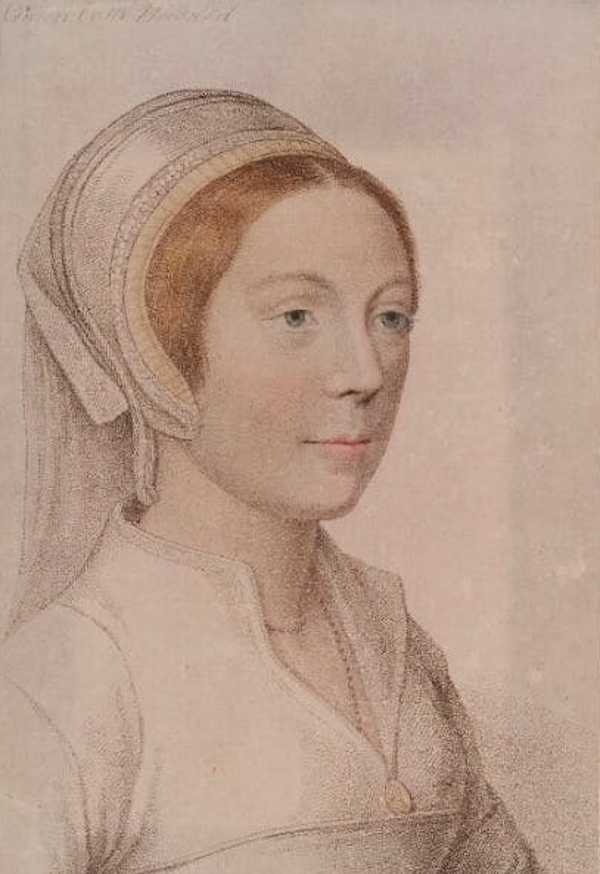 |
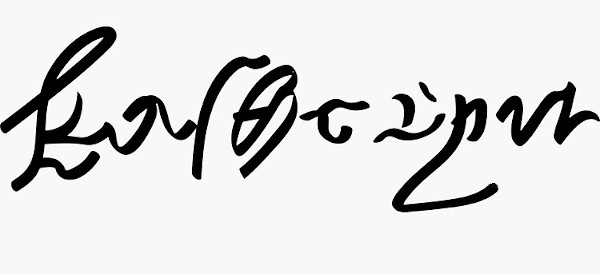 |
||
| A sketch of her by Holbein | Her signature |
| ≡ | ⇧ |
No 6. Kateryn Parr
Born ~1508/9, m.1529, 1534, 1543 & 1547, died 5 Sep 1548
She was the sixth and last wife of Henry VIII, 1543–1547.
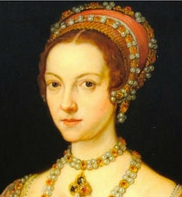 |
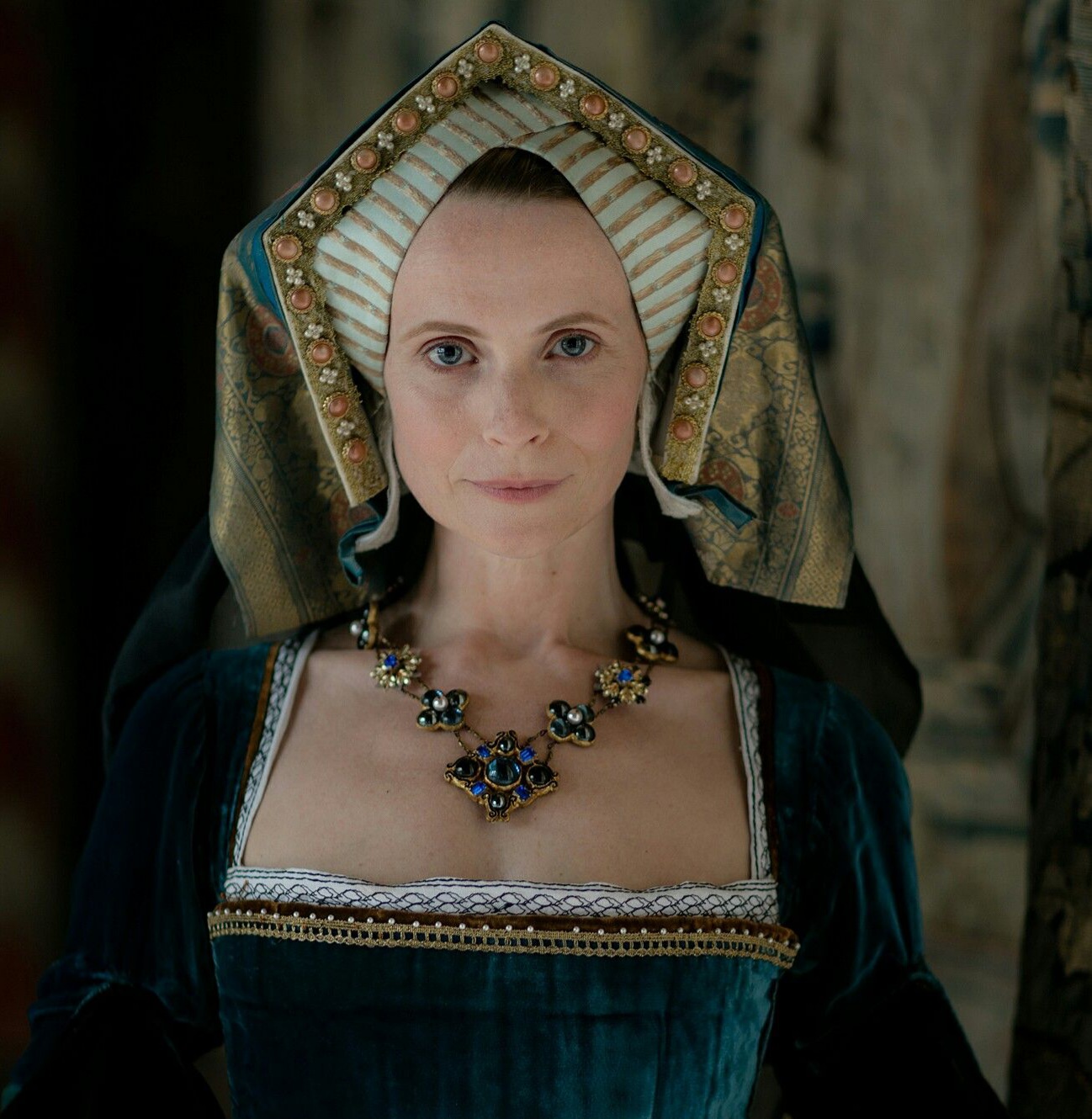 |
 |
||
| Kateryn Parr | From "Six wives" | Alice Patten |
Other actresses who've played Kateryn Parr:
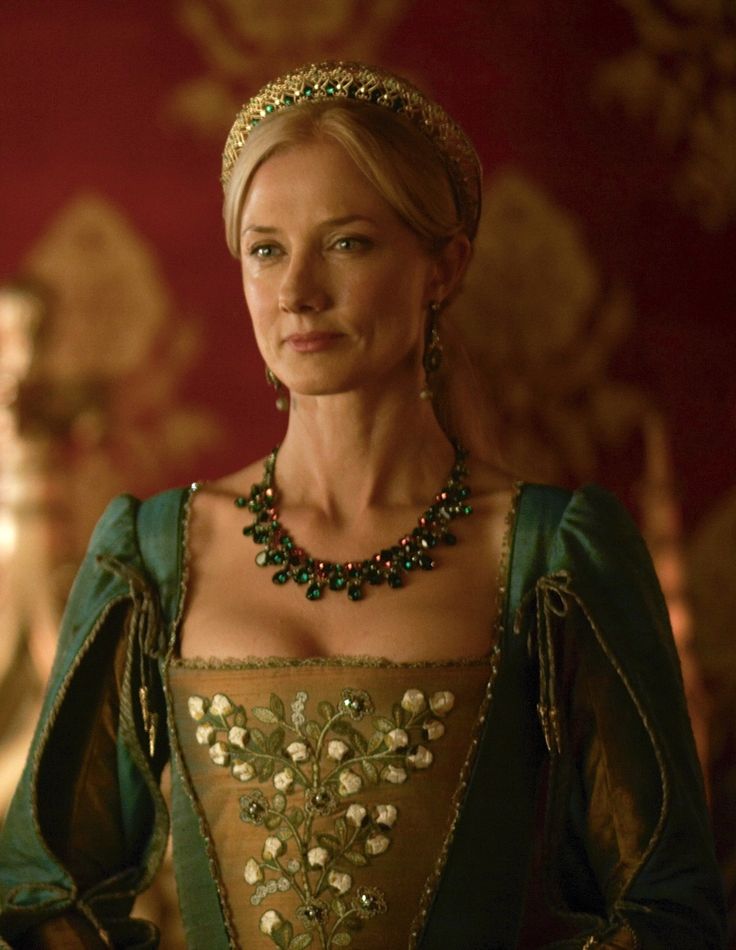 |
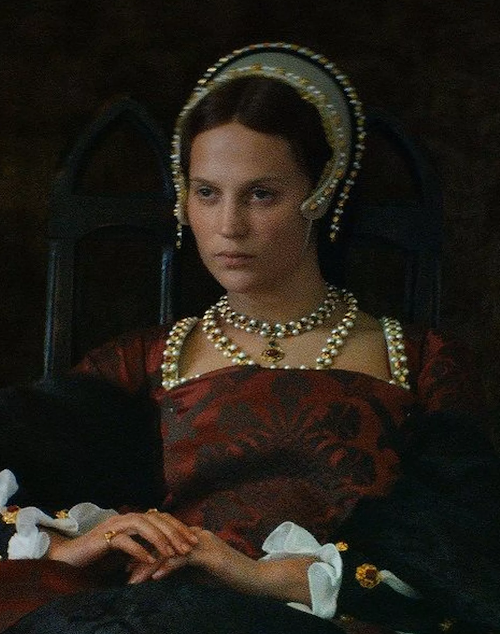 |
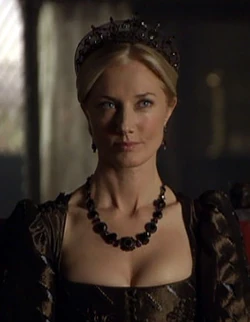 |
||
| Joely Richardson | Alicia Vikander | Michelle Williams |
Kateryn was the daughter of Sir Thomas Parr of Kendal and his wife Maud (née Green). Through her father, Kateryn was a descendant of John of Gaunt, son of King Edward III. Through John of Gaunt's daughter Joan Beaufort, Countess of Westmoreland (Henry's great-great-grandmother), she was Henry's third cousin, once removed. By Henry's paternal descent from another of John of Gaunt's children, John Beaufort, 1st Earl of Somerset, the two were also fourth cousins once removed.
Kateryn showed herself to be the restorer of Henry's court as a family home for his children. She was determined to present the royal household as a close-knit one to demonstrate strength through unity to Henry's detractors. But perhaps Kateryn's most significant achievement was to get Henry to pass an act that confirmed both Mary's and Elizabeth's line in succession for the throne, despite the fact that they had both been made illegitimate by annulment or remarriage. At the time of the passage of the act, Kateryn Parr was 31, Mary was 27, Elizabeth was 10, Edward was 9 and Henry was 52. Such was Henry's trust in Kateryn that he chose her to rule as Regent while he was attending to the war in France, and in the unlikely event of the loss of his life, she was to serve as Regent until Edward came of age.
Kateryn also has a special place in history, as she was the most married Queen of England, having had four husbands in all; Henry was her third. Before marrying Henry, she was married to Edward Burgh in 1529 and John Neville in 1534. After Henry's death, she married Thomas Seymour in 1547, uncle of Edward VI of England, to whom she had formed an attachment before her marriage with Henry. She had one child with Seymour, Mary, and died shortly after childbirth aged 35 or 36. That daughter, Lady Mary's, history is unknown but she is not believed to have survived childhood. She (Kateryn) is buried at Sudeley Castle in the town of Winchcombe.
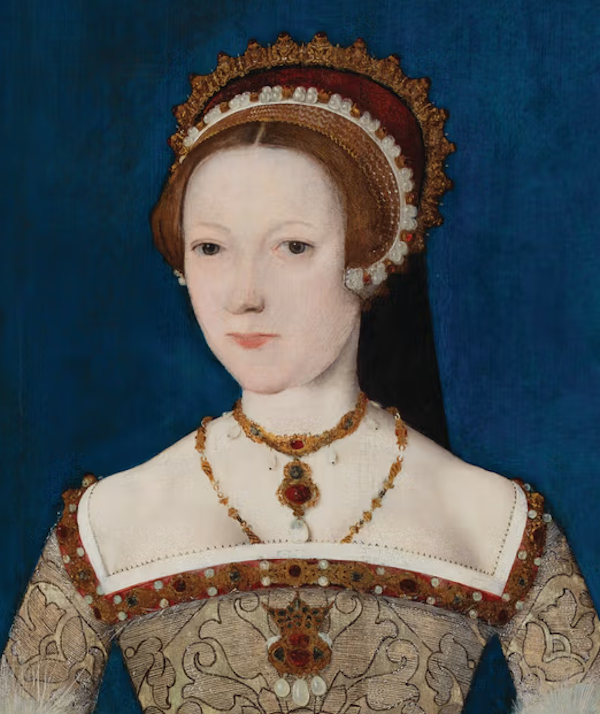 |
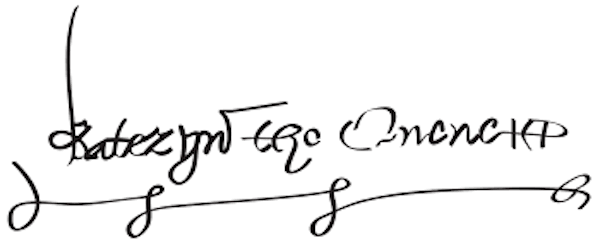 |
||
| A portrait of her (NPG 4451) |
Her signature |
| ≡ | ⇧ |
No 7. Katherine Brandon (née Willoughby)
(Born 22 Mar 1519, married 1533, died 19 Sep 1580)
There is often talk of Henry possibly marrying her but there is absolutely no evidence for this and the window for doing it was quite narrow being between Katheryn Howard's death in 1542 and his own in 1547.
He was a very unattractive man by that time and Katherine actually married Richard Bertie in 1553.
| ≡ | ⇧ |
Henry VIII main mistresses
Elizabeth 'Bessie' Blount
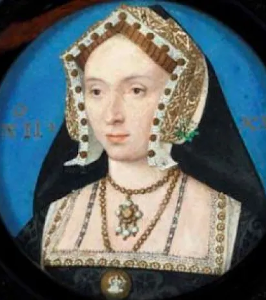 |
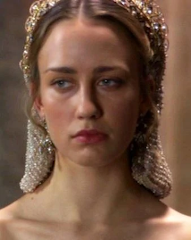 |
||
| Bessie Blount | Ruta Gedmintas |
Before marrying Anne Boleyn (one of Katherine of Aragón's ladies in waiting) Henry had had an extra-marital affair with "Bessie" Blount (another of Katherine's ladies in waiting) and she gave birth to Henry's only acknowledged, illegitimate, child Henry Fitzroy in 1519. King Henry soon dumped her after the child was born and he lusted after Mary Boleyn, the 'other Boleyn girl'. His son with Bessie, Henry Fitzroy, died of some strange illness (probably TB) in 1536. She, however, made a later return to court and became lady in waiting to Anna of Cleves! By 1540, she had died of TB (or the birth of her 3rd child Margaret - it's thought she'd had a 2nd child, Elizabeth, in 1519 or 1520).
Mary Boleyn
 |
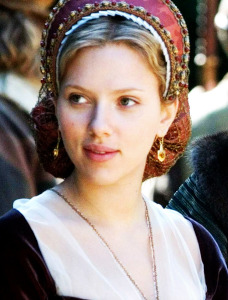 |
||
| Mary Boleyn | Scarlett Johansson |
Mary was Anne Boleyn's sister. It was rumoured that one or both of Mary's children (Catherine and Henry) were fathered by the King, although no evidence exists to support the argument that either of them was the King's biological child. Mary is often considered to be Henry's favourite mistress
'Madge' Shelton
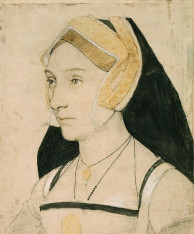 |
 |
||
| 'Madge' Shelton | Laura Jane Laughlin |
It's not entirely clear who Madge Shelton was. There were several (it is thought 10) Shelton siblings (nieces of Anne Boleyn's father Thomas) of whom Madge and Mary are the most prominent. In the 16th century, 'g' and 'y' were barely distinguishable so Miss Shelton could have been either Marg or Mary. Whichever one it was, according to Imperial ambassador Eustace Chapuys, the King had an affair with 'Mistress Shelton' in Feb 1535, for around around six months.
In addition, Henry was involved in a romantic relationship with three of the future queens before he married them. It is unclear if these relationships became sexual before marriage. He was involved with his second wife, Anne Boleyn, from around 1526, roughly when he ended his relationship with her sister, Mary; Anne was also, at the time, maid-of-honour to his first wife, Katherine of Aragón. Anne was referred to by some as "the king's whore" or a "naughty paike [prostitute]". Henry and Anne's daughter, Elizabeth I, was born (7 Sep 1533) less than eight months after their 'official' marriage on 25 Jan 1533.
From the beginning of 1536, while still married to Anne Boleyn, he was openly courting his wife's second cousin and maid-of-honour, Jane Seymour. In 1540, he began courting Katheryn Howard, the maid-of-honour of his fourth spouse, Anna of Cleves. Katheryn was a first cousin of Anne and Mary Boleyn.
"But ... after all the efforts that Henry's six wives made to give him a son, young King Edward would only rule for six years before he too died. So Henry's daughters then became Queens - first Mary born to Katherine of Aragón and then Elizabeth born to Anne Boleyn. Queen Elizabeth I would rule England for 44 years ...
Isn't it ironic that, despite the infidelities and despite the miscarriages and the divorces and the beheadings, despite all that drama that the 6 Queens endured to try to give Henry a male heir, in the end, the Tudor dynasty was secured by a woman".
| ≡ | ⇧ |
After Henry VIII
Knowing that his son Edward might succeed him whilst still young, Henry had named, in his will, sixteen executors who were to form a Regency council, along with twelve assistants, until Edward VI came of age. One of the executors, Sir Edward Seymour (by then Earl of Hertford), had not been appointed Lord Protector by Henry VIII directly. The plan was that the council would rule collectively with every member having equal power and rights. However, the will also allowed the executors to grant themselves lands and honours, so Edward took advantage of this and made himself Duke of Somerset and Lord Protector of his nephew's council, with the agreement of 13 out of the 16 executors.
Edward Seymour (now called Somerset) went on to rule by proclamation, making all of the decisions himself. He is famous for consolidating the Protestant Reformation in England, repealing Henry VIII’s heresy laws and overseeing the production of the first Book of Common Prayer, which offered a compromise between Roman Catholic and Protestant learning. But he also lost the confidence of the nobility when Kett's Rebellion started up and tenant farmers started to take down enclosure fences. Somerset attempted to aid the rural poor by forbidding enclosures (the taking of arable common land by the propertied classes to use as pasture) and it was this that led to his downfall.
In the summer of 1547, Somerset had invaded Scotland and won the battle of Pinkie Cleugh on 10 Sep. During his absence from the court, his brother, Thomas, stirred up opposition to his authority, voicing open disapproval of his brother's administrative skills. Because his activities seemed suspicious, several members of the nobility advised him to be content with his position, but he would not listen.
By virtue of her marriage to the King, Kateryn Parr was extremely wealthy and, when Henry died, Thomas Seymour married her. Despite now being very wealthy and of high status, Thomas still couldn't come to terms with his brother's appointment as protector; and in his struggle with Somerset, he tried to ingratiate himself with the king, who was merely a child. He wanted the 9-year-old Edward to write a letter on his behalf in support of his marriage to Kateryn. The letter was obviously dictated by Thomas for Edward's signature and that enraged Somerset. Thomas began to visit King Edward frequently, secretly giving him an extravagant allowance of coins, so that King Edward might be satisfied in feeling more grown-up and more king-like, giving gifts to his servants, teachers, and friends. Even though King Edward lived in sumptuous splendour and wanted for nothing, no provisions had been made for his pocket money; he became accustomed to these regular payments and began to ask Seymour freely for his allowance.
Thomas meanwhile had begun flirting with Princess Elizabeth.
When Kateryn was pregnant in the spring of 1548, she had become concerned enough about her husband's flirtatious relationship with Elizabeth that she sent Elizabeth away to live with Anthony Denny and his wife, Joan Champernowne (Kat Ashley's sister), in Hertfordshire.
In Jun 1548, Kateryn and Thomas moved their own household from London to Sudeley Castle in Gloucestershire, the property granted to Seymour when he became Baron Seymour of Sudeley. On 30 Aug 1548, Kateryn gave birth to a daughter, Mary Seymour but, in the following days, Kateryn became uncharacteristically hostile and delusional. Thomas lay in bed with her to calm her, but she did not get better and she died on 5 Sep 1548 from childbirth complications, just before Elizabeth's 15th birthday on the 7th. Thomas said he was "amazed" at Kateryn's death but it did open up new opportunities for him, as his eye returned to Elizabeth. She avoided him, returning with her governess to her childhood home, Hatfield House in Hertfordshire.
Thomas continued his manipulation of the king. In trying to get a bill through Parliament making him King Edward's personal governor, Thomas requested Edward's royal signature on the bill. But Edward was uncertain about it and was reluctant to go behind the back of the protector, Somerset, and of the Regency council ‐ he wouldn't sign it. Seymour persistently pressured Edward, until Edward felt threatened. But Seymour did not give up. He tried to persuade Edward that he didn't need a protector. Seymour intended that the king's royal signature and personal support would destabilize Somerset's position as both protector and as a member of the Regency council. In his frustration and inability to gain any significant influence over the king, Thomas Seymour began to think in terms of open rebellion.
As Lord High Admiral, he was able to control the English navy, and he openly asked for support in case of a rebellion. He entered into relations with pirates on the western coasts, whom it was his duty as Lord High Admiral to suppress, with a view to securing their support. Thomas seems also to have hoped to finance a rebellion through crooked dealings with the vice-treasurer of the Bristol Mint, Sir William Sharington.
In 1548, the Regency council was becoming aware of Thomas's bid for power. On the night of 16 Jan 1549, Thomas Seymour was caught trying to break into the King's apartments at Hampton Court. He entered the privy garden and woke one of the King's pet spaniels. In response to the dog's barking, he shot and killed it. The next day, he was arrested and sent to the Tower of London. The incident (that of being caught outside the king's bedroom, at night, with a loaded pistol) was interpreted in the most menacing light, even casting suspicion on Elizabeth's involvement with Thomas. On 18 Jan 1549, the council sent agents to question everyone associated with Thomas, including Elizabeth. On 22 Feb 1549, the council officially accused him of thirty-three charges of treason. He was convicted of treason, condemned to death and executed on 20 Mar 1549. Elizabeth was totally absolved of any wrong-doing.
Meanwhile, Edward Seymour, Somerset, was getting too big for his boots. On 11 Oct 1549, King Edward had him arrested and brought in front of him. The King summarised his charges as
“ambition, vainglory, entering into rash wars in mine youth, negligent looking on Newhaven, enriching himself of my treasure, following his own opinion, and doing all by his own authority, etc”.
Somerset's downfall was the result of widespread social unrest in England, such as the Prayer Book Rebellion in the South West in 1549, something for which the rest of the council blamed him. After his arrest, Somerset was succeeded as the leader of Edward VI's council by John Dudley, the Earl of Warwick, and although he (Somerset) was later released and restored to a place on the council, he plotted to overthrow Dudley so was arrested and executed on the 22 Jan 1552.
In April 1552, King Edward got measles and smallpox soon afterwards. Measles is known to reduce the immune system and, on 6 Jul 1553, he died of what was probably TB.
After King Edward's death, Lady Jane Grey was proclaimed Queen on 10 Jul 1553 and waited in the Tower of London for her coronation. But support for Mary grew quickly and most of Jane's supporters abandoned her. The Privy Council of England suddenly changed sides and proclaimed Mary as Queen on 19 Jul 1553, deposing Jane. Her primary supporter, her father-in-law, the Duke of Northumberland, was accused of treason and executed less than a month later. Jane was held prisoner in the Tower and, in Nov 1553, she was convicted of high treason and sentenced to death.
Mary initially spared her life; but Lady Jane soon became viewed as a threat to the Crown when her father, Henry Grey, 1st Duke of Suffolk, became involved with Wyatt's rebellion against Queen Mary's intention to marry Philip of Spain. Jane and her husband (Lord Guildford Dudley) were executed on 12 Feb 1554. At the time of her death, Jane was either 16 or 17 years old.
Mary ruled until her death, probably from cancer, on 17 Nov 1558 when Elizabeth became Queen.
When Elizabeth died on 24 Mar 1603 and because neither she, Mary nor Edward VI had had any children, James VI of Scotland became James I of England. He was the son of Mary Queen of Scots and therefore Henry VII's great-great-grandson.
On 1 Jul 1543, the Treaties of Greenwich had been signed between England and Scotland. Among the terms of the treaties was the agreement of a marriage between Prince Edward aged 5½ (b.12 Oct 1537), the future King Edward VI, and Mary aged 7 months (b.8 Dec 1542), the future Mary Queen of Scots. But, in the end, it was not to be.
| Key dates | ||
| Jane Seymour married Henry VIII | 30 May 1536 | |
| Edward VI born | 12 Oct 1537 | |
| Jane Seymour died | 24 Oct 1537 | |
| Henry VIII died | 28 Jan 1547 | |
| Edward VI succeeded Henry | 28 Jan 1547 | |
| Kateryn Parr died | 05 Sep 1548 | |
| Thomas Seymour executed | 20 Mar 1549 | |
| Edward Seymour executed | 22 Jan 1552 | |
| Edward VI died | 06 Jul 1553 | |
| Lady Jane Grey proclaimed Queen | 10 Jul 1553 | |
| Mary proclaimed Queen | 19 Jul 1553 | |
| Lady Jane Grey sentenced to death | 14 Nov 1553 | |
| Lady Jane Grey & Guildford Dudley executed | 12 Feb 1554 |
| ≡ | ⇧ |
Timeline
| 16.12.1485 | Katherine of Aragón born |
| 28.06.1491 | Henry VIII born |
| ~1501 | Anne Boleyn born |
| ~1508 | Jane Seymour born |
| 22.04.1509 | Henry became King |
| 11.06.1509 | Katherine of Aragón married (for 24 years) |
| ~1512 | Kateryn Parr born |
| 22.09.1515 | Anna of Cleves born |
| 18.02.1516 | Mary I born |
| 18.02.1519 | Henry Fitzroy, born to Bessie Blount |
| ~1524 | Katheryn Howard born |
| 1524 | Catherine, born to Mary Boleyn |
| 1526 | Henry, born to Mary Boleyn |
| 23.05.1533 | Katherine of Aragón's marriage annulled |
| 25.01.1533 | Anne Boleyn married (for 3 years) |
| 07.09.1533 | Elizabeth I born |
| 07.01.1536 | Katherine of Aragón died |
| 19.05.1536 | Anne Boleyn beheaded |
| 30.05.1536 | Jane Seymour married (for 2 years) |
| 12.10.1537 | Edward VI born |
| 24.10.1537 | Jane Seymour died |
| ~1540 | Anna of Cleves married (divorced within months) |
| ~1540 | Katheryn Howard married (for 2 years) |
| 13.02.1542 | Katheryn Howard died |
| 12.07.1543 | Kateryn Parr married |
| 15.01.1547 | Henry VIII died and was buried next to Jane Seymour at St.G. Windsor. |
| 28.01.1547 | Edward VI became King (until 1553) |
| 05.09.1548 | Kateryn Parr died |
| 07.1553 | Mary I became Queen (until 1558) |
| 16.07.1557 | Anna of Cleves died |
| 17.11.1558 | Elizabeth I became Queen (until 1603) |
| Henry born in 1491 Wife | Wife born in | Henry's age at wife's birth | Year of marriage | Henry's age at marriage | Wife's age at marriage |
| Katherine of Aragón | 1485 | -6 | 1509 | 18 | 24 |
| Anne Boleyn | 1501 | 10 | 1533 | 42 | 32 |
| Jane Seymour | 1508 | 17 | 1536 | 45 | 28 |
| Anna of Cleves | 1515 | 24 | 1540 | 49 | 25 |
| Katheryn Howard | 1524 | 33 | 1540 | 49 | 16 |
| Kateryn Parr | 1512 | 21 | 1543 | 52 | 31 |

| ≡ | ⇧ |
Relationships to Edward I
| ≡ | ⇧ |
Edward VI
| Son of | Henry VIII & Jane Seymour |
| Born | 12 Oct 1537 |
| Died | 6 Jul 1553 |
| Reigned | 28 Jan 1547 - 19 Jul 1553 |
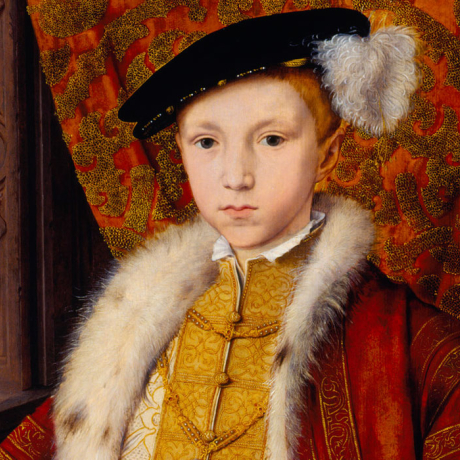
King Edward VI
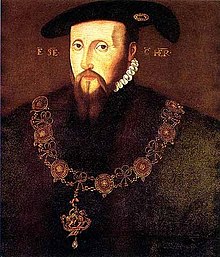
Edward Seymour, Duke of Somerset
and Lord Protector
(wearing the Order of the Garter)
 Kateryn Parr |
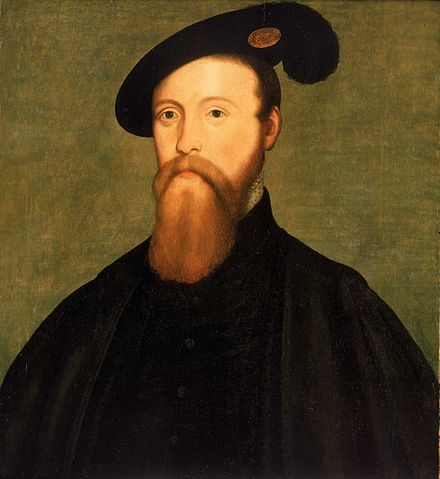 Thomas Seymour |
| ≡ | ⇧ |
Lady Jane Dudley (née Grey)
| Dau. of | Henry Grey, 3rd Marquis of Dorset & Lady Frances Brandon, Duchess of Suffolk |
| Born | Autumn 1537 |
| Died | 12 Feb 1554 |
| Reigned | 28 Jan 1547 - 19 Jul 1553 |
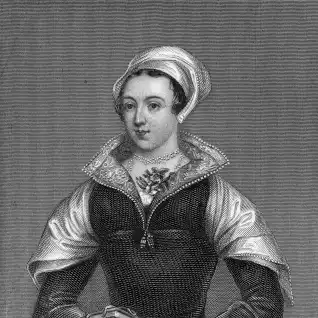
Queen Jane
The Duke of Northumberland, however, had persuaded the sickly Edward to name Lady Jane Grey as his heir just before his death and, as one of Henry VIII's great-nieces, the young girl was a genuine claimant to the throne. Northumberland then married his own son, Lord Guildford Dudley, to Lady Jane.
Jane assumed the throne as Queen Jane (aged only 15) and her claim was recognised by the Privy Council on 10 July in London. Despite this, the country rallied behind Mary, Katherine of Aragón's daughter and a devout Roman Catholic.
The following week saw Jane's supporters dwindle and Mary's supporters grew enormously so that she had a huge number of followers, all armed. Eventually, the Privy Council saw their positions in danger and they switched sides to support Mary instead of Jane. But Jane's demise did not come because of large-scale forces in the country rallying behind Mary, as is often thought, but from a wavering Privy Council switching its allegiance to Mary during Northumberland's absence on the campaign against her.
Mary moved from Norfolk, where she had been building forces, to London. She deposed Jane on 19 July 1553 and imprisoned her in the Tower. On 13 Nov, Jane was found guilty of treason but Mary was reluctant to kill her at first (because of her youth and relative innocence) but later, it seemed dangerous for Mary to leave the innocent Jane alive as she proved too much of a threat as the focus of Protestant plotters (The Wyatt Rebellion supported by her father) intent on replacing Mary so Jane was executed on Tower Green, together with her husband, on 12 February 1554.
Jane's father (Henry Grey, Duke of Suffolk) was involved in Wyatt's attempt to overthrow Mary when she married King Philip II of Spain (Wyatt's Rebellion) so Mary had him executed on 23 February 1554.
During her marriage to Philip she was, theoretically, Queen of England and Spain!
| ≡ | ⇧ |
Mary I - 'Bloody' Mary
This is Henry's eldest daughter, who married King Philip II of Spain, notMary Tudor, Henry's younger sister who married King Louis XII of France in Oct 1514,
followed by Charles Brandon, 1st Duke of Suffolk in May 1515.
| Dau. of | Henry VIII & Katherine of Aragón (marriage annulled) |
| Born | 18 Feb 1516 |
| Died | 17 Nov 1558 |
| Reigned | 19 Jul 1553 - 17 Nov 1558 |
| Married | 9 Oct 1514, Phillip II of Spain (he died on 1 Jan 1515) |
| Married | 13 May 1515, Charles Brandon, 1st Duke of Suffolk. |
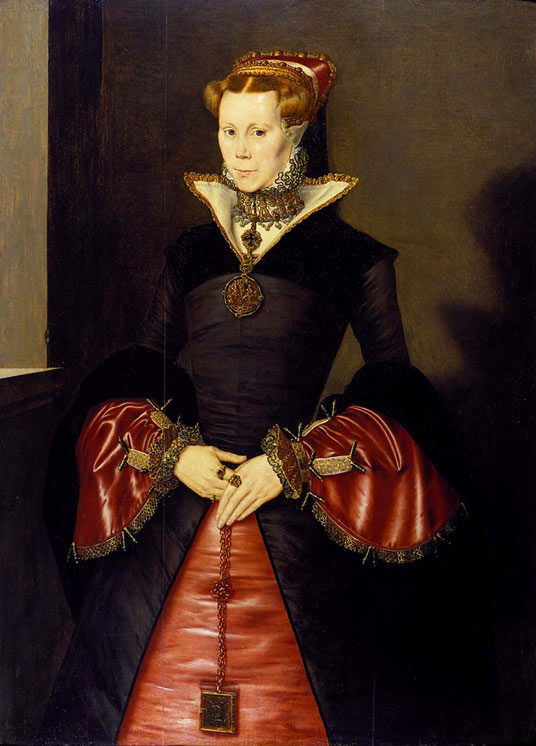
Queen Mary I
She wanted to restore England to full Catholicism after Edward Seymour's Book of Common Prayer sought to tolerate all forms of worship and, to this end, she executed many dozens of dissenting Protestants. Had she lived long enough, she might have achieved her aim but cancer of the womb shortened her life and left her childless so her half-sister Elizabeth claimed the throne.
| ≡ | ⇧ |
Elizabeth I
| Dau. of | Henry VIII & Anne Boleyn (marriage annulled & Anne beheaded) |
| Born | 7 Sep 1553 |
| Died | 24 Mar 1603 |
| Reigned | 17 Nov 1558 - 24 Mar 1603 |
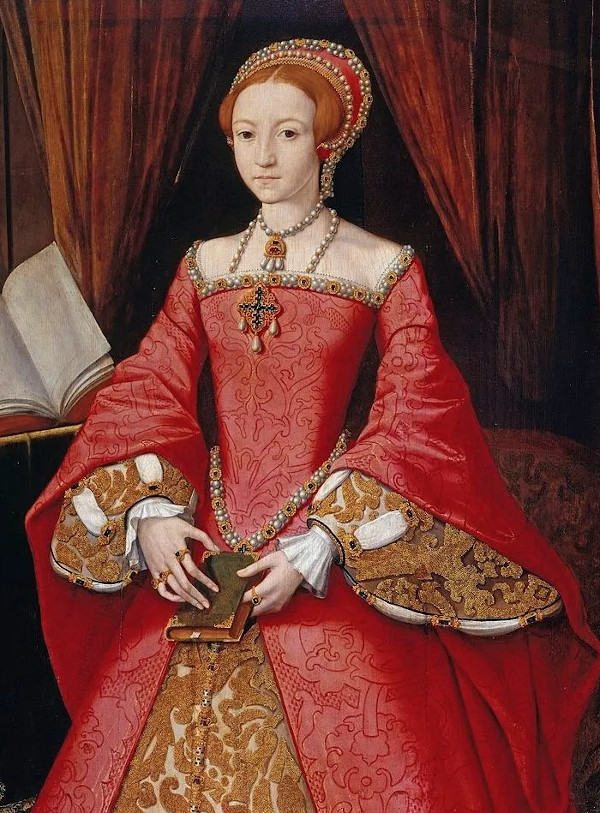 Elizabeth (aged 13) |
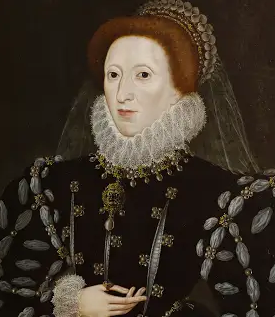 Elizabeth |
||
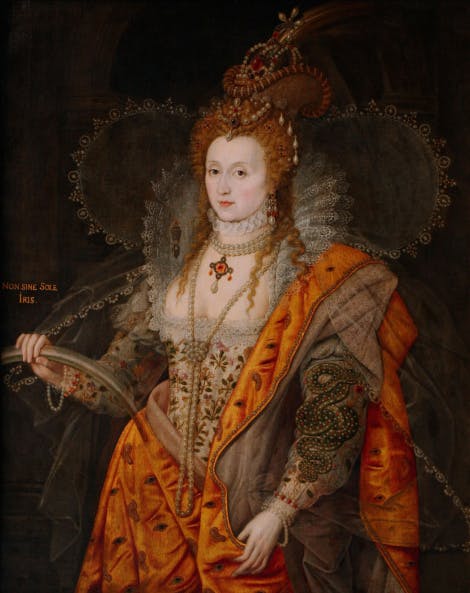 Elizabeth |
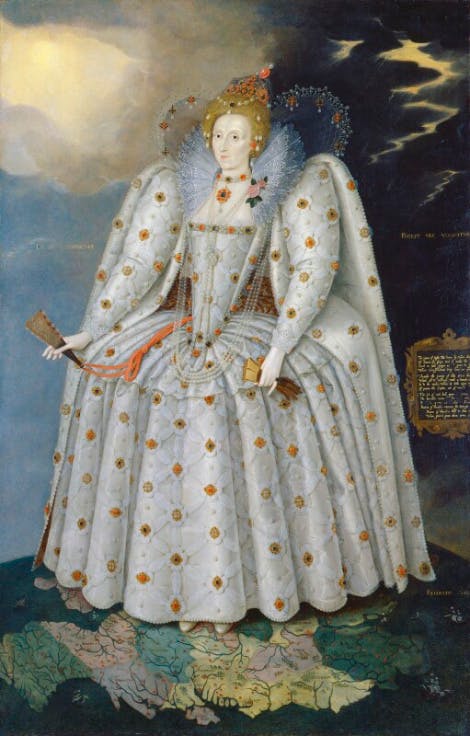 Elizabeth |
||
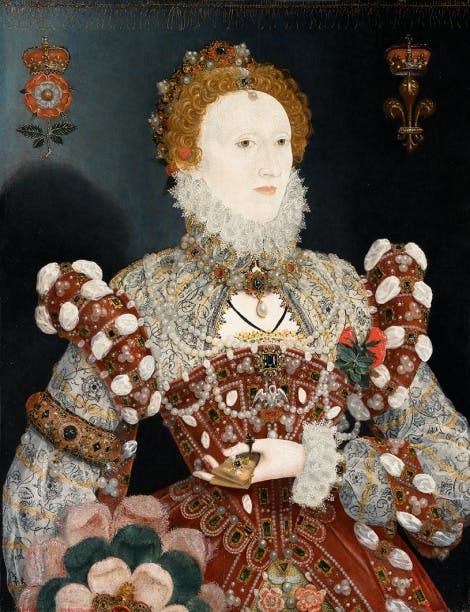 Elizabeth |
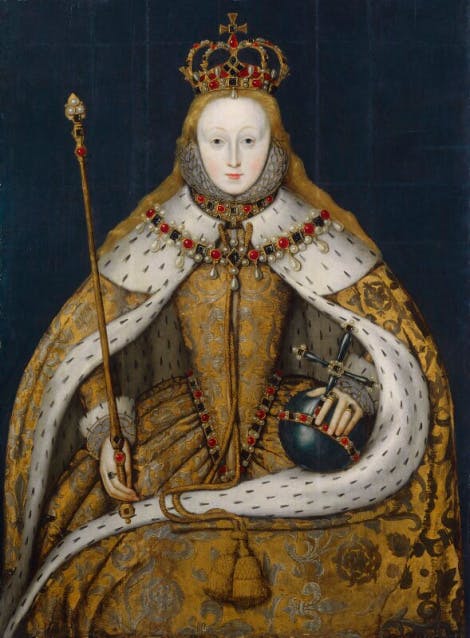 Elizabeth in old age |
||
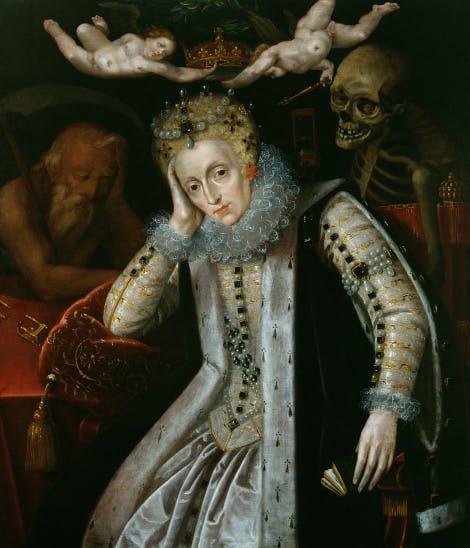 Elizabeth |
When Edward VI was born to Jane Seymour, the King cut Mary and Elizabeth off as heirs. Elizabeth was brought up by governesses until Kateryn Parr married the King and then she looked after Elizabeth and had her reinstated as a possible heir.
On 28 Jan 1547, Henry died but Elizabeth didn't look kindly on him - he'd murdered her mother, married four more women, taken mistresses, banished her from court and called her a bastard.
Kateryn went on to marry Thomas Seymour - an extremely ambitious man who now had all the wealth he could wish for - and yet he wanted more.
In 1548, Kateryn became pregmant and Thomas started leering at Elizabeth so she was sent away. On 5 Sep 1549, Kateryn had a baby girl but died soon afterwards.
On 16 Jan 1549, Thomas Seymour went to the palace to try and pursuade Edward to make him Lord Protector. In the gardens he was seen by a dog which started barking. Thomas shot the dog and guards arrested him for having a loaded gun outside the King's chambers. Sir Robert Tyrwhitt was told to question Thomas, Elizabeth and her governess. The governess was forced to sign an admission but it absolved Elizabeth of all wrong-doing.
Thomas was convicted and executed - it took two strokes of the axe to kill him.
On 1549, Edward died and the Catholic Mary I was crowned Queen. Note, Elizabeth was an early Protestant.
In Oct 1553, Mary was planning to marry Philip II of Spain whereupon he would become the Catholic ruler of England, Scotland and large parts of Europe.
In 1554, nobles tried to overthrow Mary and the Wyatt Rebellion took place. Wyatt was crushed. On 19 Mar 1554, Elizabeth was taken to the Tower and Wyatt was tortured to implicate the Queen but he refused. As a result, Wyatt was hanged, drawn and quartered but, on 19 May 1554, Elizabeth was set free.
On 25 Jul 1554, Mary married Philip and in Nov 1554 Mary had a phantom pregnancy (and another in 1557). It is believed she had ovarian cancer and she died on 17 Nov 1558. She refused to name Elizabeth as her heir - she wanted her heir to be a king.
But, on 15 Jan 1559, Elizabeth was crowned Queen Elizabeth I.
Protestants and Catholics were at war in Europe and ministers wanted Elizabeth to marry but she knew that would reduce her power.
Meanwhile, Mary Queen of Scots (MQS) wanted to be Elizabeth's heir. She went to France and married Francis but, wehn he died, she went back to Scotland. If Elizabeth named MQS as her heir, England would revert to Catholicism. MQS was offered the crown in England if she guanteed to marry and English noble and not a foreiger and Elizabeth suggested Robert Dudley. But, in 1560, Dudley's wife died and Elizabeth was implicated. In Nov 1564, the negotiations between Elizabeth and MQS fizzled out. At the end of 1564, the Catholic Henry Stuart, Lord Darnley arrived at court and, on 29 Jul 1567, MQS married Lord Darnley. Just under a year later, on 19 Jun 1566, James VI (later to become James I of England was born to MQS.
On 10 Feb 1567, Darnley was strangled and Elizabeth suggested that the Earl of Bothwell was behind it. On 24 Apr 1567, MQS and Bothwell ran away and married but MQS was caught and imprisoned - Elizabeth didn't rescue or condemn her but, in July, she miscarried twins and, on 24 Jul 1567, she was forced to abdicate on threat of death. Her son James was crowned King James VI of Scotland.
On 2 May 1568, MQS escaped from Lochleven Castle and rowed across the loch but was arrested and imprisoned in Carlisle Castle.
Pope Pious V rebelled and, on 25 Feb 1570, issued a Bull casting Elizabeth out and effectiving giving all Catholics a licence to attack the Queen.
Elizabeth appointed Sir Francis Walsingham as principal secretary and 'spymaster' and William Cecil as her advisor. Cecil wanted to get rid of MQS but had no proof.
By 1586, MQS had been in prison for 18 years and a plot was concocted to undermine Elizabeth but Walsingham intercepted it. In Oct 1586, MQS was found guilty but Elizabeth wouldn't sign her death warrant because she felt it immoral to kill a monarch and unreasonable to kill one cousin (MQS) to save another (Elizabeth). Eventually, she did sign but only on the condition that Spanish soldiers did appear in Wales. However, Mary was beheaded (requiring three blows of the axe) at Fotheringay on 8 Feb 1587. Elizabeth raged at Cecil for indirectly forcing her to 'cross a line'.
In 1585, Philip II had been asked by the pope to invade England. In Feb 1587, 130 Spanish ships and 300 smaller boats brought 26,000 men across the channel to Cornwall and from the Netherlands to the South coats to drop another 18,000 men. On 12 Jul 1588 the ships left Lisbon for Cornwall. On 29 Jul 1588, Drake left Plymouth with 34 much lighter ships to fight. Drake sent fireships into the midst of the Spanish to cause chaos. His ships were also more manoeuvrable so that, in 12 days, they beat the Armada which lost 60 ships and 18,000 men. Drake lost no ships.
On 18 Aug 1588, Elizabeth went to Tilbury to rally the men - she gave the speech of her life
We have been persuaded by some that are careful of our safety, to take heed how we commit our selves to armed multitudes, for fear of treachery; but I assure you I do not desire to live to distrust my faithful and loving people. Let tyrants fear. I have always so behaved myself that, under God, I have placed my chiefest strength and safeguard in the loyal hearts and good-will of my subjects; and therefore I am come amongst you, as you see, at this time, not for my recreation and disport, but being resolved, in the midst and heat of the battle, to live and die amongst you all; to lay down for my God, and for my kingdom, and my people, my honour and my blood, even in the dust.
I know I have the body but of a weak, feeble woman; but I have the heart and stomach of a king, and of a king of England too, and think foul scorn that Parma or Spain, or any prince of Europe, should dare to invade the borders of my realm; to which rather than any dishonour shall grow by me, I myself will take up arms, I myself will be your general, judge, and rewarder of every one of your virtues in the field.
I know already, for your forwardness you have deserved rewards and crowns; and we do assure you on a word of a prince, they shall be duly paid. In the mean time, my lieutenant general shall be in my stead, than whom never prince commanded a more noble or worthy subject; not doubting but by your obedience to my general, by your concord in the camp, and your valour in the field, we shall shortly have a famous victory over these enemies of my God, of my kingdom, and of my people.”.
She became loved and very popular; the people felt that Protestants were supported by God.
The Earl of Essex was appointed Privy Councillor - Elizabeth adored him. In Jul 1598, there was a Catholic uprising in Ireland; Essex refused to go to Ireland. In Aug 1598 William Cecil died and the uprising in Ireland had escalated. Elizabeth needed a leader and Essex was allowed to go to prove himself. Essex lost 11,000 men in two months and totally failed. He decided to meet Tyrone to negotiate a peace. That failed too. He planned to attack Westminster and force the Queen to recant. Londoners wouldn't support him. Essex ran for his life. Elizabeth ordered his house to be shelled to rubble. Eventually, Essex surrendered and, on 25 Feb 1601, he was beheaded.
On 24 Mar 1603, Elizabeth fell quite ill and was asked to name her heir. She named James VI of Scotland.
Later that day, she died and he became James I of England thus uniting England and Scotland.
| ≡ | ⇧ |
James I
| Son of | Mary Queen of Scots & Henry Stuart, Lord Darnley |
| Line | Henry VII > Margaret = James IV > James IV = Mary of Guise > Mary Queen of Scots = Henry Stuart |
| Born | 19 Jun 1566 |
| Died | 27 Mar 1625 |
| Reigned | 24 Jul 1567 - 27 Mar 1625, James VI of Scotland |
| 24 Mar 1603 - 27 Mar 1625, James I of England | |
| Married | 1589, Anne of Denmark |
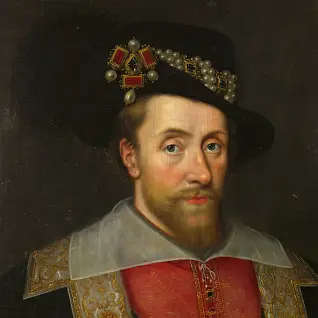
King James I
He and Anna had numerous children, three of whom survived infancy. Henry, who died after a short illness in 1612, Charles who was to succeed James as King Charles I, and Elizabeth, who married Frederick, elector of Palatine, and the swiftly deposed King of Bohemia. Romantically she has become known as the Winter Queen.
Of his many achievements, perhaps the most significant of all was his careful management of his peaceful succession to the English throne in 1603. In doing so, he brought the “auld enemies”, the kingdoms of Scotland and England, together under the kingship of one monarch. This dynastic union became known as the “Union of the Crowns”, which included that of Ireland too. In 1604, James proclaimed himself King of Great Britain. So James's reign produced the first Anglo-Scottish union (though this was not full political union). This helped to form the background to the formal union of 1707.
| ≡ | ⇧ |
Charles I
| Son of | James I & Anne of Denmark |
| Born | 19 Nov 1600 |
| Died | 30 Jan 1649 |
| Reigned | 27 Mar 1625 - 30 Jan 1649 |
| Married | 1625, Henrietta Maria of France |
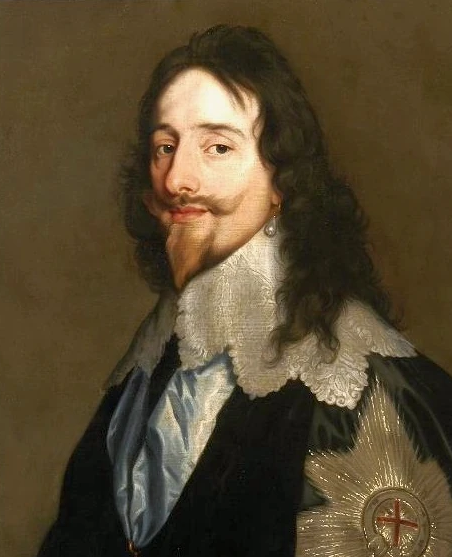
King Charles I
Charles I dissolved parliament three times during his reign and attempted to rule alone. This forced him to raise revenue by non-parliamentary means which was fiercely unpopular. In 1649, the High Court of Justice declared Charles guilty of attempting to:
“Uphold in himself an unlimited and tyrannical power to rule according to his will and to overthrow the rights and liberties of the people”.
He was sentenced to death by beheading.
The first Parliament or “Useless Parliament” sat only from June until August 1625. It gained its name because it transacted no significant business.
The second Parliament of the reign proved even more critical of the king’s government. To prevent the Commons from blaming Buckingham for the failed expedition to Cádiz, Charles dissolved Parliament. Largely through the incompetence of Buckingham, the country now became involved in a war with France as well as with Spain and, in desperate need of funds, the king imposed a forced loan, which his judges declared illegal. He dismissed the chief justice and ordered the arrest of more than 70 knights and gentlemen who refused to contribute. His high-handed actions added to the sense of grievance that was widely discussed in the next Parliament. By the time Charles’s third Parliament met, Buckingham’s expedition to aid the French Protestants had been decisively repelled and the king’s government was thoroughly discredited. The House of Commons at once passed resolutions condemning arbitrary taxation and arbitrary imprisonment and then set out its complaints in the Petition of Right, which sought recognition of four principles — no taxes without consent of Parliament; no imprisonment without cause; no quartering of soldiers on subjects; no martial law in peacetime. The king was compelled to give his formal consent.
By the time the fourth Parliament met, Buckingham had been assassinated. The House of Commons now objected both to the revival of “popish practices” and to the levying of tonnage and poundage without its consent. The king ordered the adjournment of Parliament in 1629 but, before that, three resolutions were passed condemning the king’s conduct. Charles realized that such behaviour was revolutionary.
For the next 11 years he ruled his kingdom without calling a Parliament. On the whole, the kingdom seems to have enjoyed some degree of prosperity until 1639, when Charles became involved in a war against the Scots.
There was huge disagreement with Scotland on church rue and Parliament — later known as the Short Parliament — met in April 1640 to raise money for the war against Scotland. The House was opposed to a renewal of the war so the king dissolved Parliament again. The collection of ship money was continued and so was the war. A Scottish army crossed the border in August and the king’s troops panicked. Charles, deeply perturbed at his second defeat, summoned another Parliament - the Long Parliament - which met in Nov 1640.
The new House of Commons, proving to be just as uncooperative as the last but the king adopted a conciliatory attitude — he agreed to the Triennial Act that ensured the meeting of Parliament once every three years.
He was also forced to agree that the existing Parliament could not be dissolved without its own consent.
Meanwhile, Parliament reassembled in London after a recess, and, on November 22, 1641, the Commons passed the Grand Remonstrance to the king, setting out all that had gone wrong since his accession.
A lull followed, during which both Royalists and Parliamentarians enlisted troops and collected arms. By July both sides were urgently making ready for war. The king formally raised the royal standard at Nottingham on August 22 and sporadic fighting soon broke out all over the kingdom.
At Edgehill Charles said:
On 14-Jun1645 the highly disciplined and professionally led New Model Army organized and commanded by Sir Thomas Fairfax with Oliver Cromwell as his second in command, defeated the king and Prince Rupert at the Battle of Naseby.
After the defeat, Charles moved or was moved by circumstance to Oxford, Newark, Northamptonshire, Newmarket, Hampton Court0, the Isle of Wight, Hampshire, Windsor and Westminster.
Charles I was charged with high treason and “other high crimes against the realm of England” He at once refused to recognize the legality of the court because “a king cannot be tried by any superior jurisdiction on earth.” He therefore refused to plead but maintained that he stood for “the liberty of the people of England.” The sentence of death was read on January 27; his execution was ordered as a tyrant, traitor, murderer, and public enemy. The sentence was carried out on a scaffold erected outside the banqueting hall of Whitehall on the morning of 30-Jan-1649.
| ≡ | ⇧ |
Cromwell
| Son of | Robert Cromwell & Elizabeth Steward |
| Born | 25 Apr 1599 |
| Died | 3 Sep 1658 |
| Lord Protector | Dec 1653 - Sep 1658 |
| Married | 1620, Elizabeth Bourchier |
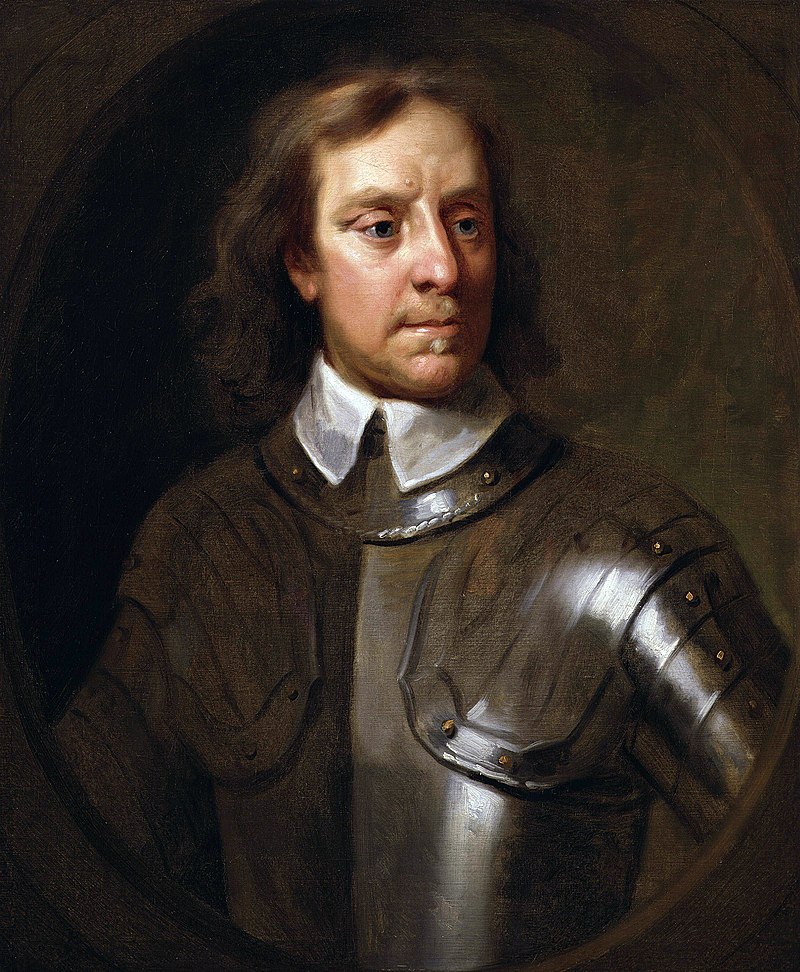
The Long Parliament was an English Parliament which lasted from 1640 until 1660. It followed the fiasco of the Short Parliament, which had convened for only three weeks during the spring of 1640 after an 11-year parliamentary absence. In Sep-1640, King Charles I issued writs summoning a parliament to convene on 3-Nov-1640. He intended it to pass financial bills, a step made necessary by the costs of the Bishops' Wars against Scotland. The Long Parliament received its name from the fact that, by Act of Parliament, it stipulated it could be dissolved only with agreement of the members; and those members did not agree to its dissolution until 16 March 1660, after the English Civil War and near the close of the Interregnum.
The parliament sat from 1640 until 1648, when it was purged by the New Model Army. After this point, the remaining members of the House of Commons became known as the Rump Parliament.
After the execution of King Charles I in 1649, England was declared a commonwealth under the rule of Parliament. But, after Oliver Cromwell dissolved the Rump and Barebones parliaments in succession in 1653 and he was installed on 16-Dec-1653, as lord protector of the commonwealth of England, Scotland, and Ireland under the authority of a constitution entitled the Instrument of Government, which had been drawn up by a group of army officers. The Protectorate, as Cromwell’s government is now known, was continued after his death on 3-Sep-1658, by his son Richard, until the latter resigned the office on 25-May-1659, at which point Parliament’s resumption of power served merely as a prelude to the Restoration of Charles II on 23-Apr-1661.
| ≡ | ⇧ |
Charles II
| Son of | Charles I & Henrietta Maria |
| Born | 29 May 1630 |
| Died | 6 Feb 1685 |
| Reigned | 23 Apr 1661 - 6 Feb 1685 |
| Married | 1662, Catherine of Braganza |
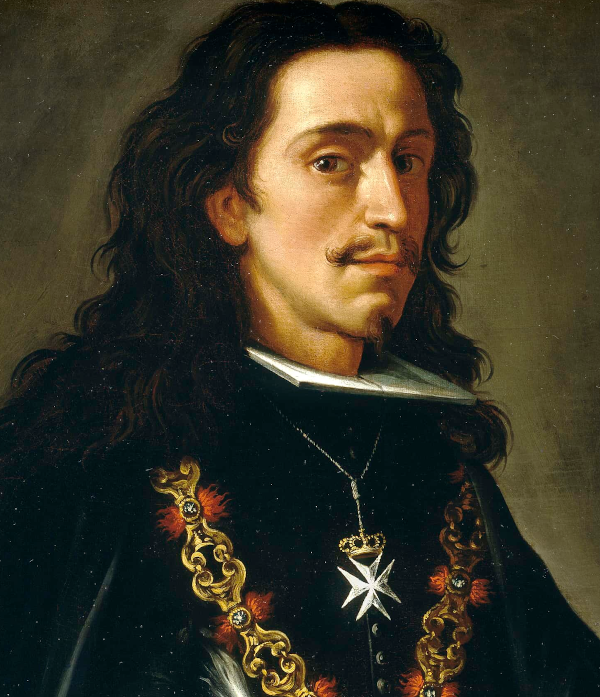
King Charles II
Charles II was tall, handsome, sharp of mind, impeccably attired and charming. But he would need all his guile to manoeuvre and survive the tempestuous times in which he ruled.
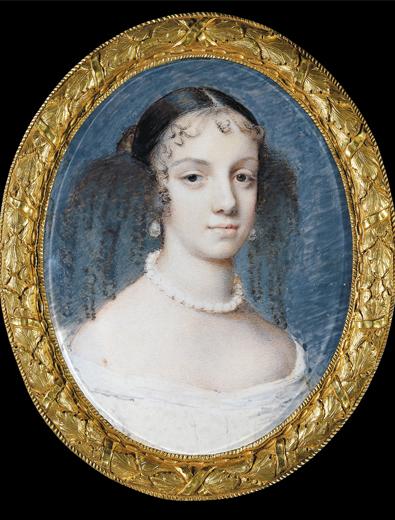
Catherine of Braganza
Despite having fathered a child by his mistress, Barbara Villiers, Charles was keen to marry. Catherine of Braganza, daughter of King John IV of Portugal, was chosen. Her dowry was extremely generous - two million crowns and the cities of Bombay and Tangiers thrown in for good measure.
Although it would be remembered as a time of great scientific advances with Charles' Royal Society at the forefront, the 1660s were still dominated by superstition. The Great Plague of London came a mere five years into his rule. The Great Fire of London the following year should surely have seen off the King but, with guile, Charles survived these events. As well as this the English lost the Second Anglo-Dutch war in 1667.
Just as the City seemed to spring anew from the ashes of the Great Fire of London, science and commerce offered hope of a better future. The misery of the recent past was perhaps enough to discourage the discontent from rebellion. Charles sued for peace abroad with the Dutch and signed the Treaty of Breda. Soon after, a formal alliance with Holland and Sweden was created.
Peace seemed to unleash the King's loins and he would then be linked with a long list of women, presumably overlapping. Countesses, singers and, famously, the orange seller turned actress Nell Gwyn graced the royal bed. Barbara was pensioned off.
Charles's French mistress, Louise de Kéroualle, started rumours at court that the French astronomer, Sieur de St. Pierre, had devised a means of determining longitude at sea by using observations of the Moon's position in relation to the background stars.
So Charles founded the Royal Observatory and on 4-Mar-1675, he signed a Royal Warrant appointing John Flamsteed as 'astronomical observator'.
Religiously, Charles was caught between support for his Catholic brother and a hysterical reaction to 'Popish' plotting. Parliament tried to cut James out of the succession and Charles looked to marry off James' daughter to Protestant Prince William of Orange in Holland.
In 1681, with Parliament poised to declare itself in charge of the royal succession, the King dissolved it to sit no more in his reign. At the very edge of the precipice, somehow Charles clung on. His final years were spent settling scores and concentrating power.
On his deathbed, he converted to Catholicism and on 6-Feb-1685 he passed away peacefully. His brother James fared less well and ruled for only three years before fleeing the country to make way for William of Orange.
| ≡ | ⇧ |
James II
| Son of | Charles I & Henrietta Maria |
| Born | 24 Oct 1633 |
| Died | 16 Sep 1701 |
| Reigned | 6 Feb 1685 - 23 Dec 1688 |
| Married | 1660, Anne Hyde & 1673, Mary of Modena |
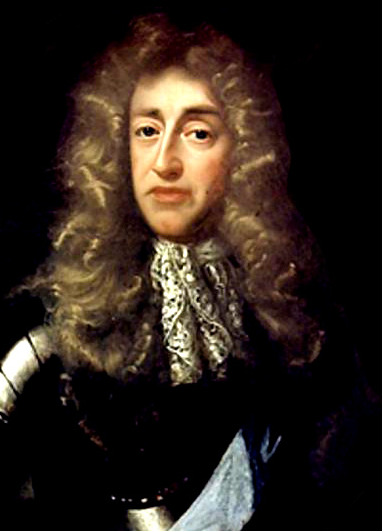
King James II
The brother of Charles II, James was the last Catholic monarch of England, Scotland, and Ireland. His reign is remembered for conflicts over religion and divine right of kings. His deposition ended a century of political and civil strife by confirming the primacy of the English Parliament over the Crown.
The birth of James' son and heir, another James, raised the prospect of a Catholic dynasty which wouuld have locked out his Protestant daughter Mary. The prosecution of the 'Seven Bishops' led to riots which raised the feeling that only James' removal could prevent anther civil war.
When William of Orange (Mary's husband) landed in 1688, James fled to France. In Feb 1689, a special convention ruled that James had “vacated” the throne and they installed William and Mary as joint Monarchs. This established that sovereignty derived from Parliament, not birth right.
James came back to England in 1689 but he lost to William III at The Battle of the Boyne in 1690 and returned to France for the rest of his life.
He had ruled for only three years and died of a brain haemorrhage in 1701.
| ≡ | ⇧ |
William III (William of Orange) and Mary
| Son of | William II & Mary Stuart |
| Line | Mary Stuart was sister of James II. Mary (William's wife) was daughter of Charles I |
| Born | 14/4 Nov 1650 (old/new) |
| Died | 19/8 Mar 1702 (old/new) |
| Reigned | 1689 - 8 Mar 1702 |
| Married | 1677, Mary - No children |
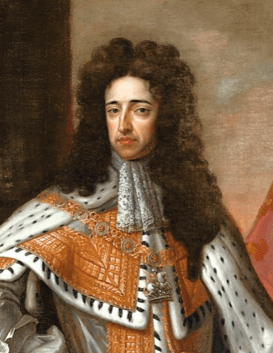 William |
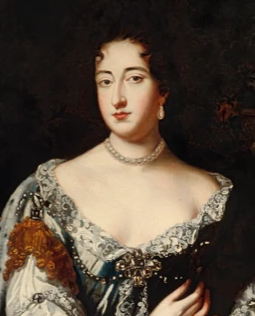 Mary |
In 1696, the Jacobites, a faction loyal to James, plotted to assassinate William. The People were expected to sign an oath of alleiancebut many wouldn't. There were ensuing battles at Aughrim and Glencoe.
William's lack of children and the death of his nephew in 1700 threatened a Protestant succession.
William was succeeded by his sister-in-law Anne.
| ≡ | ⇧ |
Anne
| Dau. of | James II & Anne Hyde |
| Born | 6 Feb 1665 |
| Died | 1 Aug 1714 |
| Reigned | 8 Mar 1702 - 1 Aug 1714 |
| Married | 1683, Prince George, Duke of Cumberland |
| Illness | She suffered from Lupus Erythematosus & had 17 miscarriages and no living children |
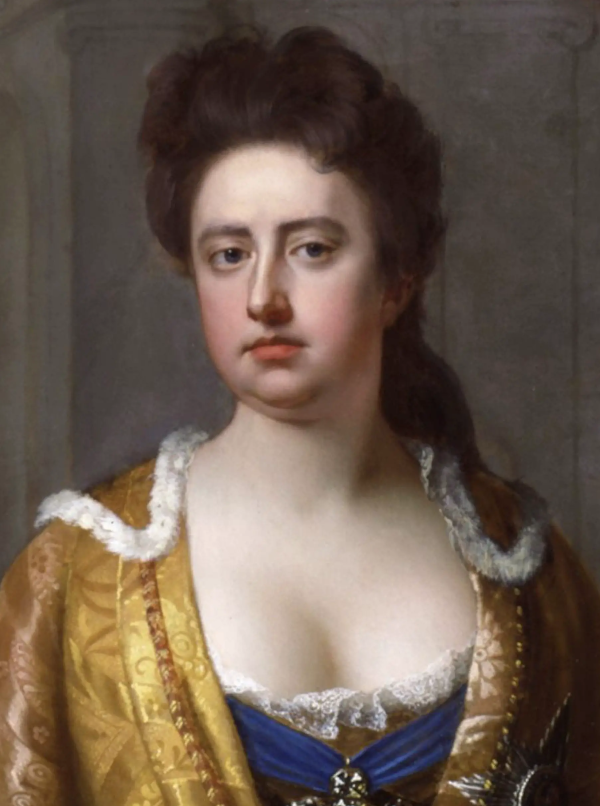
Anne
When William died in 1702, Anne succeeded him.
Anne was plagued by poor health and from her thirties she grew increasingly ill and obese. Despite 17 pregnancies, she died without surviving issue and was the last monarch of the House of Stuart.
Under the Act of Settlement 1701, which excluded all Catholics, she was succeeded by her second cousin George I of the House of Hanover.
| ≡ | ⇧ |
George I
| Son of | Sophia of Hanover & Ernest Augustus |
| Line | James I > Elizabeth Stuart = Frederick V > Sophia |
| Born | 28 May 1660 |
| Died | 11 Jun 1727 |
| Reigned | 1 Aug 1714 - 11 Jun 1727 |
| Married | 1682, Sophia Dorothea of Celle |
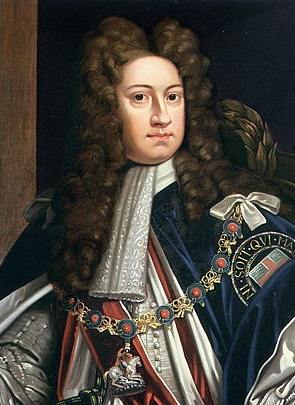
George I
| ≡ | ⇧ |
George II
| Son of | George I & Sophia Dorothea of Celle |
| Born | 1683 |
| Died | 25 Oct 1760 |
| Reigned | 11 Jun 1727 - 25 Oct 1760 |
| Married | 1705, Caroline of Ansbach |

George II
George II had 8 children: Frederick, Anne, Amelia, Caroline, George, William, Mary and Louisa. Frederick was heir but died before his father so the rules of succession (which said the heir must be: non-Catholic, legitimate, male and eldest) meant the next in line was Frederick's eldest son, George III.
In 1745, supporters of the dissolution of the union of English and Scottish crowns and Catholic claimants to the British throne, namely James Stuart, 'The Old Pretender', led by Charles Stuart 'The Young Pretender' or 'Bonnie Prince Charlie', attempted but failed to overthrow George in the Jacobite rebellion of 1745 - the '45.
| ≡ | ⇧ |
George III
| Son of | Princess Augusta of Saxe-Gotha & Frederick, Prince of Wales |
| Born | 4 Jun 1738 |
| Died | 29 Jan 1820 |
| Reigned | 25 Oct 1760 - 29 Jan 1820 |
| Married | 1761, Charlotte of Mecklenburg-Strelitz |
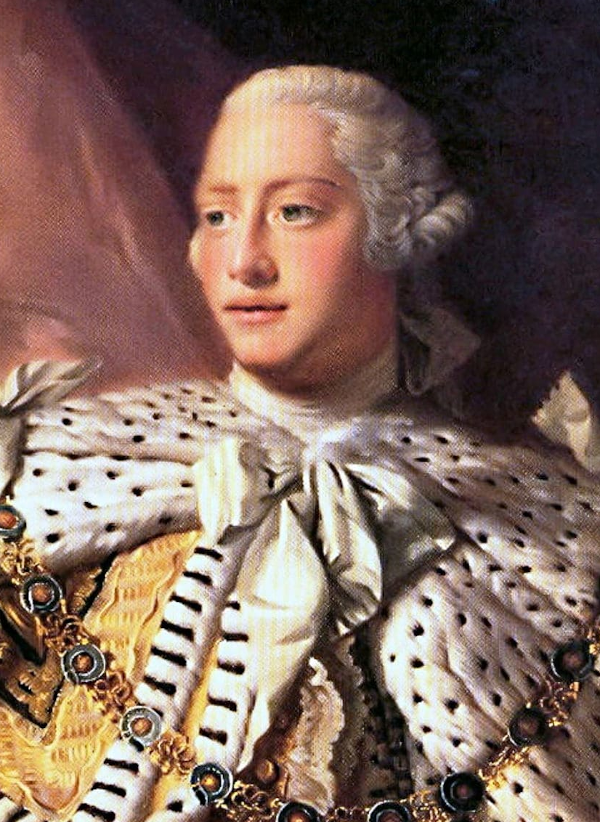
George III
George married in 1761 and went on to have 15 children. Early in his reign, he defeated France in the Seven Years' War; many colonies were lost in the American War of Independance (George hated 'losing' America); in 1800, England & Ireland were unified to make the 'United Kingdom of Great Britain and Ireland'; in 1807, the transatlantic slave trade was banned and further wars in France resulted in the defeat of Napolean in 1815.
George famously went 'mad' and medics thought he had prophyria because his urine went blue. However, he was being treated with gentian so medics now think his blue urine was down to the gentian medicines and that his problem was purely psychiatric. He did eventually recover and he is thought to have been quite a good King.
| ≡ | ⇧ |
George IV
| Son of | George III & Charlotte of Mecklenburg-Strelitz |
| Born | 12 Aug 1762 |
| Died | 26 Jun 1830 |
| Reigned | 29 Jan 1820 - 26 Jun 1830 |
| Married | 1785, Maria Fitzherbert & 1795, Caroline of Brunswick |
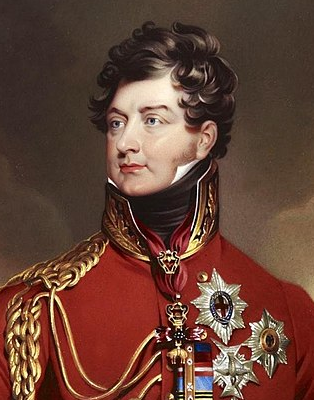
George IV
| ≡ | ⇧ |
William IV
| Son of | George III & Charlotte of Mecklenburg-Strelitz | |
| Born | 21 Aug 1765 | |
| Died | 20 Jun 1837 | |
| Reigned | 26 Jun 1830 - 20 Jun 1837 | |
| Married | 1818, Adelaide of Saxe-Meiningen |
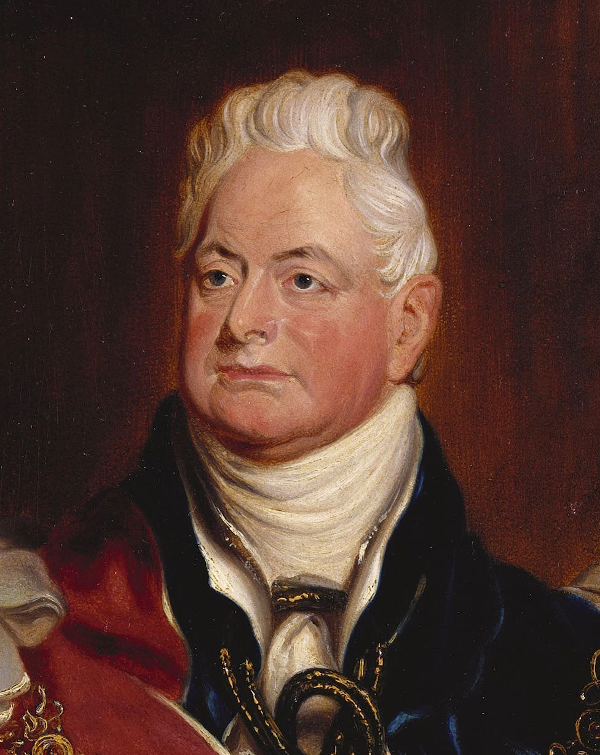
William IV
| ≡ | ⇧ |
Victoria
| Dau. of | Prince Edward, Duke of Kent & Princess Victoria of Saxe-Coburg-Saalfeld | |
| Line | Prince Edward was 4th son of George III | |
| Born | 24 May 1819 | |
| Died | 22 Jan 1901 | |
| Reigned | 20 Jun 1837 - 22 Jan 1901 | |
| Married | 1840, Prince Albert of Saxe-coburg |

Queen Victoria
| ≡ | ⇧ |
Edward VII
| Son of | Prince Albert of Saxe-Coburg & Queen Victoria | |
| Born | 9 November 1841 | |
| Died | 6 May 1910 | |
| Reigned | 22 Jan 1901 - 6 May 1910 | |
| Married | 1863, Alexandra of Denmark |

Edward VII
| ≡ | ⇧ |
George V
| Son of | Prince Albert of Saxe-Coburg & Queen Victoria | |
| Born | 3 Jun 1865 | |
| Died | 20 Jan 1936 | |
| Reigned | 6 May 1910 - 20 Jan 1936 | |
| Married | 1893, Mary of Teck |
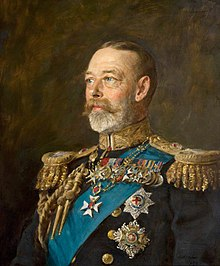
George V
| ≡ | ⇧ |
Edward VIII
| Son of | George V & Mary of Teck | |
| Born | 23 Jun 1894 | |
| Died | 28 May 1972 | |
| Reigned | 20 Jan 1936 - 11 Dec 1936, abdicated | |
| Married | 1937, Wallis Simpson |
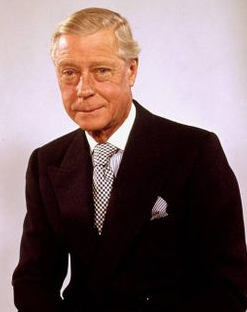
Edward VIII
| ≡ | ⇧ |
George VI
| Son of | George V & Mary of Teck | |
| Born | 14 Dec 1895 | |
| Died | 6 Feb 1952 | |
| Reigned | 11 Dec 1936 - 6 Feb 1952 | |
| Married | 1923, Elizabeth Bowes-Lyon |
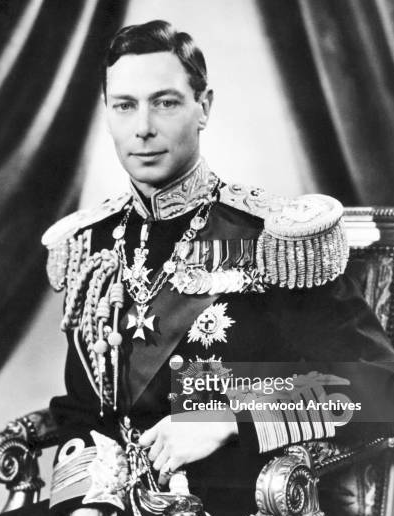
George VI
| ≡ | ⇧ |
Elizabeth II
| Dau. of | George VI & Elizabeth Bowes-Lyon | |
| Born | 21 Apr 1926 | |
| Died | 8 Sep 2022 | |
| Reigned | 6 Feb 1952 - 8 Sep 2022 | |
| Married | 20 Nov 1947, Sir Philip Mountbatten |

Elizabeth II
| ≡ | ⇧ |
Charles III
| Son of | Elizabeth II & Prince Philip | |
| Born | 14 Nov 1948 | |
| Died | - | |
| Reigned | 8 Sep 2022 - | |
| Married | 1981, Diana Spencer & 2005, Camilla Parker-Bowles |
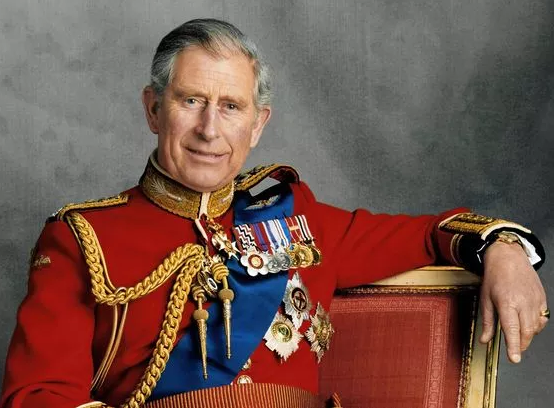
Charles III
| ≡ | ⇧ |
Magna Carta
When barons demanded peace, a charter was drafted by the Archbishop of Canterbury Cardinal Stephen Langton. It was agreed by King John at Runnymede in 1215 but was later annulled by Pope Innocent III. Henry III re-issued the charter in 1216 and again in 1217 which is when it got the name Magna Carta. It was issued again in 1225 and finally Edward I enshrined it in law in 1297.
[Preamble] EDWARD by the grace of God, King of England, Lord of Ireland, and Duke of Guyan, to all Archbishops, Bishops, etc. We have seen the Great Charter of the Lord HENRY, sometimes King of England, our father, of the Liberties of England, in these words: Henry by the grace of God, King of England, Lord of Ireland, Duke of Normandy and Guyan, and Earl of Anjou, to all Archbishops, Bishops, Abbots, Priors, Earls, Barons, Sheriffs, Provosts, Officers, and to all Bailiffs and other our faithful Subjects , which shall see this present Charter, Greeting. Know ye that we, unto the honour of Almighty God, and for the salvation of the souls of our progenitors and successors, Kings of England, to the advancement of holy Church, and amendment of our Realm, of our meer and free will, have given and granted to all Archbishops, Bishops, Abbots, Priors, Earls, Barons, and to all freemen of this our realm, these liberties following, to be kept in our kingdom of England for ever.
[1] First, We have granted to God, and by this our present Charter have confirmed, for us and our Heirs for ever, That the Church of England shall be free, and shall have her whole rights and liberties inviolable. We have granted also, and given to all the freemen of our realm, for us and our Heirs for ever, these liberties underwritten, to have and to hold to them and their Heirs, of us and our Heirs for ever.
[2] If any of our Earls or Barons, or any other, which holdeth of Us in chief by Knights service, shall die and at the time of his death his heir be of full age, and oweth us Relief, he shall have his inheritance by the old Relief; that is to say, the heir or heirs of an Earl, for a whole Earldom, by one hundred pound; the heir or heirs of a Baron, for an whole Barony, by one hundred marks; the heir or heirs of a Knight, for one whole Knights fee, one hundred shillings at the most; and he that hath less, shall give less, according to the custom of the fees.
[3] But if the Heir of any such be within age, his Lord shall not have the ward of him, nor of his land, before that he hath taken him homage. And after that such an heir hath been in ward (when he is come of full age) that is to say, to the age of one and twenty years, he shall have his inheritance without Relief, and without Fine; so that if such an heir, being within age, be made Knight, yet nevertheless his land shall remain in the keeping of his Lord unto the term aforesaid.
[4] The keeper of the land of such an heir, being within age, shall not take of the lands of the heir, but reasonable issues, reasonable customs, and reasonable servics, and that without destruction and waste of his men and goods. And if we commit the custody of any such land to the Sheriff, or to any other, which is answerable unto us for the issues of the same land, and he make destruction or waste of those things that he hath in custody, we will take of him amends and recompence therefore, and the land shall be committed to two lawful and discreet men of that fee, which shall answer unto us for the issues of the same land, or unto him whom we will assign. And if we give or sell to any man the custody of any such land, and he therein do make destruction or waste, he shall lose the same custody; and it shall be assigned to two lawful and discreet men of that fee, which also in like manner shall be answerable to us, as afore is said.
[5] The keeper, so long as he hath the custody of the land of such an heir, shall keep up the houses, parks, warrens, ponds, mills, and other things pertaining to the same land, with the issues of the said land; and he shall deliver to the Heir, when he cometh to his full age, all his land stored with ploughs, and all other things, at the least as he received it. All these things shall be observed in the custodies of the Archbishopricks, Bishopricks, Abbeys, Priories, Churchs, and Dignities vacant, which appertain to us; except this, that such custody shall not be sold.
[6] Heirs shall be married without Disparagement.
[7] A Widow, after the death of her husband, incontinent, and without any Difficulty, shall have her marriage and her inheritance, and shall give nothing for her dower, her marriage, or her inheritance, which her husband and she held the day of the death of her husband, and she shall tarry in the chief house of her husband by forty days after the death of her husband, within which days her dower shall be assigned her (if it were not assigned her before) or that the house be a castle; and if she depart from the castle, then a competent house shall be forthwith provided for her, in the which she may honestly dwell, until her dower be to her assigned, as it is aforesaid; and she shall have in the meantime her reasonable estovers of the common; and for her do wer shall be assigned unto her the third part of all the lands of her husband, which were his during coverture, except she were endowed of less at the Church-door. No widow shall be distrained to marry herself: nevertheless she shall find surety, that she shall not marry without our licence and assent (if she hold of us) nor without the assent of the Lord, if she hold of another.
[8] We or our Bailiffs shall not seize any land or rent for any debt, as long as the present Goods and Chattels of the debtor do suffice to pay the debt, and the debtor himself be ready to satisfy therefore. Neither shall the pledges of the debtor be dist rained, as long as the principal debtor is sufficient for the payment of the debt. And if the principal debtor fail in the payment of the debt, having nothing wherewith to pay, or will not pay where he is able, the pledges shall answer for the debt. And if they will, they shall have the lands and rents of the debtor, until they be satished of that which they before paid for him, except that the debtor can show himself to be acquitted against the said sureties.
[9] The city of London shall have all the old liberties and customs, which it hath been used to have. Moreover we will and grant, that all other Cities, Boroughs, Towns, and the Barons of the Five Ports, and all other Ports, shall have all their liberties and free customs.
[10] No man shall be distrained to do more service for a Knights fee, nor any freehold, than therefore is due.
[11] Common Pleas shall not follow our Court, but shall be holden in some place certain.
[12] Assises of novel disseisin, and of Mortdancestor, shall not be taken but in the shires, and after this manner: If we be out of this Realm, our chief Justicer shall send our Justicers through every County once in the Year, which, with the Knights of the shires, shall take the said Assises in those counties; and those things that at the coming of our foresaid Justicers, being sent to take those Assises in the counties, cannot be determined, shall be ended by them in some other place in their circuit; and those things, which for difficulty of some articles cannot be determined by them, shall be referred to our Justicers of the Bench, and there shall be ended.
[13] Assises of Darrein Presentment shall be alway taken before our Justices of the Bench, and there shall be determined.
[14] A Freeman shall not be amerced for a small fault, but after the manner of the fault; and for a great fault after the greatness thereof, saving to him his contenement; and a Merchant likewise, saving to him his Merchandise; and any other's villain than ours shall be likewise amerced, saving his wainage, if he falls into our mercy. And none of the said amerciaments shall be assessed, but by the oath of honest and lawful men of the vicinage. Earls and Barons shall not be amerced but by their Peers, and after the manner of their offence. No man of the Church shall be amerced after the quantity of his spiritual Benefice, but after his Lay-tenement, and after the quantity of his offence.
[15] No Town or Freeman shall be distrained to make Bridges nor Banks, but such as of old time and of right have been accustomed to make them in the time of King Henry our Grandfather.
[16] No Banks shall be defended from henceforth, but such as were in defence in the time of King Henry our Grandfather, by the same places, and the same bounds, as they were wont to be in his time.
[17] No Sheriff, Constable, Escheator, Coroner, nor any other our Bailiffs, shall hold Pleas of our Crown.
[18] If any that holdeth of us Lay-fee do die, and our Sheriff or Bailiff do show our Letters Patents of our summon for Debt, which the dead man did owe to us; it shall be lawful to our Sheriff or Bailiff to attach or inroll all the goods and chattels of the dead, being found in the said fee, to the Value of the same Debt, by the sight and testimony of lawful men, so that nothing thereof shall be taken away, until we be clearly paid off the debt; and the residue shall remain to the Executors to perform the testament of the dead; and if nothing be owing unto us, all the chattels shall go to the use of the dead (saving to his wife and children their reasonable parts).
[19] No Constable, nor his Bailiff, shall take corn or other chattels of any man, if the man be not of the Town where the Castle is, but he shall forthwith pay for the same, unless that the will of the seller was to respite the payment; and if he be of the same Town, the price shall be paid unto him within forty days.
[20] No Constable shall distrain any Knight to give money for keeping of his Castle, if he himself will do it in his proper person, or cause it to be done by another sufficient man, if he may not do it himself for a reasonable cause. And if we lead or send him to an army, he shall be free from Castle-ward for the time that he shall be with us in fee in our host, for the which he hath done service in our wars.
[21] No Sheriff nor Bailiff of ours, or any other, shall take the Horses or Carts of any man to make carriage, except he pay the old price limited, that is to say, for carriage with two horse, x.d. a day; for three horse, xiv.d. a day. No demesne Cart of any Spiritual person or Knight, or any Lord, shall be taken by our Bailiffs; nor we, nor our Bailiffs, nor any other, shall take any man's wood for our Castles, or other our necessaries to be done, but by the licence of him whose wood it shall be.
[22] We will not hold the Lands of them that be convict of Felony but one year and one day, and then those Lands shall be delivered to the Lords of the fee.
[23] All Wears from henceforth shall be utterly put down by Thames and Medway, and through all England, but only by the Sea-coasts.
[24] The Writ that is called Praecipe in capite shall be from henceforth granted to no person of any freehold, whereby any freeman may lose his Court.
[25] One measure of Wine shall be through our Realm, and one measure of Ale, and one measure of Corn, that is to say, the Quarter of London; and one breadth of dyed Cloth, Russets, and Haberjects, that is to say, two Yards within the lists. And it shall be of Weights as it is of Measures.
[26] Nothing from henceforth shall be given for a Writ of Inquisition, nor taken of him that prayeth Inquisition of Life, or of Member, but it shall be granted freely, and not denied.
[27] If any do hold of us by Fee-ferm, or by Socage, or Burgage, and he holdeth Lands of another by Knights Service, we will not have the Custody of his Heir, nor of his Land, which is holden of the Fee of another, by reason of that Fee-ferm, Socage, or Burgage. Neither will we have the custody of such Fee-ferm, or Socage, or Burgage, except Knights Service be due unto us out of the same Fee-ferm. We will not have the custody of the Heir, or of any Land, by occasion of any Petit Serjeanty, that any man holdeth of us by Service to pay a Knife, an Arrow, or the like.
[28] No Bailiff from henceforth shall put any man to his open Law, nor to an Oath, upon his own bare saying, without faithful Witnesses brought in for the same.
[29] No Freeman shall be taken, or imprisoned, or be disseised of his Freehold, or Liberties, or free Customs, or be outlawed, or exiled, or any otherwise destroyed; nor will we pass upon him, nor condemn him, but by lawful Judgment of his Peers, or by the Law of the Land. We will sell to no man, we will not deny or defer to any man either Justice or Right.
[30] All Merchants (if they were not openly prohibited before) shall have their safe and sure Conduct to depart out of England, to come into England, to tarry in, and go through England, as well by Land as by Water, to buy and sell without any manner of evil Tolts, by the old and rightful Customs, except in Time of War. And if they be of a land making War against us, and such be found in our Realm at the beginning of the Wars, they shall be attached without harm of body or goods, until it be known unto us , or our Chief Justice, how our Merchants be intreated there in the land making War against us; and if our Merchants be well intreated there, theirs shall be likewise with us.
[31] If any man hold of any Eschete, as of the honour of Wallingford, Nottingham, Boloin, or of any other Eschetes which be in our hands, and are Baronies, and die, his Heir shall give none other Relief, nor do none other Service to us, than he should to the Baron, if it were in the Baron's hand. And we in the same wise shall hold it as the Baron held it; neither shall we have, by occasion of any such Barony or Eschete, any Eschete or keeping of any of our men, unless he that held the Barony or Eschete hold of us in chief.
[32] No Freeman from henceforth shall give or sell any more of his Land, but so that of the residue of the Lands the Lord of the Fee may have the Service due to him, which belongeth to the Fee.
[33] All Patrons of Abbies, which have the King's Charters of England of Advowson, or have old Tenure or Possession in the same, shall have the Custody of them when they fall void, as it hath been accustomed, and as it is afore declared.
[34] No Man shall be taken or imprisoned upon the Appeal of a Woman for the Death of any other, than of her husband.
[35] No County Court from henceforth shall be holden, but from Month to Month; and where greater time hath been used, there shall be greater: Nor any Sheriff, or his Bailiff, shall keep his Turn in the Hundred but twice in the Year; and nowhere but in due place, and accustomed; that is to say, once after Easter, and again after the Feast of St. Michael. And the View of Frankpledge shall be likewise at the Feast of St. Michael without occasion; so that every man may have his Liberties which he had, or used to have, in the time of King HENRY our Grandfather, or which he hath purchased since: but the View of Frankpledge shall be so done, that our Peace may be kept; and that the Tything be wholly kept as it hath been accustomed; and that the Sheriff seek no Occasions, and that he be content with so much as the Sheriff was wont to have for his Viewmaking in the time of King HENRY our Grandfather.
[36] It shall not be lawful from henceforth to any to give his Lands to any Religious House, and to take the same Land again to hold of the same House. Nor shall it be lawful to any House of Religion to take the Lands of any, and to lease the same to him of whom he received it. If any from henceforth give his Lands to any Religious House, and thereupon be convict, the Gift shall be utterly void, and the Land shall accrue to the Lord of the Fee.
[37] Escuage from henceforth shall be taken like as it was wont to be in the time of King HENRY our Grandfather; reserving to all Archbishops, Bishops, Abbots, Priors, Templers, Hospitallers, Earls, Barons, and all persons, as well Spiritual as Temporal, all their free liberties and free Customs, which they have had in time passed. And all these Customs and Liberties aforesaid, which we have granted to be holden within this our Realm, as much as appertaineth to us and our Heirs, we shall observe; and all Men of this our Realm, as well Spiritual as Temporal (as much as in them is) shall observe the same against all persons in like wise. And for this our Gift and Grant of these Liberties, and of other contained in our Charter of Liberties of our Forest, the Archbishops, Bishops, Abbots, Priors, Earls, Barons, Knights, Freeholders, and other our Subjects, have given unto us the Fifteenth Part of all their Moveables. And we have granted unto them for us and our Heirs, that neither we, nor our Heirs shall proc ure or do anything whereby the Liberties in this Charter contained shall be infringed or broken; and if anything be procured by any person contrary to the premisses, it shall be had of no force nor effect. These being Witnesses; Lord B. Archbishop of Cant erbury, E. Bishop of London, J. Bishop of Bathe, P. of Winchester, H. of Lincoln, R. of Salisbury, W. of Rochester, W. of Worester, J. of Ely, H. of Hereford, R. of Chichester, W. of Exeter, Bishops; the Abbot of St. Edmunds, the Abbot of St. Albans, the Abbot of Bello, the Abbot of St. Augustines in Canterbury, the Abbot of Evesham, the Abbot of Westminster, the Abbot of Bourgh St. Peter, the Abbot of Reading, the Abbot of Abindon, the Abbot of Malmsbury, the Abbot of Winchcomb, the Abbot of Hyde, the Abbot of Certefey, the Abbot of Sherburn, the Abbot of Cerne, the Abbot of Abbotebir, the Abbot of Middleton, the Abbot of Seleby, the Abbot of Cirencester; H. de Burgh Justice, H. Earl of Chester and Lincoln, W. Earl of Salisbury, W. Earl of Warren, G. de Clare Earl of Gloucester and Hereford, W. de Ferrars Earl of Derby, W. de Mandeville Earl of Essex, H. de Bygod Earl of Norfolk, W. Earl of Albermarle, H. Earl of Hereford, J. Constable of Chester, R. de Ros, R. Fitzwalter, R. de Vyponte, W. de Bruer, R. de Muntefichet, P. Fitzherbert, W. de Aubenie, F. Grefly, F. de Breus, J. de Monemue, J. Fitzallen, H. de Mortimer, W. de Beauchamp, W. de St. John, P. de Mauly, Brian de Lisle, Thomas de Multon, R. de Argenteyn, G. de Nevil, W. de Mauduit, J. de Balun, and others.
We, ratifying and approving these Gifts and Grants aforesaid, confirm and make strong all the same for us and our Heirs perpetually, and, by the Tenour of these Presents, do renew the same; willing and granting for us and our Heirs, that this Charter, and all and singular his Articles, for ever shall be stedfastly, firmly, and inviolably observed; although some Articles in the same Charter contained, yet hitherto peradventure have not been kept, we will, and by Authority Royal command, from henceforth firmly they be observed. In witness whereof we have caused these our Letters Patents to be made. T. EDWARD our Son at Westminster, the Twenty-eighth Day of March, in the Twenty-eighth Year of our Reign.
| ≡ | ⇧ |
Geographical
France has 13 Regions
- Auvergne-Rhône-Alpes
- Bougogne-Franche-Comté
- Brittany
- Crntre-Val de Loire
- Corsic
- Grand Est
- Hauts-de-France
- Île-de-France
- Normandy
- Nouvelle-Aquitaine
- Occitania
- Pays de la Loire
- Provence-Alpes-Côte d'Azur
French Départements
| Ain | Aisne | Allier | Alpes-de-Haute-Provence | Hautes-Alpes | Alpes-Maritimes |
| Ardèche | Ardennes | Ariè | Aube | Aude | Aveyron |
| Bouches-du-Rhône | Calvados | Cantal | Charente | Charente-Maritime | Cher |
| Corrèze | Corse-du-Sud | Haute-Corse | Côte-d'Or | Côtes-d'Armor | Creuse |
| Dordoyne | Doubs | Drôme | Eure | Eure-et-Loir | Finistère |
| Gard | |||||
| Essonne | Hauts-de-Seine | Seine-Saint-Denis | Val-de-Marne | Val-d'Oise |
| ≡ | ⇧ |
Ivy League universities
| University/College | Location |
|---|---|
| Brown | Providence, RI |
| Columbia | Upper Manhatten, NYC |
| Cornell | Ithaca, NY |
| Dartmouth | Hanover, NH |
| Harvard | Cambridge (Boston), MA |
| Pennsylvania | Philadelphia, PA |
| Princeton | Princeton, NJ |
| Yale | New Haven, CT |
| Caltech | Pasadena, CA |
| Carnegie Mellon | Pittsburgh, PA |
| MIT | Boston, MA |
| ≡ | ⇧ |
Geological Eras
| Eon | Era | Period | Epoch | ya |
|---|---|---|---|---|
| Phanerozoic | Cenozoic | Quartenary | Holocene | 11.8k |
| Pleistocene | – | |||
| Neogene | Pliocene | – | ||
| Miocene | – | |||
| Paleogene | Oligocene | – | ||
| Eocene | – | |||
| Paleocene | 66m | |||
| Mesozoic | Cretaceous | – | – | |
| Jurassic | – | – | ||
| Triassic | – | 252m | ||
| Paleozoic | Permian | – | – | |
| Carboniferous/Pennsylvanian | – | – | ||
| Carboniferous/Mississippian | – | – | ||
| Devonian | – | – | ||
| Silurian | – | – | ||
| Ordovician | – | – | ||
| Cambrian | – | 541m | ||
| Proterozoic | – | – | – | 2.5g |
| Archean | – | – | – | 4.0g |
| Hadean | – | – | – | 4.54g |
Prehistoric Ages
| Age | Sub-age | Time span | |
|---|---|---|---|
| Stone Age | 2.6mya to 3,000 BC | ||
| Paleolithic | Ice age, 2.6mya to 12,000 BC | ||
| Mesolithic | 12,000 BC to 8,000 BC | ||
| Neolithic | 8,000 BC to 3,000 BC | ||
| Bronze Age | 3,000 BC to 1,200 BC | ||
| Iron Age | 1,200 BC to 550 BC | ||
| Roman Empire | 27 BC to 476 AD | ||
| Early Middle (Dark) Ages | 476 AD to 1000 AD | ||
| High Middle Ages | 1000 AD to 1300 AD | ||
| Late Middle Ages | 1300 AD to 1500 AD | ||
| Renaissance Age of Exploration | |||
| Slave Trade | 1500 AD to 1600 AD | ||
| Reformation | |||
| Scientific Revolution | 1600 AD to 1700 AD | ||
| French Revolution | 1700 AD to 1800 AD | ||
| Age of Enlightenment | 1700 AD to 1800 AD |
| ≡ | ⇧ |
Mount Rushmore
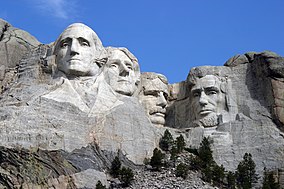
|
- George Washington - first president of the US
- Thomas Jefferson - primary author of the Declaration of Independence
- Theodore Roosevelt - leader at the beginning of the 20th century
- Abraham Lincoln - leader through the Civil War and abolished slavery
| ≡ | ⇧ |
Regions of Italy
Aosta Valley
Friuli-Venezia Giulia
Veneto
Piedmont
Emilia-Romagna
Liguria
Tuscany
Marche
Umbria
Abruzzo
Lazio
Molise
Campania
Apulia
Basilicata
Calabria
Sardinia
Sicily
| ≡ | ⇧ |
Political
Commonwealth
The Commonwealth of Nations was set up by Queen Elizabeth II in 1959. It comprises 56 countries with a total polulation of 2.5 billion people who all work together for prosperity, democracy and peace.Commonwealth Day this year (2024) was on 11th March
| Country | First Joined | UN Continental Region | UN Geo. Sub-region | Population | System of Gov't |
|---|---|---|---|---|---|
| Antigua and Barbuda | 1 Nov 1981 | Americas | Caribbean | 94,195 | Unitary Commonwealth realm |
| Australia | 19 Nov 1926 | Oceania | Australia and New Zealand | 25,766,600 | Federal Commonwealth realm |
| Australia was one of the original Dominions at the time of the Balfour Declaration of 1926 and the Statute of Westminster 1931, although the statute was not adopted in Australia until 1942 (with retroactive effect from 1939). The Australia Act 1986 eliminated the remaining possibilities for the UK to legislate with effect in Australia, for the UK to be involved in Australian government, and for an appeal from any Australian court to a British court. | |||||
| Bahamas | 10 Jul 1973 | Americas | Caribbean | 402,576 | Unitary Commonwealth realm |
| Bangladesh | 18 Apr 1972[11] | Asia | Southern Asia | 165,867,307 | Unitary Westminster republic |
| Declared independence from Pakistan in 1971. | |||||
| Barbados | 30 Nov 1966 | Americas | Caribbean | 286,618 | Unitary Westminster republic |
| Barbados removed Elizabeth II as its head of state and became a republic on 30 November 2021. | |||||
| Belize | 21 Sep 1981 | Americas | Central America | 379,636 | Unitary Commonwealth realm |
| Botswana | 30 Sept 1966 | Africa | Southern Africa | 2,377,831 | Unitary parliamentary republic with an executive presidency |
| Brunei | 7 May 1984 | Asia | South-eastern Asia | 439,022 | Unitary Islamic absolute monarchy |
| Cameroon | 1 Nov 1995 | Africa | Middle Africa | 24,836,674 | Unitary semi-presidential republic |
| Most of the country was the formerly French mandate territory (later UN trust territory) of Cameroun, which gained independence from France on 1 January 1960. It united with the much smaller former British mandate/trust territory of Southern Cameroons, which gained independence from the United Kingdom on 1 October 1961. | |||||
| Canada | 19 Nov 1926 | Americas | North America | 40,362,270 | Federal Commonwealth realm |
| Canada was the first among the several original Dominions at the time of the Balfour Declaration of 1926 and the Statute of Westminster 1931. Incorporated another original Dominion, Newfoundland, on 31 March 1949. The Canada Act 1982 formally ended the "request and consent" provisions of the Statute of Westminster 1931 in relation to Canada, whereby the British parliament had a general power to pass laws extending to Canada at its own request. | |||||
| Cyprus | 13 Mar 1961 | Europe | Southeast Europe | 1,197,667 | Unitary presidential republic |
| Gained independence from the United Kingdom on 16 August 1960. Britain retains military bases at Akrotiri and Dhekelia. Northern Cyprus is not recognised by the Commonwealth. | |||||
| Dominica | 3 Nov 1978 | Americas | Caribbean | 72,975 | Unitary Westminster republic |
| Dominica has always been a republic since independence. | |||||
| Eswatini | 6 Sep 1968 | Africa | Southern Africa | 1,336,933 | Unitary absolute monarchy |
| Joined as Swaziland, subsequently changing its name to Eswatini on 19 April 2018. | |||||
| Fiji | 10 Oct 1970 | Oceania | Melanesia | 909,024 | Unitary Westminster republic |
| Suspended in 1987; rejoined in 1997; suspended on 6 June 2000; suspension lifted on 20 December 2001; again suspended on 8 December 2006 because of the 2006 Fijian coup d'état. Suspension lifted on 26 September 2014. | |||||
| Gabon | 25 Jun 2022 | Africa | Middle Africa | 2,233,272 | Unitary presidential republic |
| Gained independence from France on 17 August 1960. The third (after Mozambique and Rwanda) to be admitted to the Commonwealth without any former colonial or constitutional links with the United Kingdom. Partially suspended on 18 September 2023 following the military coup that ousted President Ali Bongo the previous month, with two years given by the Commonwealth Ministerial Action Group for the country to hold new elections before a full suspension of membership would be considered. | |||||
| Gambia | 18 Feb 1965 | Africa | Western Africa | 2,155,958 | Unitary presidential republic |
| Withdrew on 3 October 2013 citing "neocolonialism". Following the election of Adama Barrow as President of Gambia in 2016, it submitted an application to rejoin the Commonwealth on 22 January 2018, and rejoined on 8 February 2018. | |||||
| Ghana | 6 Mar 1957 | Africa | Western Africa | 29,088,849 | Unitary presidential republic |
| Grenada | 7 Feb 1974 | Americas | Caribbean | 107,894 | Unitary Commonwealth realm |
| Guyana | 26 May 1966 | Americas | South America | 773,808 | Unitary presidential republic |
| India | 15 Aug 1947 | Asia | Southern Asia | 1,428bn | Federal Westminster republic |
| Incorporated former French India (Chandannagar from 2 May 1950 and Puducherry, Karaikal, Yanam and Mahé from 1 Nov 1954), former Portuguese India (Goa, Daman and Diu from 19 December 1961 and Dadra and Nagar Haveli formally from 1961) and Sikkim (from 16 May 1975). | |||||
| Jamaica | 6 Aug 1962 | Americas | Caribbean | 2,819,888 | Unitary Commonwealth realm |
| Kenya | 12 Dec 1963 | Africa | Eastern Africa | 49,167,382 | Unitary presidential republic |
| Kiribati | 12 Jul 1979 | Oceania | Micronesia | 117,636 | Unitary parliamentary republic with an executive presidency |
| Lesotho | 4 Oct 1966 | Africa | Southern Africa | 2,199,492 | Unitary Westminster monarchy |
| Malawi | 6 Jul 1964 | Africa | Eastern Africa | 18,558,768 | Unitary presidential republic |
| Malaysia | 31 Aug 1957 | Asia | South-eastern Asia | 31,505,208 | Federal Westminster monarchy |
| Joined as the Federation of Malaya in 1957; reformed as Malaysia on 16 September 1963 with its federation with Singapore (which became a separate country on 9 August 1965), North Borneo, and Sarawak. | |||||
| Maldives | 9 Jul 1982 | Asia | Southern Asia | 515,696 | Unitary presidential republic |
| Gained independence from the United Kingdom on 26 July 1965. A special member from 9 July 1982 until 20 July 1985. Withdrew on 13 October 2016. Rejoined on 1 February 2020. | |||||
| Malta | 21 Sep 1964 | Europe | Southern Europe | 422,212 | Unitary Westminster republic |
| Gained independence from the United Kingdom on 21 September 1964 as the State of Malta. Became a republic on 13 Dec 1974. | |||||
| Mauritius | 12 Mar 1968 | Africa | Eastern Africa | 1,286,240 | Unitary Westminster republic |
| Became a republic on 12 March 1992. | |||||
| Mozambique | 13 Nov 1995 | Africa | Eastern Africa | 29,977,238 | Unitary semi-presidential republic |
| Former dependency of Portuguese India until 1752. Gained independence from Portugal on 25 June 1975. The first country to be admitted to the Commonwealth without any former colonial or constitutional links with the United Kingdom. | |||||
| Namibia | 21 Mar 1990 | Africa | Southern Africa | 2,600,857 | Unitary semi-presidential republic |
| Gained independence from South Africa. Includes Walvis Bay and the Penguin Islands transferred by South Africa at midnight 28 February 1994. | |||||
| Nauru | 29 Nov 1968 | Oceania | Micronesia | 10,387 | Unitary parliamentary republic with an executive presidency |
| Gained independence on 31 January 1968 from joint trusteeship of Australia, New Zealand and United Kingdom. A special member from 29 November 1968 until 1 May 1999, when it became a full member, before reverting to special status in January 2006. A full member again since June 2011. | |||||
| New Zealand | 19 Nov 1926 | Oceania | Australia and New Zealand | 4,609,755 | Unitary Commonwealth realm |
| Granted nominal independence (Dominion status) on 26 September 1907. One of the original Dominions at the time of the Balfour Declaration of 1926 and the Statute of Westminster 1931, although the Statute was not adopted in New Zealand until 1947. Removed final links with the British Parliament in 1986. Removed the final link with the British legal system (Judicial Committee of the Privy Council) in 2003. | |||||
| Nigeria | 1 Oct 1960 | Africa | Western Africa | 194,615,054 | Federal presidential republic |
| Incorporated the former British mandate/trust territory of Northern Cameroons on 31 May 1961. Suspended in 1995, suspension lifted in 1999. | |||||
| Pakistan | 14 Aug 1947 | Asia | Southern Asia | 229,494,441 | Federal Westminster republic |
| Includes the city of Gwadar, transferred from Muscat and Oman on 8 September 1958. Included Bangladesh (then known as East Pakistan) until 1971. Left Commonwealth in 1972, rejoined 1990, effective retroactively from October 1989; suspended in 1999, suspension lifted in 2004; again suspended in 2007, suspension lifted in 2008. | |||||
| Papua New Guinea | 16 Sep 1975 | Oceania | Melanesia | 8,034,630 | Unitary Commonwealth realm |
| Gained independence from Australia. | |||||
| Rwanda | 29 Nov 2009 | Africa | Eastern Africa | 12,322,920 | Unitary presidential republic |
| Gained independence from Belgium on 1 July 1962. The second country (after Mozambique) to be admitted to the Commonwealth without any former colonial or constitutional links with the United Kingdom. Admitted despite the Commonwealth Human Rights Initiative (CHRI) finding that "the state of governance and human rights in Rwanda does not satisfy Commonwealth standards", and that it "does not therefore qualify for admission". | |||||
| Saint Kitts and Nevis | 19 Sep 1983 | Americas | Caribbean | 56,632 | Federal Commonwealth realm |
| Saint Lucia | 22 Feb 1979 | Americas | Caribbean | 189,000 | Unitary Commonwealth realm |
| Saint Vincent and the Grenadines | 27 October 1979 | Americas | Caribbean | 109,501 | Unitary Commonwealth realm |
| A special member from 27 October 1979 until 1 June 1985. | |||||
| Samoa | 28 Aug 1970 | Oceania | Polynesia | 196,954 | Unitary Westminster republic |
| Gained independence from New Zealand on 1 January 1962. Joined as Western Samoa, subsequently changing its name to Samoa on 4 July 1997. | |||||
| Seychelles | 28 Jun 1976 | Africa | Eastern Africa | 98,248 | Unitary presidential republic |
| Sierra Leone | 27 Apr 1961 | Africa | Western Africa | 6,818,117 | Unitary presidential republic |
| Singapore | 15 Oct 1965 | Asia | South-eastern Asia | 5,889,117 | Unitary Westminster republic |
| Gained independence from the United Kingdom and joined Federation of Malaysia on 16 September 1963. Became independent on 9 August 1965. While joining in 1966, the effective date is from its date of independence. | |||||
| Solomon Islands | 7 Jul 1978 | Oceania | Melanesia | 614,497 | Unitary Commonwealth realm |
| South Africa | 19 Nov 1926 | Africa | Southern Africa | 56,007,479 | parliamentary republic with an executive presidency |
| Granted nominal independence (Dominion status) on 31 May 1910. One of the original Dominions at the time of the Balfour Declaration of 1926 and Statute of Westminster 1931. Left on 31 May 1961; rejoined 1 June 1994. | |||||
| Sri Lanka | 4 Feb 1948 | Asia | Southern Asia | 20,979,811 | Unitary semi-presidential republic |
| Joined as the Dominion of Ceylon, subsequently changing its name in 1972. Became a republic in 1972 | |||||
| Tanzania | 9 Dec 1961 | Africa | Eastern Africa | 57,790,062 | Unitary presidential republic |
| Tanganyika joined the Commonwealth on 9 December 1961, with the island of Zanzibar following suit later. The two subsequently merged to form Tanzania on 26 April 1964. | |||||
| Togo | 25 Jun 2022 | Africa | Western Africa | 8,608,444 | Unitary presidential republic |
| The country was the formerly French and British mandate territory (later UN trust territory) of Togoland after the First World War in 1919; British Togoland (which would be attached to the Gold Coast in 1956 and become Ghana on 6 March 1957) and French Togoland. Independence of French Togoland as Togo from France on 27 April 1960. | |||||
| Tonga | 4 Jun 1970 | Oceania | Polynesia | 107,228 | Unitary constitutional monarchy |
| Trinidad and Tobago | 31 Aug 1962 | Americas | Caribbean | 1,376,801 | Unitary Westminster republic |
| Granted independence on 31 August 1962. Became a republic on 1 August 1976 under the Republic of Trinidad and Tobago Constitution Act 1976, passed by the Parliament of Trinidad and Tobago. | |||||
| Tuvalu | 1 Oct 1978 | Oceania | Polynesia | 10,116 | Unitary Commonwealth realm |
| A special member from 1 October 1978 until 1 September 2000. | |||||
| Uganda | 9 Oct 1962 | Africa | Eastern Africa | 42,288,962 | Unitary presidential republic |
| United Kingdom | 19 Nov 1926 | Europe | Northern Europe | 65,746,853 | Unitary Commonwealth realm |
| Balfour Declaration of 1926 and the Parliament of the United Kingdom enacted the Statute of Westminster 1931. Has four individual nations within the UK: England, Northern Ireland, Scotland, and Wales. | |||||
| Vanuatu | 30 Jul 1980 | Oceania | Melanesia | 279,953 | Unitary Westminster republic |
| Zambia | 24 October 1964 | Africa | Eastern Africa | 17,470,471 | Unitary presidential republic |
| Gained independence from joint rule (condominium) of France and the United Kingdom. | |||||
▲ back to co-operation
G7
| Canada | France |
| Germany | Italy |
| Japan | UK |
| US |
▲ back to co-operation
G20
| Argentina | Australia |
| Brazil | Canada |
| China | France |
| Germany | India |
| Indonesia | Italy |
| Japan | Mexico |
| Russia | Saudi Arabia |
| South Africa | South Korea |
| Turkey | UK |
| US | European Union |
| Spain as a guest |
▲ back to co-operation
EU
| Austria | Belgiun |
| Bulgaria | Croatie |
| Cyprus | Czech Republic |
| Denmark | Estonia |
| Finland | France |
| Germany | Greece |
| Hungary | Ireland |
| Italy | Latvia |
| Lithuania | Luxemburg |
| Malta | Netherlands |
| Poland | Portugal |
| Romania | Slovakia |
| Slovenia | Spain |
| Sweden |
▲ back to co-operation
NATO
12 founding members in bold (20 added)| Albania | Belgium |
| Bulgaria | Canada |
| Croatia | Czech republic |
| Denmark | Estonia |
| France | Germany |
| Greece | Hungary |
| Iceland | Italy |
| Latvia | Lithuania |
| Luxemburg | Montenegro |
| Netherlands | North Macedonia |
| Norway | Poland |
| Portugal | Romania |
| Slovakia | Slovenia |
| Spain | Turkey |
| UK | US |
▲ back to co-operation
UN
| Afghanistan | Albania |
| Algeria | Andorra |
| Angola | Antigua & Barbuda |
| Argentina | Armenia |
| Australia | Austria |
| Azerbaijan | Bahamas |
| Bahrain | Bangladesh |
| Belarus | Belgium |
| Belize | Benin |
| Bhutan | Bolivia |
| Bosnia+Herzegovina | Botswana |
| Brazil | Brunei |
| Bulgaria | Burkina Faso |
| Burundi | Cabo Verde |
| Cambodia | Cameroon |
| Canada | Central African Republic |
| Chad | Chile |
| China | Colombia |
| Comoros | Congo |
| Costa Rica | Côte D'Ivoire |
| Croatia | Cuba |
| Cyprus | Czechia |
| Dem. Rep. of Korea | Dem. Rep. of Congo |
| Denmark | Djibouti |
| Dominica | Dominican Republic |
| Equador | Egypt |
| El Salvador | Equatorial Guinea |
| Enitria | Estonia |
| Eswatini | Ethiopia |
| Fiji | Finland |
| France | Gabon |
| Gambia | Georgia |
| Germany | Ghana |
| Greece | Grenada |
| Guatemala | Guinea |
| Guinea Bissau | Guyana |
| Haiti | Honduras |
| Hungary | Iceland |
| India | Indonesia |
| Iran | Iraq |
| Ireland | Israel |
| Italy | Jamaica |
| Japan | Jordan |
| Kazakhstan | Kenya |
| Kiribati | Kuwait |
| Kyrgyzstan | Lao Peoples' Dem. Rep. |
| Latvia | Lebanon |
| Lesotho | Liberia |
| Libya | Liechtenstein |
| Lithuania | Luxemburg |
| Madagascar | Malawi |
| Malaysia | Maldives |
| Mali | Malta |
| Marshall Islands | Mauritania |
| Mauritius | Mexico |
| Micronesia | Monaco |
| Mongolia | Montenegro |
| Morocco | Mozambique |
| Myanmar | Namibia |
| Nauru | Nepal |
| Netherlands | New Zealand |
| Nicaragua | Niger |
| Nigeria | N. Macedonia |
| Norway | Oman |
| Pakistan | Palau |
| Panama | Papua New Guinea |
| Paraguay | Peru |
| Philippines | Poland |
| Portugal | Qatar |
| Rep. of Korea | Rep. of Moldova |
| Romania | Russian Fed. |
| Rwanda | St Kitts & Nevis |
| St Lucia | St Vincent & the Grenadines |
| Samoa | San Marino |
| Sao Tome & Principe | Saudi Arabia |
| Senegal | Serbia |
| Seychelles | Sierra Leone |
| Singapore | Slovakia |
| Solomon Islands | Somalia |
| South Africa | South Sudan |
| Spain | Sri Lanka |
| Sudan | Suriname |
| Sweden | Switzerland |
| Syrian Arab Rep. | Sam |
| Tajikistan | Thailand |
| Timon-Leste | Togo |
| Tonga | Trinidad & Tobago |
| Tunisia | Türkiye |
| Turkmenistan | Tuvalu |
| Uganda | Ukraine |
| United Arab Emir. | UK |
| US | Uruguay |
| Uzbekistan | |
| Vanuatu | Venezuela |
| Viet Nam | Yemen |
| Zambia | Zimbabwe |
| ≡ | ⇧ |
UNESCO
The United Nations Educational, Scientific and Cultural Organization is a specialized agency of the United Nations.It was founded with the mission of contributing to peace and security by promoting international collaboration through education, science and culture.
It was founded with a constitution signed 16-Nov-1945.
UNESCO has 194 member states and 12 associate member states.
▲ back to co-operation
UNICEF
The United Nations Internationl, Childrens' Emergency Fund works in over 190 countries and territories to save children's lives, to defend their rights, and to help them fulfil their potential, from early childhood through adolescence.UNICEF is run by a 'board' which changes each year. In 2024 it was as follows:
| Africa | Asia | Western Europe and Others |
|---|---|---|
| Algeria | Bangladesh | Austria |
| Chad | China | Canada |
| Comoros | Lebanon | Finland |
| Côte d'Ivoire | Oman | Germany |
| Mozambique | Tajikistan | Iceland |
| Rwanda | Turkmenistan | Ireland |
| Senegal | United Arab Emirates | Japan |
| United Republic of Tanzania | Norway | |
| Netherlands | ||
| Eastern Europe | Latin America and Caribbean | Sweden |
| UK | ||
| Bulgaria | Cuba | US |
| Czechia | Dominican Republic | |
| Estonia | Ecuador | |
| Poland | El Salvador | |
| Grenada |
▲ back to co-operation
| ≡ | ⇧ |
English Prime Ministers
| Date | Prime Minister | Affiliation |
|---|---|---|
| 1721-1742 | Sir Robert Walpole | Whig |
| 1742-1743 | Spencer Compton | Whig |
| 1743-1754 | Henry Pelham | Whig |
| 1754-1756 | Thomas Pelham-Holles | Whig |
| 1756-1757 | William Cavendish | Whig |
| 1757-1762 | Thomas Pelham-Holles | Whig |
| 1762-1763 | John Stuart | Lib |
| 1763-1765 | George Grenville | Whig |
| 1765-1766 | Charles Watson-Wentworth | Whig |
| 1766-1768 | William Pitt (the elder) | Whig |
| 1768-1770 | Augustus Fitzroy | Whig |
| 1770-1782 | Frederick North | Tory |
| 1782-1782 | Charles Watson-Wentworth | Whig |
| 1782-1783 | William Petty-FitzMaurice | Lib |
| 1783-1783 | William Cavendish-Bentinck | Tory |
| 1783-1801 | William Pitt (the younger) | Tory |
| 1801-1804 | Henry Addington | Tory |
| 1804-1806 | William Pitt (the younger) | Tory |
| 1806-1807 | William Wyndham-Grenville | Tory |
| 1807-1809 | William Cavendish-Bentinck | Tory |
| 1809-1812 | Spencer Perceval | Tory |
| 1812-1827 | Robert Banks Jenkinson | Tory |
| 1827-1827 | George Canning | Tory |
| 1827-1828 | Frederick John Robinson | Whig |
| 1828-1830 | Arthur Wellesley | Tory |
| 1830-1834 | Charles Grey | Whig |
| 1834-1834 | William Lamb | Whig |
| 1834-1834 | Arthur Wellesley | Tory |
| 1834-1835 | Sir Robert Peel | Tory |
| 1835-1841 | William Lamb | Whig |
| 1841-1846 | Sir Robert Peel | Tory |
| 1846-1852 | Lord John Russell | Whig |
| 1852-1852 | Edward Smith-Stanley | Tory |
| 1852-1855 | George Hamilton-Gordon | Tory |
| 1855-1858 | John Henry Temple | Whig |
| 1858-1859 | Edward Smith-Stanley | Tory |
| 1859-1865 | John Henry Temple | Lib |
| 1865-1866 | John Russell | Whig |
| 1866-1868 | Edward Smith-Stanley | Tory |
| 1868-1868 | Benjamin Disraeli | Tory |
| 1868-1874 | William Ewart Gladstone | Lib |
| 1874-1880 | Benjamin Disraeli | Tory |
| 1880-1885 | William Ewart Gladstone | Lib |
| 1885-1886 | Robert Gascoyne-Cecil | Tory |
| 1886-1886 | William Ewart Gladstone | Lib |
| 1886-1892 | Robert Gascoyne-Cecil | Tory |
| 1892-1894 | William Ewart Gladstone | Lib |
| 1894-1895 | Archibald Primrose | Lib |
| 1895-1902 | Robert Gascoyne-Cecil | Tory |
| 1902-1905 | Arthur Balfour | Tory |
| 1905-1908 | Sir Henry Campbell-Bannerman | Lib |
| 1908-1916 | Herbert Henry Asquith | Lib |
| 1916-1922 | David Lloyd George | Lib |
| 1922-1923 | Andrew Bonar Law | Unionist |
| 1923-1924 | Stanley Baldwin | Tory |
| 1924-1924 | Ramsay MacDonald | Lab |
| 1924-1929 | Stanley Baldwin | Tory |
| 1929-1931 | Ramsay MacDonald | Lab |
| 1931-1937 | Stanley Baldwin | Tory |
| 1937-1940 | Neville Chamberlain | Tory |
| 1940-1945 | Winston Churchill | Tory |
| 1945-1951 | Clement Attlee | Lab |
| 1951-1955 | Sir Winston Churchill | Tory |
| 1955-1957 | Sir Anthony Eden | Tory |
| 1957-1963 | Harold Macmillan | Tory |
| 1963-1964 | Sir Alec Douglas-Home | Tory |
| 1964-1970 | Harold Wilson | Lab |
| 1970-1974 | Edward Heath | Tory |
| 1974-1976 | Harold Wilson | Lab |
| 1976-1979 | James Callaghan | Lab |
| 1979-1990 | Margaret Thatcher | Tory |
| 1990-1997 | John Major | Tory |
| 1997-2007 | Tony Blair | Lab |
| 2007-2010 | Gordon Brown | Lab |
| 2010-2016 | David Cameron | Tory |
| 2016-2019 | Theresa May | Tory |
| 2019-2022 | Boris Johnson | Tory |
| 2022-2022 | Liz Truss | Tory |
| 2022-2024 | Rishi Sunak | Tory |
| 2024- | Keir Starmer | Lab |
| ≡ | ⇧ |
English voting system
| ≡ | ⇧ |
American Assassinations
or Attempts
- 11-Apr-1865 Abraham Lincoln
- Ford's Theatre, Washington DC
- John Wilkes Booth
- 22-Nov-1963 John F Kennedy
- Motorcade, Dallas, TX
- Lee Harvey Oswald
- 6-Jun-1968 Bobby Kennedy
- LA Hotel Sirhan Sirhan
- 30-Mar-1981 Ronald Reagan
- Washington Hilton Hotel
- 13-Jul-2024 Donald Trump
- Rally in Butler, PA
| ≡ | ⇧ |
American state abbreviations
and College Votes
| State | Ab. | College Votes | State | Ab. | College Votes |
|---|---|---|---|---|---|
| Alabama | AL | 9 | Alaska | AK | 3 |
| American Samoa | AS | — | Arizona | AZ | 11 |
| Arkansas | AR | 6 | California | CA | 54 |
| Colorado | CO | 10 | Connecticut | CT | 7 |
| Delaware | DE | 3 | District Columbia | DC | 3 |
| Fed. States of Micronesia | FM | — | Florida | FL | 30 |
| Georgia | GA | 16 | Hawaii | HI | 4 |
| Idaho | ID | 4 | Illinois | IL | 19 |
| Indiana | IN | 11 | Iowa | IA | 6 |
| Kansas | KS | 6 | Kentucky | KY | 8 |
| Louisiana | LA | 8 | Maine | ME | 4 |
| Marshall Islands | MH | — | Maryland | MD | 10 |
| Massachusetts | MA | 11 | Michigan | MI | 15 |
| Minnesota | MN | 10 | Mississippi | MS | 6 |
| Missouri | MO | 10 | Montana | MT | 4 |
| Nebraska | NE | 5 | Nevada | NV | 6 |
| New Hampshire | NH | 4 | New Jersey | NJ | 14 |
| New Mexico | NM | 5 | New York | NY | 28 |
| North Carolina | NC | 16 | North Dakota | ND | 3 |
| North Mariana Islands | MP | — | Ohio | OH | 17 |
| Oklahoma | OK | 7 | Oregon | OR | 8 |
| Palau | PW | — | Pennsylvania | PA | 19 |
| Puerto Rico | PR | — | Rhode Island | RI | 4 |
| South Carolina | SC | 9 | South Dakota | SD | 3 |
| Tennessee | TN | 11 | Texas | TX | 40 |
| Utah | UT | 6 | Vermont | VT | 3 |
| Virgin Islands | VI | — | Virginia | VA | 13 |
| Washington | WA | 12 | West Virginia | WV | 4 |
| Wisconsin | WI | 10 | Wyoming | WY | 3 |
States in red are 'swing' states
| ≡ | ⇧ |
American state capitals
| State | Capital | State | Capital |
|---|---|---|---|
| Alabama | Montgomery | Alaska | Juneau |
| Arizona | Phoenix | Arkansas | Little Rock |
| California | Sacramento | Colorado | Denver |
| Connecticut | Hartford | Delaware | Dover |
| Florida | Tallahassee | Georgia | Atlanta |
| Hawaii | Honolulu | Idaho | Boise |
| Illinois | Springfield | Indiana | Indianapolis |
| Iowa | Des Moines | Kansas | Topeka |
| Kentucky | Frankfort | Louisiana | Baton Rouge |
| Maine | Augusta | Maryland | Annapolis |
| Massachusetts | Boston | Michigan | Lansing |
| Minnesota | St. Paul | Mississippi | Jackson |
| Missouri | Jefferson City | Montana | Helena |
| Nebraska | Lincoln | Nevada | Carson City |
| New Hampshire | Concord | New Jersey | Trenton |
| New Mexico | Santa Fe | New York | Albany |
| North Carolina | Raleigh | North Dakota | Bismarck |
| Ohio | Columbus | Oklahoma | Oklahoma City |
| Oregon | Salem | Pennsylvania | Harrisburg |
| Rhode Island | Providence | South Carolina | Columbia |
| South Dakota | Pierre | Tennessee | Nashville |
| Vermont | Montpelier | Virginia | Richmond |
| Texas | Austin | Utah | Salt Lake City |
| Washington | Olympia | West Virginia | Charleston |
| Wisconsin | Madison | Wyoming | Cheyenne |
States in red are 'swing' states
| ≡ | ⇧ |
American State nicknames
| State | Nickname |
|---|---|
| Alabama | Yellowhammer State |
| Alaska | Last Frontier |
| Arizona | Grand Canyon State |
| Arkansas | Natural State |
| California | Golden State |
| Colorado | Centenial State |
| Connecticut | Constitution State |
| Delaware | First State |
| Florida | Sunshine State |
| Georgia | Peach State |
| Hawaii | Aloha State |
| Idaho | Gem State |
| Illinois | Prairie State |
| Indiana | Hoosier State |
| Iowa | Hawkeye State |
| Kansas | Sunflower State |
| Kentucky | Bluegrass State |
| Louisiana | Pelican State |
| Maine | Pine Tree State |
| Maryland | Old Line State |
| Massachusetts | Bay State |
| Michigan | Wolverine State |
| Minnesota | North Star State |
| Mississippi | Magnolia State |
| Missouri | Show Me State |
| Montana | Treasure State |
| Nebraska | Cornhusker State |
| Nevada | Silver State |
| New Hampshire | Granite State |
| New Jersey | Garden State |
| New Mexico | Land of Enchantment |
| New York | Empire State |
| North Carolina | Old North State |
| North Dakota | Peace Garden State |
| Ohio | Buckeye State |
| Oklahoma | Sooner State |
| Oregon | Beaver State |
| Pennsylvania | Keystone State |
| Rhode Island | Ocean or Plantation State |
| South Carolina | Palmetto State |
| South Dakota | Mount Rushmore State |
| Tennessee | Volunteer State |
| Texas | Lone Star State |
| Utah | Beehive State |
| Vermont | Green Mountain State |
| Virginia | Old Dominion State |
| Washington | Evergreen State |
| West Virginia | Mountain State |
| Wisconsin | Badger State |
| Wyoming | Equality State |
States in red are 'swing' states
| ≡ | ⇧ |
Second Amendment
It gives the right to keep and bear arms to maintain a well-regulated militia.
For the full constitution, click here| ≡ | ⇧ |
Fifth Amendment
It gives the right to due process of law, freedom from self-incrimination, double jeopardy.
This is frequently used when suspects are quesioned in police custody. They may stay silent 'pleading the 5th' or they may say "no comment".
For the full constitution, click here| ≡ | ⇧ |
American Constitution
There have since been 27 Amendments; the first 10 of these are known as the Bill of Rights and cover:
- Right to free speech, beliefs, press, assembly and protest
- Right to keep and bear arms to maintain a well-regulated militia
- No quartering of soldiers
- Freedom from unreasonable searches and seizures
- Right to due process of law, freedom from self-incrimination, double jeopardy
- Rights of accused persons, e.g., right to a speedy and public trial
- Right of trial by jury in civil cases
- Freedom from excessive bail, cruel and unusual punishments
- Other rights of the people
- Powers reserved to the States
It is generally agreed that the key players were: George Washington, Benjamin Franklin, John Adams, Thomas Jefferson, James Madison and Alexander Hamilton.
| ≡ | ⇧ |
American Presidents
| No | Date range | President | Vice President | Affiliation |
|---|---|---|---|---|
| 1 | 30.Apr.1789 - 4.Mar.1797 | George Washington | John Adams | |
| 2 | 4.Mar.1797 - 4.Mar.1801 | John Adams | Thomas Jefferson | |
| 3 | 4.Mar.1801 - 4.Mar.1809 | Thomas Jefferson | Aaron Burr George Clinton | |
| 4 | 4.Mar.1809 - 4.Mar.1817 | James Madison | George Clinton Elbridge Gerry | |
| 5 | 4.Mar.1817 - 4.Mar.1825 | James Monroe | Daniel D Tomkins | |
| 6 | 4.Mar.1825 - 4.Mar.1829 | John Quincy Adams | John C Calhoun | |
| 7 | 4.Mar.1829 - 4.Mar.1837 | Andrew Jackson | John C Calhoun Martin van Buren | |
| 8 | 4.Mar.1837 - 4.Mar.1841 | Martin van Buren | Richard Mentor Johnson | |
| 9 | 4.Mar.1841 - 4.Apr.1841 | William Henry Harrison | John Tyler | |
| 10 | 4.Apr.1841 - 4.Mar-1845 | John Tyler | - | |
| 11 | 4.Mar-1845 - 4.Mar.1849 | James K Polk | George M Dallas | |
| 12 | 4.Mar.1849 - 9.Jun.1950 | Zachary Taylor | Millard Fillmore | |
| 13 | 9.Jun.1950 - 4.Mar.1853 | Millard Fillmore | - | |
| 14 | 4.Mar.1853 - 4.Mar.1857 | Franklin Pierce | William R King | |
| 15 | 4.Mar.1857 - 4.Mar.1861 | James Buchanan | John C Brickinridge | |
| 16 | 4.Mar.1861 - 15.Apr.1865 | Abraham Lincoln | Hannibal Hamlin Andrew Johnson | |
| 17 | 15.Apr.1865 - 4.Mar.1869 | Andrew Johnson | - | |
| 18 | 4.Mar.1869 - 4.Mar.1877 | Ulysses S Grant | Schuyler Colfax Henry Wilson | |
| 19 | 4.Mar.1877 - 4.Mar.1881 | Rutherford B Hayes | William A Wheeler | |
| 20 | 4.Mar.1881 - 19.Sep.1881 | James A Garfield | Chester A Arthur | |
| 21 | 19.Sep.1881 - 4.Mar.1885 | Chester A Arthur | - | |
| 22 | 4.Mar.1885 - 4.Mar.1889 | Grover Cleveland | Thomas A Hendricks | |
| 23 | 4.Mar.1889 - 4.Mar.1893 | Benjamin Harrison | Levi P Morton | |
| 24 | 4.Mar.1893 - 4.Mar.1897 | Grover Cleveland | Adlai E Stevenson | |
| 25 | 4.Mar.1897 - 14.Sep.1901 | William McKinley | Garret Hobart Theodore Roosevelt | |
| 26 | 14.Sep.1901 - 4.Mar.1909 | Theodore Roosevelt | - / Charles W Fairbanks | |
| 27 | 4.Mar.1909 - 4.Mar.1913 | William Howard Taft | James S Sherman | |
| 28 | 4.Mar.1913 - 4.Mar.1921 | Woodrow Wilson | Thomas R Marshall | |
| 29 | 4.Mar.1921 - 2.Aug.1923 | Warren G Harding | Calvin Coolidge | |
| 30 | 2.Aug.1923 - 4.Mar.1929 | Calvin Coolidge | - / Charles G Dawes | |
| 31 | 4.Mar.1929 - 4.Mar.1933 | Herbert Hoover | Charles Curtis | |
| 32 | 4.Mar.1933 - 12.Apr.1945 | Franklin D Roosevelt | John Nancy Garner Henry A Wallace Harry S Truman | |
| 33 | 12.Apr.1945 - 20.Jan.1953 | Harry S Truman | - / Alben W Barkley | |
| 35 | 20.Jan.1953 - 20.Jan.1961 | Dwight D Eisenhower | Richard Nixon | |
| 36 | 20.Jan.1961 - 22.Nov.1963 | John F Kennedy | Lyndon B Johnson | |
| 37 | 22.Nov.1963 - 20.Jan.1969 | Lyndon B Johnson | - / Hubert Humphrey | |
| 38 | 20.Jan.1969 - 9.Aug.1974 | Richard Nixon | Spiro Agnew Gerald Ford | |
| 39 | 9.Aug.1974 - 20.Jan.1977 | Gerald Ford | - / Nelson Rockefeller | |
| 40 | 20.Jan.1977 - 20.Jan.1981 | Jimmy Carter | Walter Mondale | |
| 41 | 20.Jan.1981 - 20.Jan.1989 | Ronald Reagan | George H W Bush | |
| 42 | 20.Jan.1989 - 20.Jan.1993 | George H W Bush | Dan Quale | |
| 43 | 20.Jan.1993 - 20.Jan.2001 | Bill Clinton | Al Gore | |
| 44 | 20.Jan.2001 - 20.Jan.2009 | George W Bush | Dick Cheney | |
| 45 | 20.Jan.2009 - 20.Jan.2017 | Barack Obama | Joe Biden | |
| 46 | 20.Jan.2017 - 20.Jan.2021 | Donald Trump | Mike Pence | |
| 47 | 20.Jan.2021 - 20.Jan.2024 | Joe Biden | Kamala Harris | Dem. |
| 48 | 20.Jan.2025 - 20.Jan.2029 | Donald Trump | J D Vance | Rep. |
| ≡ | ⇧ |
American voting system
| ≡ | ⇧ |
Services / Military
Naval bells & watches
Each watch would take its turn with things like manning the helm, navigating, trimming sails and keeping lookout
The odd number of watches gave each person a different watch each day; it also allowed the entire crew of a vessel to eat an evening meal, the normal time being at 17:00 with first dog watchmen eating at 18:00. The 'dog' watches were also halved because visibility at dusk is difficult
| Number of bells | Bell pattern | Watch | ||||||
| Middle | Morning | Fore-noon | After-noon | First Dog |
Last Dog |
First | ||
| One bell | 1 | 00:30 | 04:30 | 08:30 | 12:30 | 16:30 | 18:30 | 20:30 |
| Two bells | 2 | 01:00 | 05:00 | 09:00 | 13:00 | 17:00 | 19:00 | 21:00 |
| Three bells | 2 1 | 01:30 | 05:30 | 09:30 | 13:30 | 17:30 | 19:30 | 21:30 |
| Four bells | 2 2 | 02:00 | 06:00 | 10:00 | 14:00 | 18:00 | 22:00 | |
| Five bells | 2 2 1 | 02:30 | 06:30 | 10:30 | 14:30 | 18:30 | 22:30 | |
| Six bells | 2 2 2 | 03:00 | 07:00 | 11:00 | 15:00 | 19:00 | 23:00 | |
| Seven bells | 2 2 2 1 | 03:30 | 07:30 | 11:30 | 15:30 | 19:30 | 23:30 | |
| Eight bells | 2 2 2 2 | 04:00 | 08:00 | 12:00 | 16:00 | 20:00 | 00:00 | |
Simplified system (no dog watches)
| Number of bells | Bell pattern | a.m. | p.m. | ||||
| One bell | 1 | 00:30 | 04:30 | 08:30 | 12:30 | 16:30 | 20:30 |
| Two bells | 2 | 01:00 | 05:00 | 09:00 | 13:00 | 17:00 | 21:00 |
| Three bells | 2 1 | 01:30 | 05:30 | 09:30 | 13:30 | 17:30 | 21:30 |
| Four bells | 2 2 | 02:00 | 06:00 | 10:00 | 14:00 | 18:00 | 22:00 |
| Five bells | 2 2 1 | 02:30 | 06:30 | 10:30 | 14:30 | 18:30 | 22:30 |
| Six bells | 2 2 2 | 03:00 | 07:00 | 11:00 | 15:00 | 19:00 | 23:00 |
| Seven bells | 2 2 2 1 | 03:30 | 07:30 | 11:30 | 15:30 | 19:30 | 23:30 |
| Eight bells | 2 2 2 2 | 04:00 | 08:00 | 12:00 | 16:00 | 20:00 | 00:00 |
| ≡ | ⇧ |
English police ranks
| Rank | City of London | Metropolitan |
| - | Commissioner | Commissioner |
| - | - | Deputy Commissioner |
| Chief Constable | - | Assistant Commissioner |
| Deputy Chief Constable | Assistant Commissioner | Deputy Assistant Commissioner |
| Assistant Chief Constable | Commander | Commander |
| Commander | - | - |
| Chief Superintendent | - | - |
| Superintendent | - | - |
| Chief Inspector | - | - |
| Inspector | - | - |
| Sergeant | - | - |
| Police Constable (PC) | - | - |
| ≡ | ⇧ |
English service ranks
| Army | Navy | Air Force |
|---|---|---|
| Field Marshal | Admiral of the Fleet | Marshal of the Royal Air Force |
| General | Admiral | Air Chief Marshal |
| Lieutenant-General | Vice Admiral | Air Marshal |
| Major-General | Rear Admiral | Air Vice-Marshal |
| Brigadier | Commodore | Air Commadore |
| Colonel | Captain | Group Captain |
| Lieutenant-Colonel | Commander | Wing Commander |
| Major | Lieutenant-Commander | Squadron Leader |
| Captain | Lieutenant | Flight-Lieutenant |
| Lieutenant | Sub-Lieutenant | Flying Office |
| Second Lieutenant | Acting Sub-Lieutenant | Pilot Officer |
| Midshipman | ||
| Executive Warrant Officer 1 | ||
| Warrant Officer 1 | ||
| Warrant Officer 2 | ||
| Chief Petty Officer | ||
| Petty Officer | ||
| Leading Seaman | ||
| Able Seaman | ||
| Ordinary Seaman |
| ≡ | ⇧ |
Miscellaneous
Animals in Peppa Pig
| Pigs | 10 |
| Rabbits | 7 |
| Sheep | 3 |
| Cats | 4 |
| Dogs | 6 |
| Ponies | 3 |
| Zebras | 4 |
| Elephants | 4 |
| Donkeys | 5 |
| Foxes | 3 |
| Kangaroos | 4 |
| Bulls | 1 |
| Cows | 2 |
| Rhinoceroses | 2 |
| Goats | 4 |
| Bears | 4 |
| Giraffes | 3 |
| Moles | 3 |
| Lions | 2 |
| Pandas | 2 |
| Mice | 2 |
| ≡ | ⇧ |
ASCII table
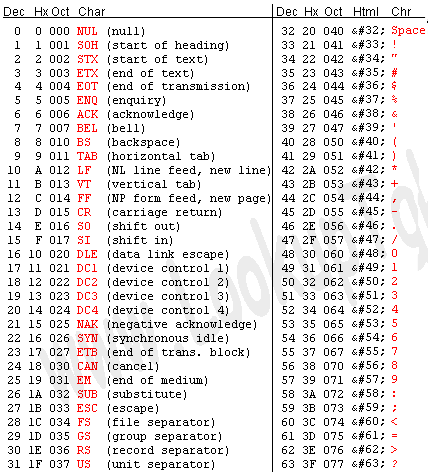

| ≡ | ⇧ |
Archbishops
| Canterbury | Justin Welby | 2013 | |
| Canterbury | Rowan Williams | 2002 | |
| Canterbury | George Carey | 1991 | |
| Canterbury | Robert Runcie | 1980 | |
| Canterbury | Donald Coggan | 1974 | |
| Canterbury | Arthur Ramsay | 1961 | |
| Canterbury | Geoffrey Fisher | 1945 | |
| Canterbury | William Temple | 1942 | |
| Canterbury | Cosmo Lang | 1928 | |
| Canterbury | Randall Davidson | 1903 | |
| York | Cosmo Gordon Lang | 1908 | |
| York | William Temple | 1929 | |
| York | Cyril Garbett | 1942 | |
| York | Arthur Ramsey | 1956 | |
| York | Donald Coggan | 1961 | |
| York | Stuart Blanch | 1975 | |
| York | John Habgood | 1983 | |
| York | David Hope | 1995 | |
| York | John Sentamu | 2005 | |
| York | Stephen Cottrell | 2020 |
| ≡ | ⇧ |
Basket Ball Hoop heights
| 5-7 yr olds | 6'-0" |
| 8-10 yr olds | 8'-0" |
| 11 yr olds | 9'-0" |
| 12+ yr olds | 10'-0" |
| Ours | 7'-6" |
| ≡ | ⇧ |
Bed sizes
| Name | Size | Size |
|---|---|---|
| (cm) | (ft-in) | |
| Small single | 75 x 190 | 2-6 x 6-3 |
| Single | 90 x 190 | 3-0 x 6-3 |
| Euro single | 90 x 200 | 3-0 x 6-6 |
| Queen/Small double | 120 x 190 | 4-0 x 6-3 |
| Double | 135 x 190 | 4-6 x 6-3 |
| Euro double | 140 x 200 | 4-9 x 6-6 |
| King | 150 x 200 | 5-0 x 6-6 |
| Euro king | 160 x 200 | 5-3 x 6-6 |
| Super-king | 180 x 200 | 6-0 x 6-6 |
| Emperor | 200 x 200 | 6-6 x 6-6 |
| ≡ | ⇧ |
Bridges in NYC
| East River | Location | Connecting | Date built | Image |
|---|---|---|---|---|
| Brooklyn | Warren St | Lower Manhattan - Uptown Brooklyn | 1883 | 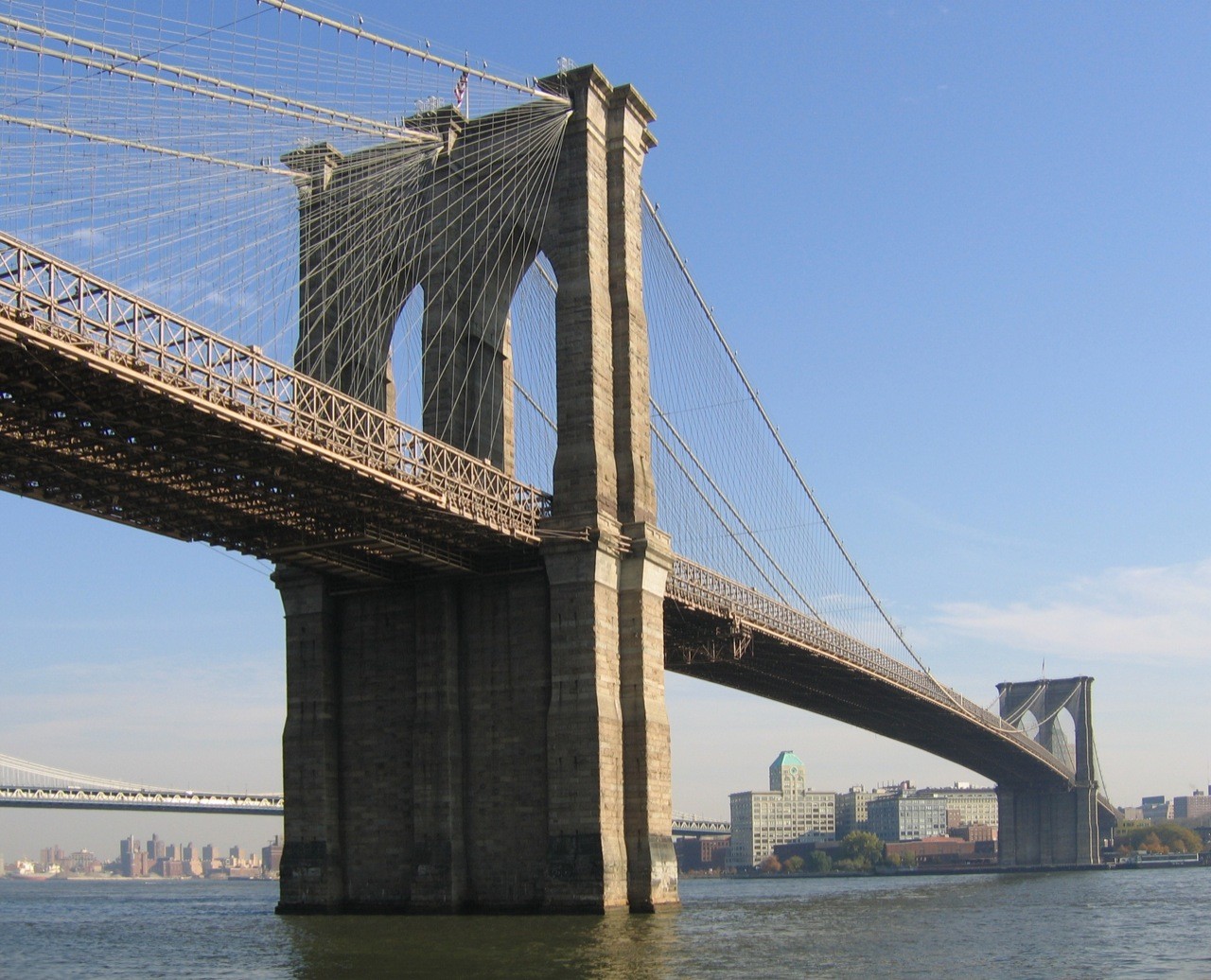 |
| Manhattan (dumbo) | Canal St | Lower Manhattan - Downtown Brooklyn | 1909 | 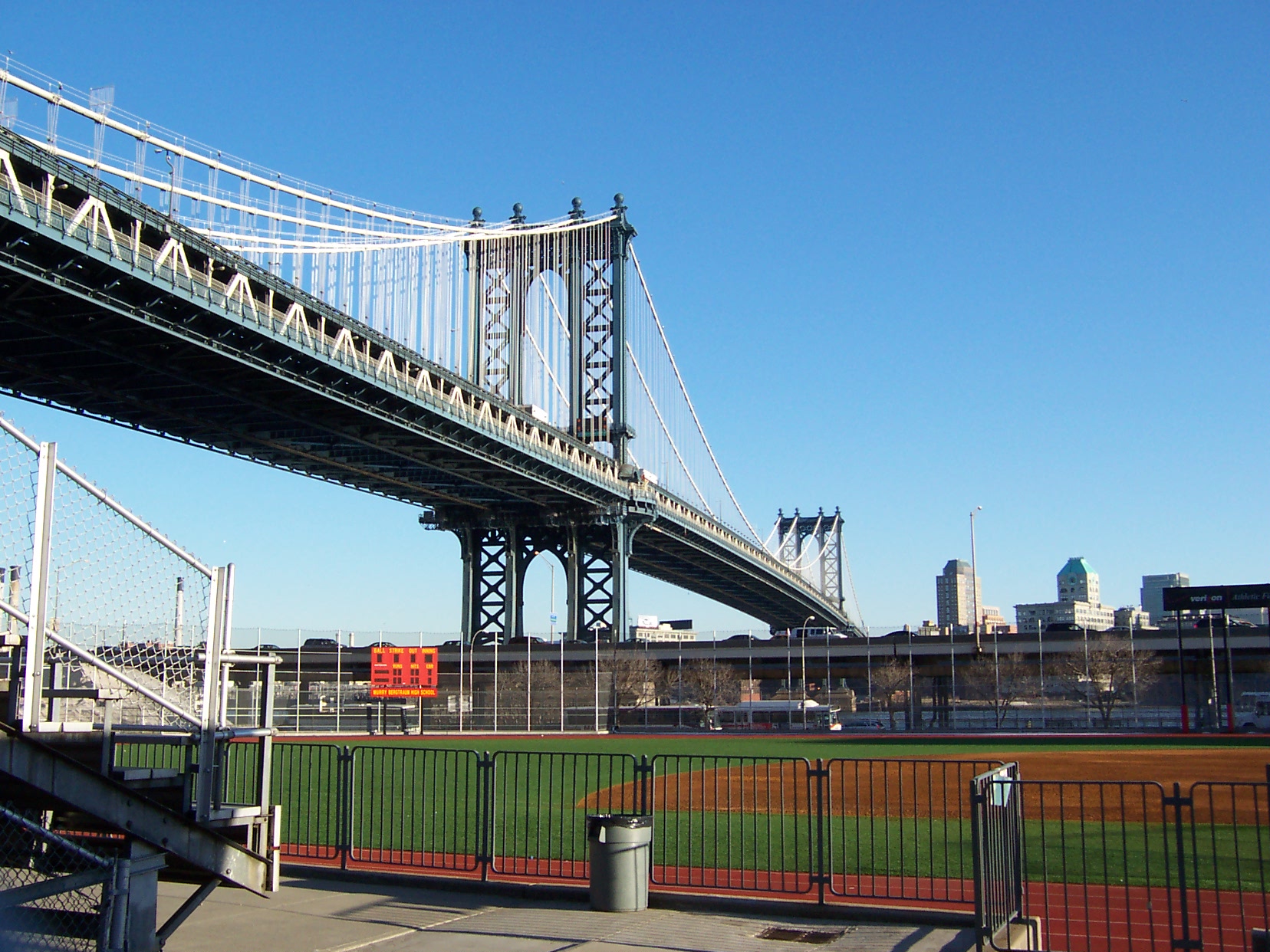 |
| Williamsburg | Delancey St | Lower East Side Manhattan - Brooklyn | 1903 |  |
| Queensboro | 60th St | East Midtown Manhattan - Long Island City, Queens | 1909 |  |
| Roosevelt Island | 63rd St | |||
| Triborough | ||||
| Hell Gate | ||||
| Rikers Island | ||||
| Bronx-Whitestone | ||||
| Throgs Neck | ||||
| Harlem River | Location | Connecting | Date built | Image |
| Wards Island | 103rd St | |||
| Triborough | ||||
| Triborough | ||||
| Willis Avenue | ||||
| Third Avenue | ||||
| Park Avenue | ||||
| Madison Avenue | ||||
| 145th Street | ||||
| Macombs Dam | ||||
| High | ||||
| Alexander Hamilton | ||||
| Washington | ||||
| University Heights | ||||
| Broadway | ||||
| Henry Hudson | ||||
| Spuyten Duyvil | ||||
| Hudson River | Location | Connecting | Date built | Image |
| George Washington | 168th St | Fort Lee, New Jersey - Washington Heights | 1927 | 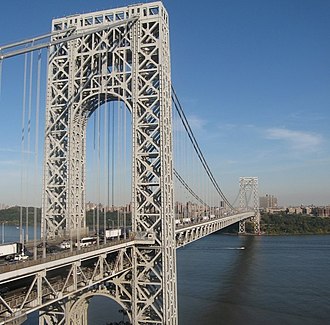 |
| Holland Tunnel | Spring St | Manhattan - New Jersey | 1927 |  |
| Lincoln Tunnel | 39st St | Manhattan - New Jersey | 1934 |  |
| The Bronx | Location | Connecting | Date built | Image |
| Robert F Kennedy | 31st St | • FDR Drive - Harlem River Drive in Manhattan • Bruckner Expressway (I-278) - Major Deegan Expressway (I-87) in the Bronx • Grand Central Parkway (I-278) - Astoria Boulevard in Queens | 1933 | 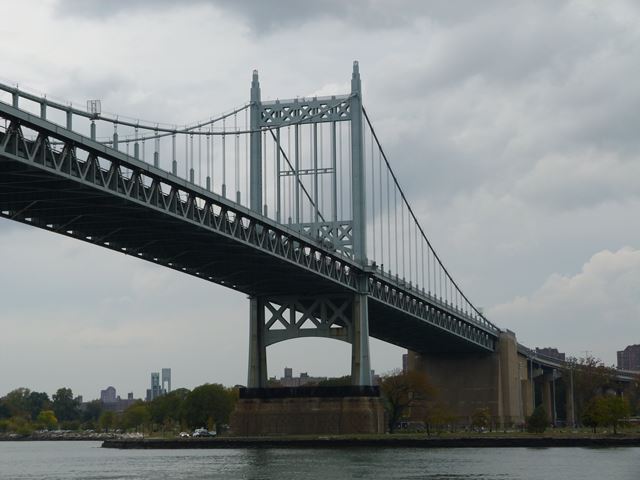 |
| Other | Location | Connecting | Date built | Image |
| Verrazzano Narrows | Delancey St | Staten Island - Brooklyn | 1964 |  |
| Goethals | Elizabeth | New Jersey - Staten Island | 1928 |  |
| ≡ | ⇧ |
Cables
Please note again that installation of cables depends on the position they are to be in, the temperature of the area or void, the length of the run, the grouping of the points they serve and the type of device (Fuse, RCD etc) by which they are protected. The first table below id for cables which are installed by method 4 " enclosed in an insulated wall" The second table is for cables installed by method 1, "clipped direct". As you can see there is quite a difference in rating so be absolutely sure you are doing the right thing. Also remember that while it is not an offence to make electrical installations yourself, it is an offence to use them without them having been checked by a qualified electrician. Even a simple socket addition now has to have a minor works certificate. Your house insurance may not be valid if you do not comply with the regulations.
Table 1 = Method 4 Encased in insulated wall
| Cable size |
Rating in Amps |
| 1mm | 11 |
| 1.5mm | 14 |
| 2.5mm | 18.5 |
| 4.00mm | 25 |
| 6.00mm | 32 |
| 10.00mm | 43 |
Table 2 = Method 1 Clipped Direct
| Cable size |
Rating in Amps |
| 1mm | 15 |
| 1.5mm | 19.5 |
| 2.5mm | 27 |
| 4mm | 36 |
| 6mm | 46 |
| 10mm | 63 |
Please check and double check that you are sure about what you are doing. It is an offence to install unchecked wiring and your house insurance may not be valid if you do.
| ≡ | ⇧ |
Roman Calendar
Julian Calendar
Gregorian Calendar
| Gregorian range | Julian range | Diff. |
| 15 Oct 1582 - 28 Feb 1700 | 5 Oct 1582 - 18 Feb 1700 | 10 days |
| 1 Mar 1700 - 28 Feb 1800 | 19 Feb 1700 - 17 Feb 1800 | 11 days |
| 1 Mar 1800 - 28 Feb 1900 | 18 Feb 1800 - 16 Feb 1900 | 12 days |
| 1 Mar 1900 - 28 Feb 2100 | 17 Feb 1900 - 15 Feb 2100 | 13 days |
| 1 Mar 2100 - 28 Feb 2200 | 16 Feb 2100 - 14 Feb 2200 | 14 days |
This section always places the intercalary day on 29 Feb even though it was always obtained by doubling 24 Feb (the bissextum (twice sixth) or bissextile day) until the late Middle Ages. The Gregorian calendar is proleptic before 1582 (calculated backwards on the same basis, for years before 1582), and the difference between Gregorian and Julian calendar dates increases by three days every four centuries (all date ranges are inclusive).
The following equation gives the number of days that the Gregorian calendar is ahead of the Julian calendar, called the "secular difference" between the two calendars. A negative difference means the Julian calendar is ahead of the Gregorian calendar.
D = int(Y/100) - int(Y/400) - 2
where
D is the secular difference and Y is the year using astronomical year numbering, that is, use 1 - (year BC) for BC years.
To make the calendar even more accurate, there have been suggestions that a leap day should be inserted every 4,000 years but variations in the earth's orbit and the length of the year make that non-sensical.
Great Britain adopted the Gregorian calendar in 1752 and, to synchronise with the rest of Europe, 2 Sep was followed by 14 Sep and New Year was moved to 1 Jan.
Anne Boleyn died on 19 May 1536 (Julian) - a date which could/should be referred to, today, as 2 Jun 1536.
| ≡ | ⇧ |
Car tyres
Tiguan tyres
| Type | 235/50 R19 99V |
| 235 | Tyre width |
| 50 | Aspect ratio (depth/width) |
| R | Construction (radial) |
| 19 | Diameter (inches) |
| 99 | Load index (775 kg) |
| V | Speed rating (149 mph) |
| ≡ | ⇧ |
Chinese Zodiac
| Rat | Ox | Tiger | Rabbit | Dragon | Snake | Horse | Goat | Monkey | Rooster | Dog | Pig |
|---|---|---|---|---|---|---|---|---|---|---|---|
| 2020 | 2021 | 2022 | 2023 | 2024 | 2025 | 2026 | 2027 | 2028 | 2029 | 2030 | 2031 |
| 2008 | 2009 | 2010 | 2011 | 2012 | 2013 | 2014 | 2015 | 2016 | 2017 | 2018 | 2019 |
| 1996 | 1997 | 1998 | 1999 | 2000 | 2001 | 2002 | 2003 | 2004 | 2005 | 2006 | 2007 |
| 1984 | 1985 | 1986 | 1987 | 1988 | 1989 | 1990 | 1991 | 1992 | 1993 | 1994 | 1995 |
| 1972 | 1973 | 1974 | 1975 | 1976 | 1977 | 1978 | 1979 | 1980 | 1981 | 1982 | 1983 |
| 1960 | 1961 | 1962 | 1963 | 1964 | 1965 | 1966 | 1967 | 1968 | 1969 | 1970 | 1971 |
| 1948 | 1949 | 1950 | 1951 | 1952 | 1953 | 1954 | 1955 | 1956 | 1957 | 1958 | 1959 |
| 1936 | 1937 | 1938 | 1939 | 1940 | 1941 | 1942 | 1943 | 1944 | 1945 | 1946 | 1947 |
| ≡ | ⇧ |
Commercial leases
A Lease defines:
- Contractual Term
- Annual Rent
- Break Date - a date when the landlord or tenant can terminate the lease early
- Break Notice - the amount of notice to be given before termination on the Break Date
- Default Interest Rate
The tenant can terminate at break date by giving [] months notice
The tenant can extend the lease by serving a Section 26 Notice to the landlord at least 6 months before the termination of the lease.
The notice should propose a new lease term, rent and any break clauses.
The landlord must respond to this within 2 months.
Legal Framework
- Landlord and Tenant Act 1954
- Commercial Property Lease Extension UK
| ≡ | ⇧ |
CSS
Selectors
- Element - All occurrences affected
- img {
- width: 100%;
- }
- <img src="fred.jpg" />
- Called by ID
- #para1 {
- width: 100%;
- }
- <#img id="para1" src="fred.jpg" />
- Called by Class
- .para1 or say p.para1 {
- width: 100%;
- }
- <#img class="para1" src="fred.jpg" />
- Universal - All HTML elements will be affected
- * {
- color: blue;
- }
| ≡ | ⇧ |
Curaprox


We usually get: CPS 07 (Red), CPS 12 (Blue), CPS 14Z (Orange)
Buy from: here
| ≡ | ⇧ |
7 Deadly Sins
- Pride
- Greed
- Lust
- Envy
- Gluttony
- Wrath
- Sloth
- Humility
- Charity
- Chastity
- Gratitude
- Temperance
- Patience
- Diligence
| ≡ | ⇧ |
Dogs' Ages
Now the consensus is slightly different:
| Human age | Dog age (old) | Dog age (new) |
|---|---|---|
| 1 | (+7) 7 | (+15) 15 |
| 2 | (+7) 14 | (+9) 24 |
| 3 | (+7) 21 | (+5) 29 |
| 4 | (+7) 28 | (+5) 34 |
| 5 | (+7) 35 | (+5) 39 |
| 6 | (+7) 42 | (+5) 44 |
| 7 | (+7) 49 | (+5) 49 |
| 8 | (+7) 56 | (+5) 54 |
| 9 | (+7) 63 | (+5) 59 |
| 10 | (+7) 70 | (+5) 64 |
| 11 | (+7) 77 | (+5) 69 |
| 12 | (+7) 84 | (+5) 74 |
| ≡ | ⇧ |
Easter
The earliest Easter can be is 22nd March - the last occurrence was in 1818 and the next will be in 2285
The latest Easter can be is 25th April - the last occurrence was in 1943 and the next will be in 2038
Easter Days
| Year | Gregorian Easter | Julian Easter |
|---|---|---|
| 2024 | March 31 | May 5 |
| 2025 | April 20 | |
| 2026 | April 5 | April 12 |
| 2027 | March 28 | May 2 |
| 2028 | April 16 | |
| 2029 | April 1 | April 8 |
| 2030 | April 21 | April 28 |
| 2031 | April 13 | |
| 2032 | March 28 | May 2 |
| 2033 | April 17 | April 5 |
| 2034 | April 9 | |
| 2035 | March 25 | April 29 |
| 2036 | April 13 | |
| 2037 | April 5 | |
| 2038 | April 25 | |
| 2039 | April 10 | April 17 |
The Julian calendar is 13 days after the Gregorian calendar
| ≡ | ⇧ |
Education
| Year | Who | School |
|---|---|---|
| 1954-59 | Dick | Fernden, Haslemere |
| 1959-63 | Dick | Stowe, Buckingham |
| 1963-64 | Dick | Eastleigh Tech. |
| 1957-60 | Helen | Otford Primary |
| 1960-68 | Helen | St Agnes & St St Michael, East Grinstead |
| 1968-69 | Helen | Lewis Technical College |
| 1969-70 | Helen | Tunbridge Wells Secretarial |
| 1983-84 | Becky | Cottenham Primary |
| 1984-87 | Becky | Acremont, Ely |
| 1984-87 | Simon | Acremont, Ely |
| 1987-91 | Becky | Kings, Ely |
| 1987-91 | Simon | Kings, Ely |
| 1991-91 | Becky | Oundle |
| 1991-96 | Simon | Winchester House, Brackley |
| 1991-96 | Edward | Winchester House, Brackley |
| 1987-91 | Simon | Stowe, Buckingham |
| 1992-94 | Becky | Northampton Girls |
| 1994-96 | Becky | Stowe, Buckingham |
| 1994-96 | Edward | Stowe, Buckingham |
| 1994-96 | Edward | Sponne, Towcester |
| 1987-91 | Simon | University of Edinburgh |
| 1994 | Becky | University of Surrey |
| 1994-96 | Becky | University of Teesside |
| ≡ | ⇧ |
Eleanor crosses
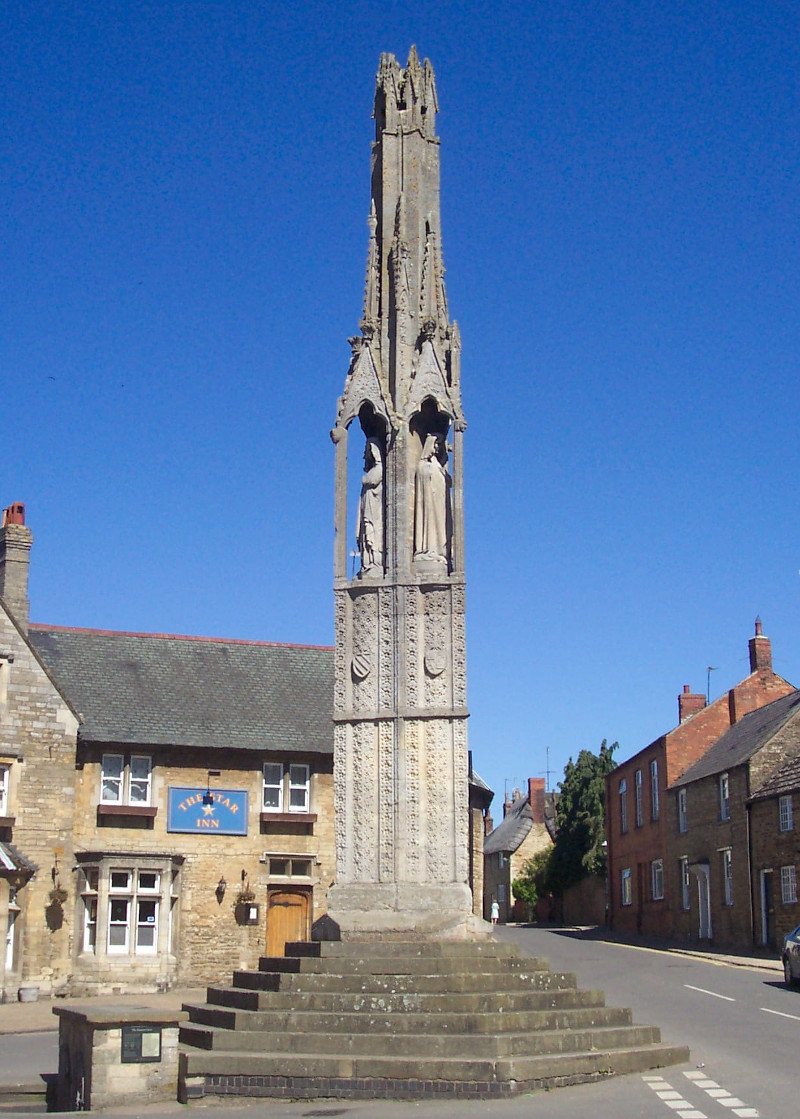 |
Today only those at Geddington, Hardingstone near Northampton and Waltham Cross still remain.
The Eleanor Cross in the village of Geddington, just off the A43 between Corby and Kettering, is original and maintained by English Heritage. The cross is situated off the main road by the church and close to the pretty 12th century bridge and ford over the River Ise.
Geddington Eleanor Cross CC BY-SA 3.0: Lofty at English Wikipedia
The cross at Stony Stratford stood at the North end of the town but was demolished during the Civil War in the 1600s.
In London, the tall monument that stands in the forecourt of the Charing Cross railway station is a Victorian replica of the one that originally stood at the top of Whitehall. The site in Whitehall is now occupied by a statue of Charles I on horseback.
It appears that Edward really loved his wife, as he ordered that two wax candles were to burn for all time beside her tomb in Westminster Abbey. They burned for two and half centuries, and were extinguished only at the time of the Reformation.
| ≡ | ⇧ |
Equine Honours
Green - young
Pink - mare in season
Red - horses that kick
White - for sale
| ≡ | ⇧ |
Generations
| Nick-name | Dates | Characteristics |
|---|---|---|
| Lost generation | 1883-1900 | |
| Interbellum generation | 1901-1913 | |
| Greatest generation | 1910-1924 | |
| Silent generation | 1925-1945 | |
| Baby boomers | 1946-1964 | |
| Gen X | 1965-1979 | |
| Xennials | 1975-1985 | |
| Millennials (Gen Y) | 1980-1994 | |
| Gen Z | 1995-2012 | |
| Gen Alpha | 2013-2025 | |
| Gen Bets | 2025-2039 |
| ≡ | ⇧ |
Gunpowder Plot
Margaret Clitherow (the Pearl of York) used to shelter Catholic priests but, in 1584, this was made a capital offence.
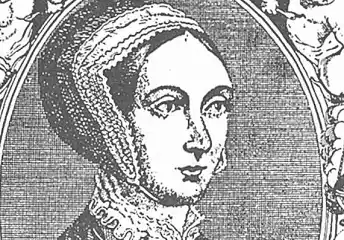 |
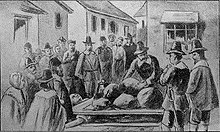 |
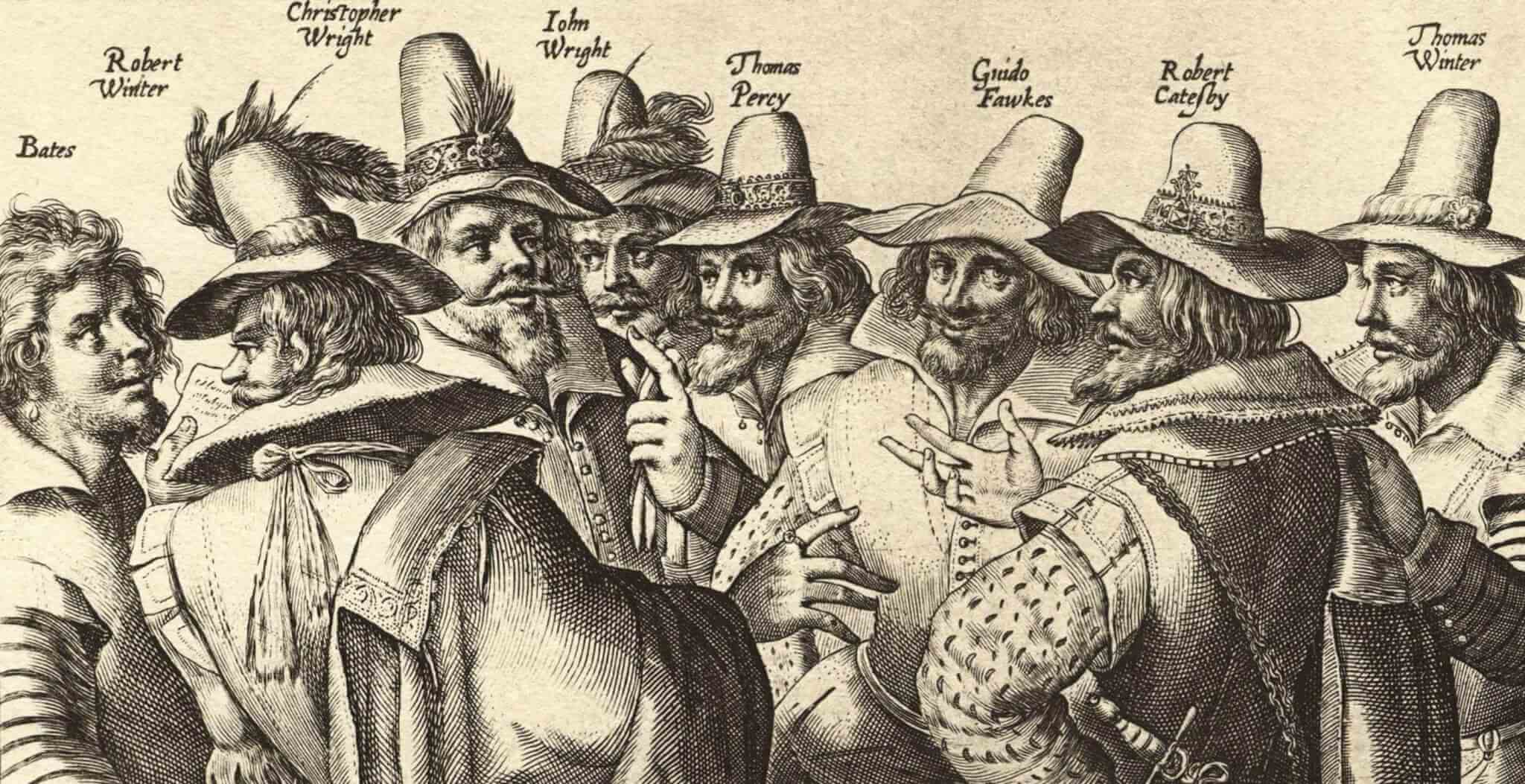 |
Someone leaked the plot (on 26 Oct) and the King ordered a search. On the night of 4 Nov 1605, Guy Fawkes was caught guarding the gunpowder in the cellar and he was 'interrogated' about his co-conspirators. The first day, he told more-or-less what they already knew and signed a record of what they had written of the information. Two days later, he couldn't sign his name (probably because he had been put under a thumb screw or the rack).
On 27 Jan 1606, all the men were convicted and sentenced to be hanged, drawn and quartered. The executions took place on 30 and 31 Jan 1606 - Guy Fawkes was on the 31st.
In Jan 1606, but before the men's execution, the King enacted the Thanksgiving Act to the effect that everyone must celebrate 5th Nov every year to honour the King for 'saving' the church and country from a Catholic revolt. The Act remained in place until 1859.
| ≡ | ⇧ |
Hallmarks
A typical hallmark has a maker, a measure of fineness, assay office and a date letter (optional since 1998)
| Maker | Purity | Assay office | Date letter |
 |  |  |  |
The assay offices which cary out hallmarking are:
| Birmingham | Edinburgh | London | Sheffield |
 |
 |
 |
 |
The purity of the metal is shown in partss/1000 and the background shape denotes the metal
| Gold | |||||
 9 carat |
 14 carat |
 18 carat |
 22 carat |
 |
 |
| Silver | |||||
 |
 Sterling |
 Britannia |
 |
||
| Platinum | |||||
 |
 |
 |
 |
||
| Palladium | |||||
| 2009 |  |
||||
| 2010 |  |
||||
For instance, my signet ring
 |
 |
 |
R |
And the silver-gilt cup (given to us by John Brocklehurst from Hennells)
| GOLDEMANN | ||
| HAMBURG | ||
| 925 | ||
| ≡ | ⇧ |
Long & Short-drop hanging
| Body weight | 1888 drop | 1892 drop | 1913 drop | 1939 drop | 1913 drop |
|---|---|---|---|---|---|
| (kg) | (cms) | (cms) | (cms) | (unofficial) | (cms/kg) |
| 51 | 305 | 229 | 259 | 282 | 5.08 |
| 54 | 297 | 215 | 257 | 280 | 4.76 |
| 57 | 293 | 203 | 241 | 264 | 4.23 |
| 60.25 | 282 | 192 | 229 | 252 | 3.80 |
| 63.5 | 274 | 183 | 218 | 241 | 3.43 |
| 66.67 | 262 | 174 | 207 | 230 | 3.10 |
| 70 | 249 | 165 | 198 | 221 | 2.83 |
| 73 | 239 | 159 | 189 | 212 | 2.59 |
| 76.25 | 229 | 152 | 182 | 205 | 2.38 |
| 79.25 | 221 | 146 | 174 | 197 | 2.19 |
| 82.5 | 211 | 140 | 168 | 191 | 2.04 |
| 86 | 203 | 135 | 161 | 184 | 1.87 |
| 89 | 196 | 131 | 155 | 178 | 1.74 |
The 1888 table was compiled to give a drop energy of 1,710 J; in 1892 this was revised to give 1,140 J; finally, the 1913 table was compiled to give an energy of 1,400 J.
However, from 1939, executioners routinely added 23cms to the drops.
| ≡ | ⇧ |
Heating
| Room | 01 | 02 | 03 | 04 | 05 | 06 | 07 | 08 | 09 | 10 | 11 | 12 | 13 | 14 | 15 | 16 | 17 | 18 | 19 | 20 | 21 | 22 | 23 | 24 | ||||||||||||||||||||||||||||
|---|---|---|---|---|---|---|---|---|---|---|---|---|---|---|---|---|---|---|---|---|---|---|---|---|---|---|---|---|---|---|---|---|---|---|---|---|---|---|---|---|---|---|---|---|---|---|---|---|---|---|---|---|
| Top landing | ||||||||||||||||||||||||||||||||||||||||||||||||||||
| Bed 2 | ||||||||||||||||||||||||||||||||||||||||||||||||||||
| Bed 3 | ||||||||||||||||||||||||||||||||||||||||||||||||||||
| Bed 4 | ||||||||||||||||||||||||||||||||||||||||||||||||||||
| Suitcase room | ||||||||||||||||||||||||||||||||||||||||||||||||||||
| Middle landing | ||||||||||||||||||||||||||||||||||||||||||||||||||||
| Bed 1 | ||||||||||||||||||||||||||||||||||||||||||||||||||||
| Bed 5 | ||||||||||||||||||||||||||||||||||||||||||||||||||||
| Drawing room | ||||||||||||||||||||||||||||||||||||||||||||||||||||
| Kitchen | ||||||||||||||||||||||||||||||||||||||||||||||||||||
| Hall | ||||||||||||||||||||||||||||||||||||||||||||||||||||
| Bakery | ||||||||||||||||||||||||||||||||||||||||||||||||||||
| Hot water | ||||||||||||||||||||||||||||||||||||||||||||||||||||
| Room | 01 | 02 | 03 | 04 | 05 | 06 | 07 | 08 | 09 | 10 | 11 | 12 | 13 | 14 | 15 | 16 | 17 | 18 | 19 | 20 | 21 | 22 | 23 | 24 | ||||||||||||||||||||||||||||
| Warm | 21/22° | |||||||||||||||||||||||||||||||||||||||||||||||||||
| Medium | 18° | |||||||||||||||||||||||||||||||||||||||||||||||||||
| Cool | 12/15° | |||||||||||||||||||||||||||||||||||||||||||||||||||
| ≡ | ⇧ |
Holidays
| 1976 | Naples |
| 1999 | Dominican Republic |
| 2000 | Passau |
| 2002 | Exmoor |
| 2002 | Germany |
| 2003 | New York |
| 2003 | Salisbury |
| 2004 | Paris |
| 2004 | Türkey |
| 2005 | Scotland |
| 2005 | Thailand |
| 2005 | Valencia (B) |
| 2006 | Scotland |
| 2007 | Menorca |
| 2008 | Barcelona |
| 2008 | Kenya |
| 2008 | Mumbai and Goa (B) |
| 2009 | Carvoeiro (B) |
| 2009 | Cruise (Baltic) |
| 2010 | Anna Macdonald |
| 2010 | Liverpool |
| 2011 | Ironbridge |
| 2011 | Isle of Wight |
| 2011 | London |
| 2011 | Scotland |
| 2011 | Stoke Bruerne |
| 2012 | Tuscany |
| 2013 | Cruise (Black Sea) |
| 2014 | Italy (B) |
| 2014 | New York |
| 2015 | Devon |
| 2015 | Devon and Cornwall (E) |
| 2015 | Hastings |
| 2015 | Malta |
| 2015 | Penang (B) |
| 2015 | Rye |
| 2016 | Savoy |
| 2017 | Dartmouth |
| 2017 | Hamburg and Lübeck |
| 2017 | Lyme Regis |
| 2017 | Menorca |
| 2017 | New York |
| 2018 | Agadir |
| 2018 | Interlaken |
| 2019 | New York |
| 2021 | Gulliver's Dinosaur Farm |
| 2021 | Hastings |
| 2022 | Montenegro |
| 2022 | New York |
| 2023 | Tourtour |
| 2024 | Cruise (Shetlands) |
| 2025 | O2 roof |
| 2025 | New York |
| ≡ | ⇧ |
Homes
| Year | Daddy's job | School / Job | Address | Notes |
|---|---|---|---|---|
| 1944 | Lt. Commander | Awarded the OBE. Married Bunty MacMurray. | ||
| 1945 | Promoted Commander. Bath | St Francis Hotel, Bath. 3 Lansdowne Crescent. | ||
| 1946 | 1 Oldfield Park. | Gilbert & Peggy Watley. Dick born. | ||
| Apr-Jan | 2 Camden Street. | |||
| Courses | 3 9 Windsor Crescent, Newcastle, NE5 2LU. 4 Queen Elms Square, Chelsea. | Stayed with Grandpa. Stayed with Kenneth. | ||
| 1947/1949 | Malta | 5 Xara Palace, Mdina, Malta. | Top flat. | |
| 1949/50 | HMS Collingwood | 6 Commander's House Collingwood, PO14 1AS. 7 Grotton House, Fareham. 8 9 Windsor Crescent, Newcastle. | Sue born. Lilla died. | |
| 1953 | Teddington | Rowan Brae | 9 Hotel in Esher. 10 Oak Tree House, Claygate, KT10 0JP. | |
| Clarence Yard Reserve Fleet | 11 Mayfield, Stubbington. 12 Hill House, Titchfield. | |||
| 1954 | Fernden | 13 Crofton Old Farm, Titchfield. | ||
| 1955/57 | HMS Ariel | 14 Captain's House, Worthy Down, SO21 2RG. | ||
| 1957/59 | HMS Collingwood | 15 Captain's House, Collingwood, PO14 1AS. 16 Willow Bank, Titchfield. | ||
| 1959/63 | C-in-C staff | Stowe | 17 Chestnuts, St Cross, SO23 9RE. | AJ's flat mid-week. |
| 1964 | 18 The Lodge, Itchen Abbas. | |||
| 1965 | 19 The Hurst, Abbots Worthy. | |||
| Bunty at: Lougee's "rubber house". | ||||
| Bunty at: 2 Harestock Close, SO22 6NP. | ||||
| 1985-2003 | Bunty at: Church Lane, Romsey. | |||
| 10/65-7/66 | Bristol | 20 Wills Hall. | Alone. | |
| 10/66-7/67 | 21 34 Ambrose Road. | With George Ferguson. | ||
| 10/67-7/68 | 22 29 Alfred Hill. | With D'Arcy & Higlett. | ||
| 7/68-7/69 | NCC | 23 75 Forrest Road East, Nottingham. | Alone. | |
| 69-71? | Bristol | 24 19 Bellevue Crescent, Bristol. | Alone. | |
| 71-73? | 25 14 Freeland Place, Bristol. | Alone. | ||
| 73-76 | 26 93 Chesterton Road, W11. | With Melanie et al. | ||
| 76 | 27 1a Kensington Place | With Bel. | ||
| 76-78 | 28 16 Southolm Street. | With Bel. Beck born. | ||
| 78-84 | ARC | 29 85 Rooks Street, Cottenham. | Si born. Edward born. | |
| 84-92 | Barclays Badderleys | 30 Old Rectory, Southery. | With Bel. | |
| 92-96 | Building Information. Quorum. | 31 Mill House, Slapton. | ||
| 96-99 | 32 2 Mulberry Close, Dallington. | With Bel. | ||
| 99-16 | Post Consulting Architectural Ideas | 33 3 Langham Place, Northampton. | ||
| 2003-06 | Bunty at: Evergreens, Wormley. | |||
| 2006-09 | Bunty at: 3 Langham Place, Northampton. | |||
| 2009-13 | Bunty at: Symphony House, Northampton. | |||
| 2016 | 34 Walnut House, 73 High Street, Stony Stratford. | Retired. Rebuilt house after a fire. |
| ≡ | ⇧ |
Honours system
◼ The Most Excellent Order of the British Empire
- Dame/Knight Grand Cross (GBE)
- Damehood/Knighthood (DBE/KBE)
- Commander of the British Empire (CBE)
- Officer of the Order of the British Empire (OBE)
- Member of the Order of the British Empire (MBE)
- British Empire Medal (BEM)
- Dame/Knight Grand Cross (GCB)
- Knight/Dame Commander (KCB/DCB)
- Companion (CB)
- Companion of Honour (CH)
- Knight/Dame Grand Cross of (GCVO)
- Knight/Dame Commander (KCVO/DCVO)
- Commander CVO)
- Lieutenant (LVO)
- Member (MVO)
- Medal (RVM)
- Knight/Dame Grand Cross of (KCMG)
- Knight/Dame Commander of (KCMGVO/DCMG)
- Companion of (CMG)
- Lieutenant (LVO)
- Member (MVO)
- Medal (RVM)
◼ The Most Honourable Order of the Bath
- Knight/Dame Grand Cross (GCB)
- Knight/Dame Commander (KCB/DCB)
- Companion (CB)
◼ The Most Nobel Order of the Garter
| ≡ | ⇧ |
Jack the Ripper
- Emma Elizabeth Smith
- Robbed and assaulted in Osborn Street, 3 Apr 1888.
- A blunt object had been inserted into her vagina and she died in hospital the next day.
- She said she'd been attacked by two or three men.
- Martha Tabram
- Murdered on a staircase in George Yard on 7 Aug 1888.
- She had 39 stab wounds and additional knife wounds.
(a term coined by the late Martin Fido in 1987)
- Mary Anne (aka Polly) Nichols
- Murdered in Buck's Row (now Durward Street) on 31 Aug 1888.
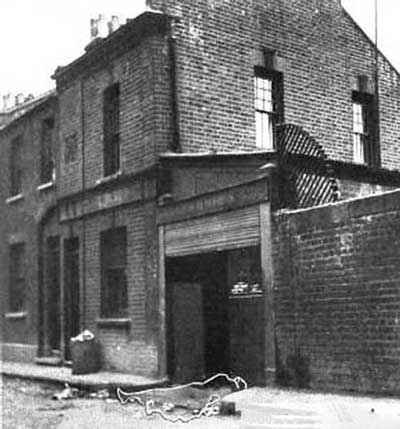
Buck's Row
- Her throat was cut and she was mutilated with her abdomen cut open.
- Annie Chapman
- Murdered near steps to the back yard of 29 Hanbury Street on 8 Sep 1888.

Back yard, 29 Hanbury Street
- Her throat had been cut; flesh from her abdomen had been put above her left and right shoulders and her uterus had been removed.
- Elizabeth Stride
.jpg)
Dutfield's yard (off berner Street)
- Murdered at Dutfield's Yard, off Berner Street (now Henriques Street) on 30 Sep 1888.
- Her throat had been cut. There were no other cuts - the murderer was possibly interrupted.
- Catherine Eddowes
- Murdered 15 minutes later at Mitre Square in the City.
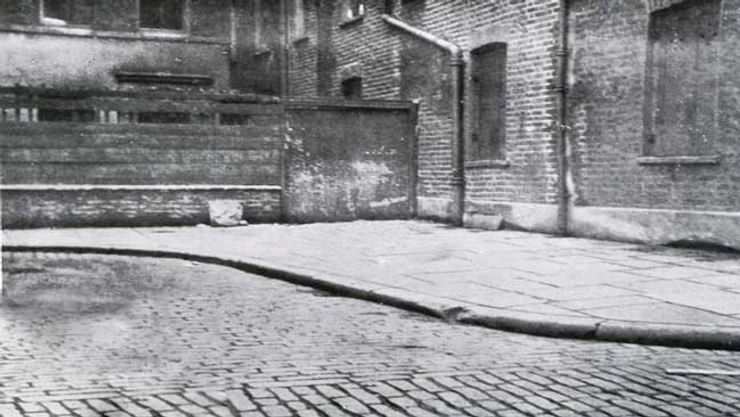
Mitre Square
- Her throat was cut; her abdomen was ripped open and her intestines removed. The left kidney and her uterus had been removed. Her face had been badly disfigured.
- Mary Jane Kelly
- Murdered in bed at 13 Miller's Court off Dorset Street on 9 Nov 1888.
.jpg)
13 Millers Court (off Dorset St)
- Her throat was cut; her face was disfigured to the point of being unrecognisable and her heart was missing.
- Rose Mylett
- Strangled in Clarke's Yard, Poplar on 20 Dec 1888.
- Police think she may have committed suicide.
- Alice McKenzie
- Murdered at Castle Alley on 17 Jul 1889.
- She had two stab wounds to the neck.
- The Pinchin Street torso
- A headless and legless body found under a railway arch at Pinchin Street on 10 Sep 1889.
- The abdomen was extensively mutilated.
- Frances Coles
- Murdered under a railway arch at Swallow Gardens on 13 Feb 1891.
- Her throat had been cut but the body was otherwise unmutilated.
The term Jack the Ripper comes from a letter, written in red ink and admitting to the murders, which was signed Jack the Ripper. The letter is now thought to be a hoax but the name has stuck.
| ≡ | ⇧ |
Lumens
| Lumen value | 220- 375 | 400- 500 | 700- 900 | 900- 1125 | 1300- 1500 | |
| Tungsten | 25W | 40W | 60W | 75W | 100W | |
| Halogen | 18W | 28W | 42W | 53W | 70W | |
| CFL | 6W | 9W | 12W | 15W | 20W | |
| LED | 4W | 6W | 10W | 13W | 18W | |
| ≡ | ⇧ |
Health / Medical
Blood pressure
The two main measures of day-to-day heart condition are blood pressure and pulse rate. Blood pressure is measured in two ways - the Systolic pressure, when the valves are open and the heart is pumping blood, and the Diastolic pressure, when the valves are closed and the heart is recovering. The pulse rate is measured in beats per minute. Sometimes the ideal is computed as 220 - age. (220-79=141)'Normal' blood pressures are as follows:
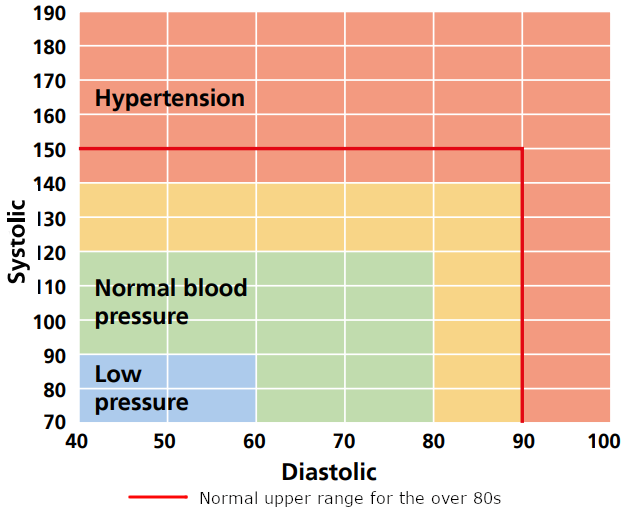
My typical values are:
| Systolic | Diastolic | BPM |
|---|---|---|
| 130 | 82 | 53 |
| 138 | 86 | 50 |
| 132 | 87 | 50 |
| 134 | 83 | 49 |
BMI
Body Mass Index (BMI) is a fairly crude measure of general fitness. It is calculated by taking the body weight in kilograms and dividing by the sqaure of the height in meters. So, if I weighed 80kg and I'm 1.75m tall, my BMI would be 80 / 1.75 x 1.75 = 26.73Over time, my records are:
| Date | Weight | Muscle | Muscle | Bone | Fat | Total | Water | BMI |
|---|---|---|---|---|---|---|---|---|
| (lbs) a | (lbs) b | (%) c=b% of a | (%) d | (%) e | (lbs) f=c+d+e | (%) g | (kg/m2) h | |
| 01-04-'22 | 206.0 | 30.5 | ||||||
| 21-10-'22 | 170.0 | 25.1 | ||||||
| 19-01-'23 | 168.3 | 119.1 | 70.8 | 6.3 | 25.5 | 102.4 | 49.8 | 24.6 |
| 01-02-'24 | 179.4 | 123.1 | 68.6 | 6.1 | 29.9 | 104.6 | 47.8 | 26.9 |
| 01-02-'25 | 184.0 | 123.4 | 67.1 | 6.5 | 29.9 | 103.5 | 47.8 | 26.9 |
| 04-02-'25 | 184.4 | 121.8 | 66.1 | 6.4 | 30.4 | 102.9 | 47.5 | 27.0 |
| 05-02-'25 | 182.7 | 122.0 | 66.8 | 6.4 | 29.6 | 102.8 | 47.9 | 26.7 |
| 06-02-'25 | 183.7 | 121.0 | 65.9 | 6.4 | 30.6 | 102.9 | 47.4 | 26.9 |
Bones
Very few bones have been broken. The only ones were:RDP Left Ulna and Radius - Summer 1954
HMJP Right Tibia and Fibula - 1996
ECP Pelvis - 3-Aug-2012
Cardiology
Following a severe leg wound in August 2018, it was found that I had Tachycardia (fast) and Bradycardia (slow) which meant I could not be given a general anaesthetic for surgery. I therefore had to have an epidural.- 23-Apr-2019
- Check at Whaddon Centre
- 14-Nov-2020
- Echocardiogram
- 17-Dec-2020
- ECG
Atorvastatin for Cholesterol.
Following a weight loss of 40lbs I was allowed to stop the Ramipril but the statins continue indefinitely.
Eyesight
cataract surgery in the left eye - 6th July 2023.lens model: adapt-a0
power: 21.5d
p.c.iol placement: capsular bag
s/n: 12309523177
length (0t): 10.70mm
optic(08): 6.00mm
physician: m. khan
Latest eye test: 20th Dec 2023
| Right | Left | |||||||||
|---|---|---|---|---|---|---|---|---|---|---|
| SPH | CYL | AXIS | H'PRISM | V'PRISM | SPH | CYL | AXIS | H'PRISM | V'PRISM | |
| +1.5 | -0.5 | 120 | DIST | -0.5 | 100 | |||||
| Add 2.5 | Near | Add 2.50 | ||||||||
| REMARKS: Inter add +1.75 R+L | ||||||||||
| SPH | CYL | AXIS | H'PRISM | V'PRISM | SPH | CYL | AXIS | H'PRISM | V'PRISM | |
Hearing
Last hearing test showed the left ear less responsive than the right.Oticon hearings (deaf) aids seek to amplify the response at differnt frequencies to bring the whole aural response up to level.
14-May-2024:
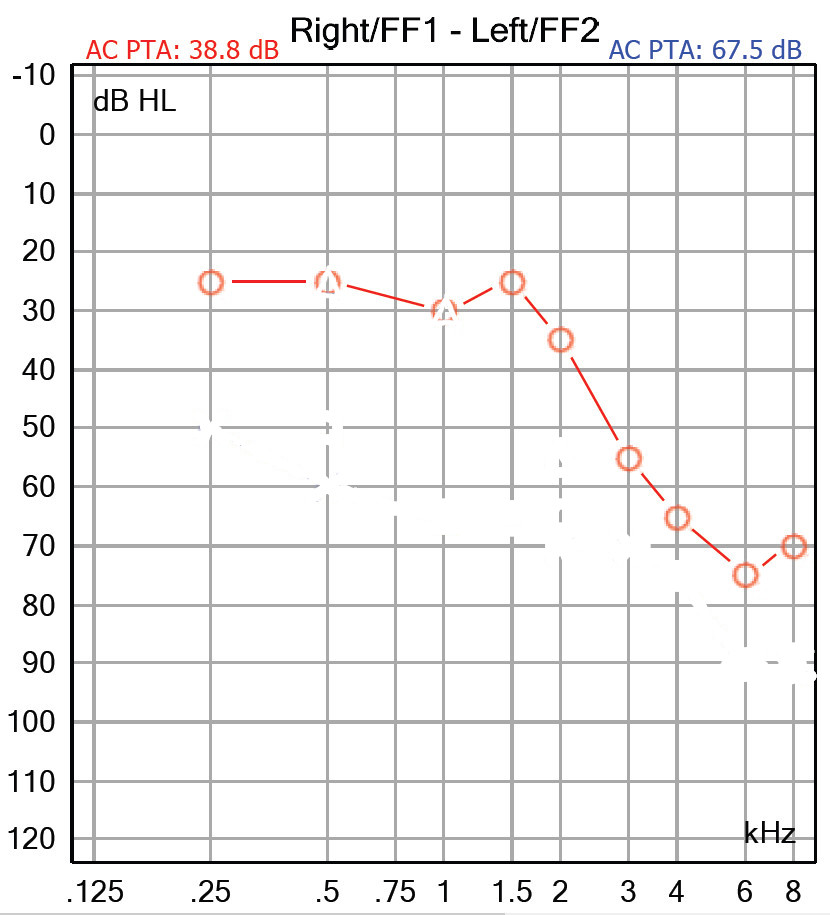 Right ear |
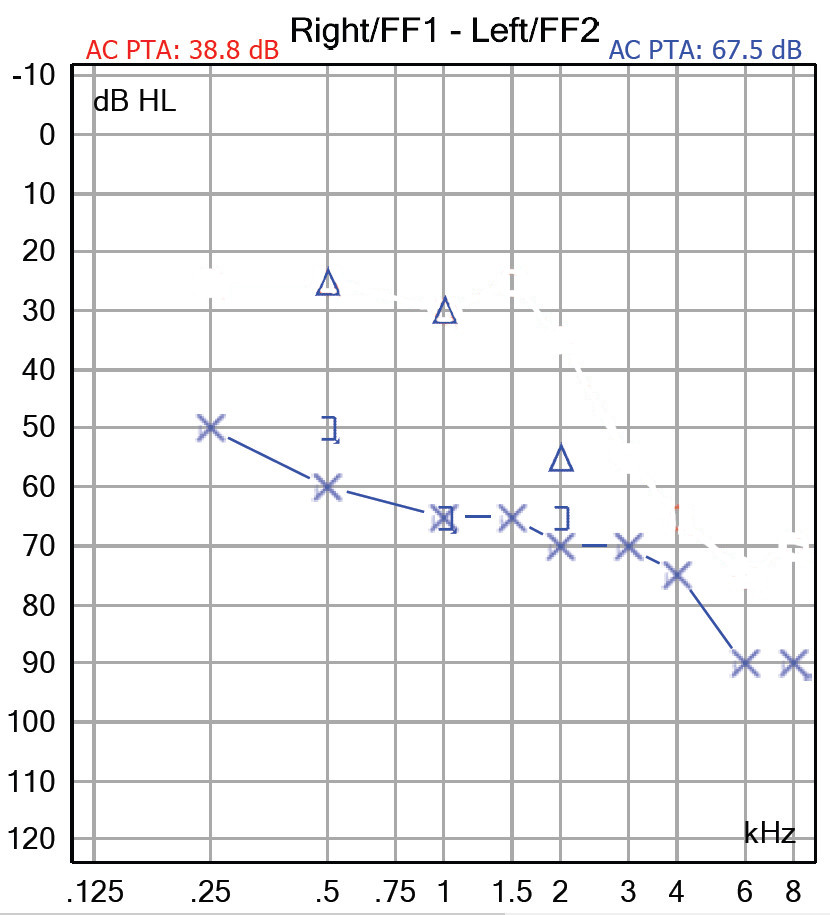 Left ear |
1-Apr-2025:
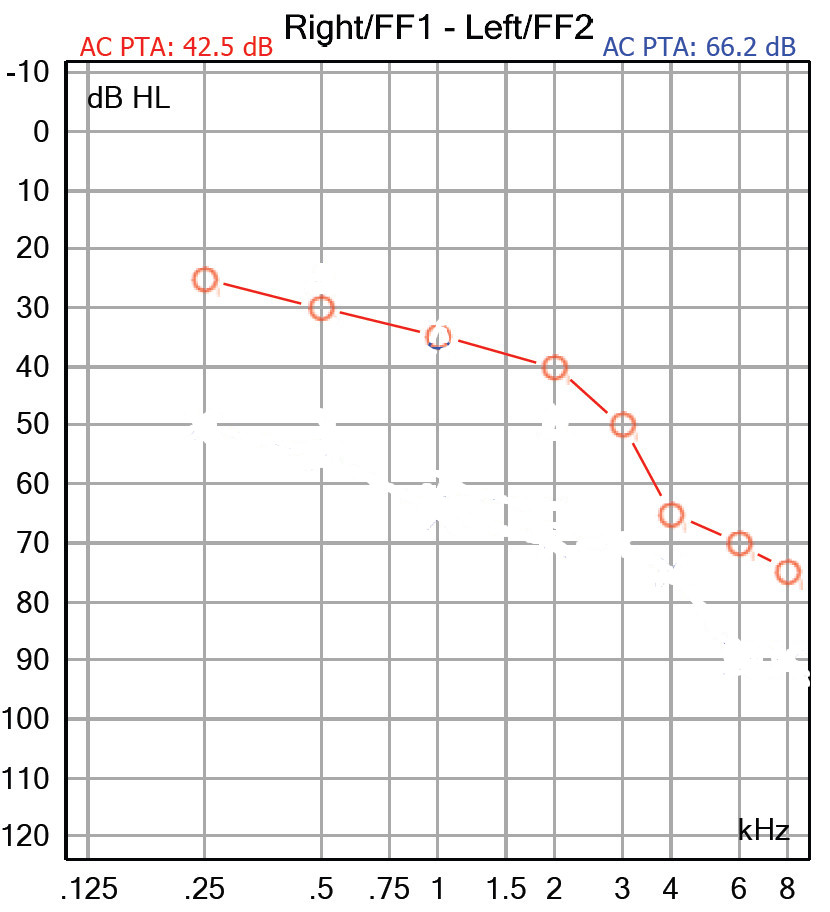 Right ear |
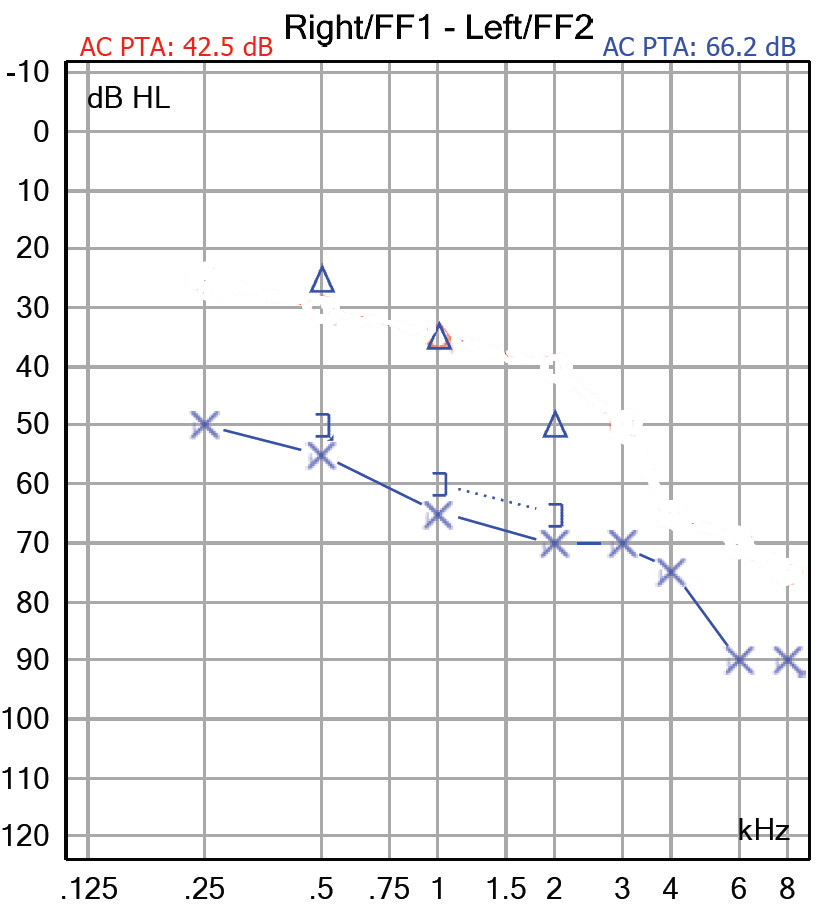 Left ear |
Vaccinations
I have had four type of vaccination: Covid, 'Flu, RSV (Respiratory Syncytial Virus) and Shingles as follows:| Date | Type | Code | Batch |
|---|---|---|---|
| Covid | |||
| 29 Jan 2021 | Vaxzevria | AZ (AstraZenaca)* | AB0005 |
| 22 Apr 2021 | Vaxzevria | AZ (AstraZenaca) | PV46677 |
| 06 Nov 2021 | Comirnaty | PF Pfizer) | FK0112 |
| 12 May 2022 | Spikevax | MO (Moderna) | 000084A |
| 15 Sep 2022 | Spikevax | MO (Moderna) | 20000SA |
| 05 May 2023 | PF Pfizer) | ||
| 11 Oct 2023 | PF Pfizer) | HG2272 | |
| 23 Apr 2024 | Spikevax | MO (Moderna) | |
| 08 Oct 2024 | Spikevax | MO (Moderna) | |
| 04 Apr 2025 | Spikevax | MO (Moderna) | |
| 'Flu | |||
| 06 Nov 2021 | |||
| 22 Oct 2022 | |||
| 20 Oct 2023 | |||
| 08 Oct 2024 | |||
| RSV | |||
| 20 Oct 2023 | |||
| Shingles | |||
| 11 Feb 2025 | |||
HMJP
AZ - 11 Feb 2021
AZ - 17 Apr 2021
PF - 06 Nov 2021
'Flu - 0 Nov 2021
'Flu - 21 Oct 2023
Drugs
- • Ramipril
- To control heart rate changes. No longer taking them since losing weight
- • Atorvastatin
- Taken daily to reduce levels of cholesterol
- • Ketorolac Trometamol & Prednisolone Forte
- Taken for 18 weeks after a cataract operation. Repaired a Cystoid Macula Oedema
- • Prednisolone
- Taken for a week and a half after sudden loss of hearing
Common illnesses
- • Parkinson's
- Parkinson's disease is a progressive neurological disorder that affects movement, often causing tremors, stiffness, and slow movements.
It's characterized by the loss of dopamine-producing nerve cells in the brain, leading to a decline in motor function. While the exact cause is unknown, a combination of genetic and environmental factors is thought to play a role.
- • Alzheimer's
- Alzheimer's disease is the most common cause of dementia, a brain disorder that gradually destroys memory and thinking skills.
It's characterized by a progressive decline in cognitive function, including memory, reasoning, and problem-solving abilities, ultimately affecting daily life.
- • Dementia
- Dementia is a broad term for a group of neurological conditions that cause a decline in memory, thinking, and reasoning abilities, impacting daily life.
It's not a single disease but rather a symptom complex resulting from various underlying brain diseases.
While more common with age, dementia is not a normal part of aging.
- Dementia:
A broad term for any decline in cognitive function, including memory, thinking, and behavior, that is severe enough to interfere with daily life.
Alzheimer's Disease: A progressive neurodegenerative disease that primarily affects memory, thinking, and language skills. It's the most common cause of dementia.
Parkinson's Disease: A progressive neurodegenerative disease that primarily affects movement, causing tremors, stiffness, and slow movements. However, it can also cause cognitive decline and dementia in some individuals.
Genes and Chromosomes
- • Genes
- Genes are segments of DNA that contain the instructions for building proteins, which are essential for cell function and the expression of traits.
They are the basic units of heredity, passed down from parents to offspring.
- • Chromosomes
- Are thread-like structures composed of DNA and proteins, found within the nucleus of a cell. They carry genetic information in the form of genes. Humans typically have 46 chromosomes, organized into 23 pairs. One pair, the sex chromosomes (X and Y), determines an individual's sex.
Structure: Each chromosome contains a single, long DNA molecule tightly coiled and packaged with proteins, primarily histones.
Location: Chromosomes are located in the nucleus of most cells. Number: Humans normally have 23 pairs of chromosomes (46 total).
Function: Chromosomes ensure accurate transmission of genetic information during cell division.
Sex Chromosomes: The 23rd pair, the sex chromosomes, determines an individual's sex. Females have two X chromosomes (XX), while males have one X and one Y chromosome (XY). SRY (which stands for sex-determining region Y gene) is found on the Y chromosome. In the cell, it binds to other DNA and in doing so distorts it dramatically out of shape. This alters the properties of the DNA and likely alters the expression of a number of genes, leading to testis formation.
Cell Division: During cell division, DNA replicates and condenses into visible chromosomes. Karyotype: A karyotype is a visual representation of an organism's chromosomes, arranged by size and shape.
Infections
- • Sepsis
- Sepsis is triggered by the body's extreme response to an infection, usually bacterial, but also fungal, viral, or parasitic. This response can cause widespread inflammation, blood clots, and leaky blood vessels, leading to organ damage. The infection can originate in any part of the body, including the lungs, urinary tract, skin, or digestive system.
- • Breast Cancer
- The exact cause of breast cancer is unknown, but various factors are known to increase the risk of developing the disease. These factors include age, family history, genetics, lifestyle choices (like smoking and alcohol consumption), and exposure to certain environmental factors. While these factors can increase risk, they don't guarantee someone will develop breast cancer, and not everyone with risk factors will get the disease.
- • Colonic/Bowel cancer
- Bowel cancer is likely caused by a combination of factors, including genetics, lifestyle choices, and environmental influences. While the exact cause isn't fully understood, certain factors are known to increase the risk of developing bowel cancer, such as age, family history, diet, obesity, lack of physical activity, smoking, and alcohol consumption.
- • Gall stones
- Gallstones form when an imbalance in the chemical makeup of bile, specifically a buildup of cholesterol or bilirubin, hardens into stones within the gallbladder. This imbalance can be due to various factors, including diet, genetics, and medical conditions.
- • Kidney stones
- Kidney stones form when certain substances in urine, like calcium, oxalate, and uric acid, become concentrated and crystallize, eventually hardening into stones. Factors that increase the risk of kidney stone formation include dehydration, certain dietary habits, medical conditions, and medications.
Miscellaneous
- • Cramp
- Muscle cramps can be caused by a variety of factors, including dehydration, electrolyte imbalances, overuse of muscles, muscle fatigue, and certain medical conditions. In many cases, the exact cause remains unknown, and the cramps are often benign.
- • Sciatica
- Sciatica pain is typically caused by compression or irritation of the sciatic nerve, which runs from the lower back down the legs. This can be due to various factors, including herniated discs, spinal stenosis, bone spurs, and even injury.
- • Arthritis
- Arthritis can be caused by a variety of factors, including age, genetics, joint injuries, overuse, autoimmune disorders, and obesity, among others. The specific cause can vary depending on the type of arthritis, such as osteoarthritis, rheumatoid arthritis, or gout.
Vitamins
Vitamins are essential organic substances needed in small amounts for normal cell function, growth, and development. They are grouped into two types: fat-soluble (A, D, E, and K) and water-soluble (C and the B vitamins).There are 13 essential vitamins: A, C, D, E, K, and the B vitamins (thiamine, riboflavin, niacin, pantothenic acid, biotin, B6, B12, and folate).
Fat-soluble vitamins
- • A
- Crucial for vision, immune function, and cell growth.
- • D
- Important for bone health, calcium absorption, and immune function.
- • E
- An antioxidant that protects cells from damage.
- • K
- Essential for blood clotting and bone metabolism.
Water soluble vitamins
- • C
- An antioxidant that supports immune function, wound healing, and collagen formation.
- • B vitamins
- Thiamine B1: Important for carbohydrate metabolism.
- Riboflavin B2: Involved in energy production.
- Niacin B3: Supports energy metabolism and nerve function.
- Pantothenic Acid B5: Plays a role in energy production and fatty acid synthesis
- Pyridoxine B6: Involved in protein metabolism, nerve function, and immune function.
- Biotin B7: Important for metabolism, cell growth, and fatty acid synthesis.
- Folate B9: Important for cell growth and DNA synthesis.
- Cyanocobalamin B12: Essential for nerve function, DNA synthesis, and red blood cell formation.
Minerals
- • Calcium
- helping build bones and keep teeth healthy
regulating muscle contractions, including your heartbeat
making sure blood clots normally - • Iodine
- Helps make thyroid hormones, which help keep cells and the metabolic rate (the speed at which chemical reactions take place in the body) healthy.
- • Iron
- Important in making red blood cells, which carry oxygen around the body.
- • Others
- As well as vitamins and more common minerals, a healthy diet includes many other nutrients, e.g.
beta-carotene
chromium
copper
magnesium
manganese
molybdenum
phosphorus
potassium
selenium
sodium chloride (salt) zinc
| ≡ | ⇧ |
Odd Facts
Catherine the Great wasn't Russian, wasn't called Catherine and she didn't think she was great
Captain Tom got over 240,000 cards on his 100th birthday
- Bakelite
- Phenol + Formaldehyde + Acid
- Longest palidrome
- “Sir, I demand, I am a maid named Iris”
- Longest word containing no vowels
- “Rhythm”
- Longest word with letters in alphabetical order
- “Almost”
- Longest word with all its letter occurring only once
- “Uncopyrightable”
- The shortest full sentence
- “I am”
- Smallest number than can be divided by all the digits from 1 to 10
- “2,520”
- Smallest number that makes your lips touch
- “1,000,000”
- Lowest number containing an 'a'
- “Thousand”
- Longest one-syllable word
- “Screeched”
- Only word ending in 'mt'
- “Dreamt”
- Word having more definitions than any other in English
- “Set”
- Only country beginning with 'q'
- “Qatar”
- Ony country ending in 'q'
- “Iraq”
- Longest word typed with the left hand
- “Stewardesses”
- No US territory or state has a 'q' in it
- Rule of Thumb
- Feeling ground flour to see how smooth it is
- To get 12345678987654321
- “Multiply 111,111,111 x 111,111,111”
- To get nnnnnnnnn
- “Multiply 12345679 x 9n”
| ≡ | ⇧ |
Paralympic categories
Paralympic classes
- T11-13
- Vision impairment
- T20
- Intellectual impairment
- T35-38
- Co-ordination impairments (hypertonia, ataxia and athetosis)
- T40-41
- Short stature
- T42-44
- Lower limb competing without prosthesis affected by limb deficiency, leg length difference, impaired muscle power or impaired passive range of movement
- T45-47
- Upper limb/s affected by limb deficiency, impaired muscle power or impaired passive range of movement
- T61-64
- Lower limb/s competing with prosthesis affected by limb deficiency and leg length difference
- T32-34
- Co-ordination impairments (hypertonia, ataxia and athetosis)
- T51-54
- Limb deficiency, leg length difference, impaired muscle power or impaired passive range of movement)
- T71-T72
- athletes with severe co-ordination impairment (hypertonia, ataxia, athetosis) competing in Frame Running events in Sport Classes T71 T72
- F11-13
- Vision impairment
- F20
- Intellectual impairment
- F35-38
- Co-ordination impairments (hypertonia, ataxia and athetosis)
- F40-41
- Short stature
- F42-44
- Lower limb competing without prosthesis affected by limb deficiency, leg length difference, impaired muscle power or impaired passive range of movement
- F45-46
- Upper limb/s affected by limb deficiency, impaired muscle power or impaired passive range of movement
- F61-64
- Lower limb/s competing with prosthesis affected by limb deficiency and leg length difference
- F31-34
- Co-ordination impairments (hypertonia, ataxia and athetosis)
- F51-57
- Limb deficiency, leg length difference, impaired muscle power or impaired range of movement
• Running and Jumping (20 classes)
• Wheelchair racing (7 classes)
• Frame running
• Standing throws
• Seated throws
| ≡ | ⇧ |
Peerage system
Duke of Cornwall, Rothesay and Cambridge: Prince William
Duke of Sussex: Prince Harry
Duke of York: Prince Andrew
Duke of Edinburgh: Prince Edward
Duke of Gloucester: Prince Richard
Duke of Kent: Prince Edward
Duke of Abercorn
Duke of Argyll
Duke of Atholl
Duke of Beaufort
Duke of Bedford
Duke of Buccleuch, Queensbury
Duke of Devonshire
Duke of Fife
Duke of Grafton
Duke of Hamilton + Brandon
Duke of Leinster
Duke of Manchester
Duke of Marlorough
Duke of Montrose
Duke of Norfolk
Duke of Norumberland
Duke of Richmond + Gordon + Lennox
Duke of Roxburghe
Duke of Rutland
Duke of Somerset
Duke of St Albans
Duke of Sutherland
Duke of Wellington
Duke of Westminster
◼ Marquesses there are currently 34. A Marquess' wife is a Marchioness.
◼ Earls there are currently 191 and four Countesses in their own right. An earl's wife is a Countess.
◼ Viscounts there are currently 115. A Viscount's wife is a Viscountess.
◼ Barons there are currently 426 and nine hereditary Baronesses. A Baron's wife is a Baroness.
◼ Life peers. These rank as barons or baronesses for thir life only.
◼ Baron.
◼ Baronet.
| ≡ | ⇧ |
Quotations
- Boris Johnson
- Starmer is just "a pointless plastic bollard"
- The Mechanic
- "The business of life is the acquisition of memories"
- ??
- "Thomas Howard: About as diplomatic as a bag of bricks"
- "As charismatic as a bucket"
- ??
- "He that liveth in hope, dances to an ill tune;"
- Thomas Wyatt
- "Thunder rolls around the throne"
- ??
- "One story is good, until another is told"
- ??
- "Always be nice to anyone who has access to your toothbrush"
- ??
- "You think one person is as good as another - a contradiction proven by the facts"
- Spire Health Care
- "The sooner you're better; the better"
- NASA
- "Dare Mighty Things"
- About Charlie Dimmock
- "Her laugh could empty a pub"
- ??
- "That was an ouch, big time"
- ??
- "He could start an argument in an empty room"
- ??
- "He looked as if he'd swallowed a brick"
- Tosh (Shetland)
- "Daft as a door brush"
"Daft as a box of frogs" - Smoky Robinson
- "I've got to dance to keep me from crying"
- Glasgow music hall
- "No turn was left unstoned"
- Kelly Foster (We bought a Zoo)
- "The secret to talking is listening"
"Dump the animals; keep Kelly" - ??
- "If you meet someone for coffee, it's not about the coffee"
- ??
- "If you don't make time for your wellness, you'll be forced to make time for your illness"
- Sunny (Unforgiven)
- "It's like negotiating with a goldfish"
- Churchill
- "If you never change your mind, you never change anything"
- Vera
- "Townies coming to the country; they like the views but not th smells"
- ??
- "If you see something like a flying barn door, it'll be a (white tailed) sea eagle"
- Bert Munro
- "If you don't go when you want to go, when you do go you'll find you've gone"
"Every day above ground is a good day". - Silent witness
- "You done us a total solid"
- Yorkshire auction
- "Absolutely top shelf"
- Kit
- "Before this day"
| ≡ | ⇧ |
Famous Racehorses
- Frankel
- 11 Feb 2008 -
- 2000 Guineas,St Palace Stakes, Sussex Stakes, Queen Elizabeth II Stakes, Lockinge Stakes, Queen Anne Stakes, International Stakes, Champion Stakes
- Red Rum
- 7 May 1965 - 18 Oct 1995
- 3x Grand National, Scottish National
- Galileo
- 30 Mar 1998 - 10 Jul 2021
- The Derby, Irish Derby Stakes, King Georg VI Stakes, Queen Elizabeth Stakes
- Galileo
- 30 Mar 1998 - 10 Jul 2021
- The Derby, Irish Derby Stakes, King Georg VI Stakes, Queen Elizabeth Stakes
- Arkle
- Desert Orchid
- Secretariat
- Kauto Star
- Winx
- American Pharoah
- Denman
- Enable
- Best Mate
- Seabiscuit
- Aldaniti
- Shergar
| ≡ | ⇧ |
Santa Claus' reindeer
Dasher
Dancer
Prancer
Vixen
Comet
Cupid
Dunder
Blitzen
Male reindeer lose their antlers in the winter so Rudolph and his/her friends were almost certainly female!
| ≡ | ⇧ |
Horse warning ribbons
Green - young
Pink - mare in season
Red - horses that kick
White - for sale
| ≡ | ⇧ |
Royal Appointments
When they are removed or become void, the company has one year to update all their printing, advertising, etc.
| ≡ | ⇧ |
Scales
| Measure | Scale name |
|---|---|
| Earthquakes | Richter scale |
| Hurricanes | Saffir-simson scale |
| Radioactivity | Geiger scale |
| Tornados | Fujita scale |
| Visual acuity | Snellan scale |
| Wind | Beaufort scale |
Note: A Plimsoll Line is a reference mark painted at the water line on both sides of a ship to show how low in the water the ship is floating. It shows whether a commercial ship is over or underloaded.
It was invented by Samuel Plimsoll (1824-1898) who persuaded Parliament to implement the 'Un-seaworthy Ships Bill' in 1876.
| ≡ | ⇧ |
Screw sizes
| Gauge | Length (") | Diameter (mm) | Length (mm) |
|---|---|---|---|
| 4 | 1⁄2 | 3 | 12 |
| 4 | 5⁄8 | 3 | 16 |
| 4 | 3⁄4 | 3 | 20 |
| 4 | 1 | 3 | 25 |
| 4 | 11⁄4 | 3 | 30 |
| 4 | 11⁄2 | 3 | 40 |
| 6 | 5⁄8 | 31⁄2 | 16 |
| 6 | 3⁄4 | 31⁄2 | 20 |
| 6 | 1 | 31⁄2 | 25 |
| 6 | 1 1⁄4 | 31⁄2 | 30 |
| 6 | 1 1⁄2 | 31⁄2 | 40 |
| 6 | 1 3⁄4 | 31⁄2 | 45 |
| 6 | 2 | 31⁄2 | 60 |
| 6 | 2 1⁄2 | 31⁄2 | 60 |
| 6 | 2 3⁄4 | 31⁄2 | 70 |
| 8 | 1⁄2 | 4 | 12 |
| 8 | 5⁄8 | 4 | 16 |
| 8 | 3⁄4 | 4 | 20 |
| 8 | 1 | 4 | 25 |
| 8 | 1 1⁄4 | 4 | 30 |
| 8 | 1 1⁄2 | 4 | 40 |
| 8 | 1 3⁄4 | 4 | 45 |
| 8 | 2 | 4 | 60 |
| 8 | 2 1⁄2 | 4 | 60 |
| 8 | 2 3⁄4 | 4 | 70 |
| 10 | 1 | 5 | 25 |
| 10 | 1 1⁄4 | 5 | 30 |
| 10 | 1 1⁄2 | 5 | 40 |
| 10 | 1 3⁄4 | 5 | 45 |
| 10 | 2 | 5 | 60 |
| 10 | 2 1⁄2 | 5 | 60 |
| 10 | 2 3⁄4 | 5 | 70 |
| 10 | 3 | 5 | 80 |
| 10 | 3 1⁄2 | 5 | 90 |
| 10 | 4 | 5 | 100 |
| 12 | 2 | 4 | 60 |
| 12 | 2 1⁄2 | 6 | 60 |
| 12 | 2 3⁄4 | 6 | 70 |
| 12 | 3 | 5 | 80 |
| 12 | 3 1⁄2 | 5 | 90 |
| 12 | 4 | 5 | 100 |
Screw head types
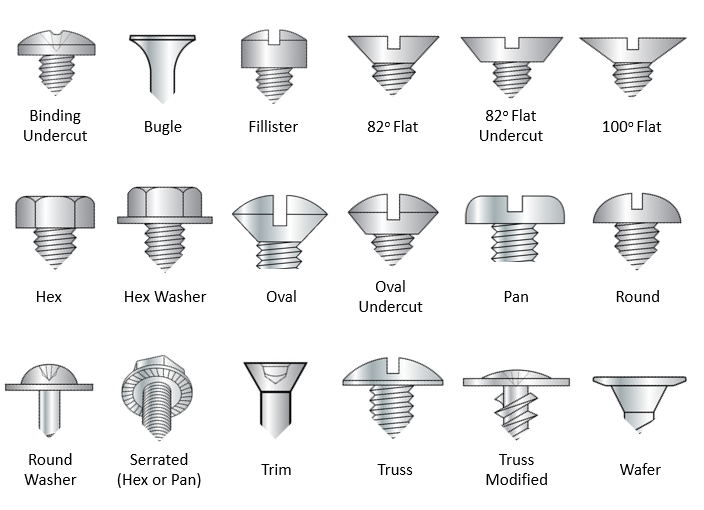 |
Screwdriver slots
 |
| ≡ | ⇧ |
SI Multiples
| Prefix | Symbol | 10n | Name |
|---|---|---|---|
| quetta (2022) | Q | 1030 | Nonillion |
| ronna (2022) | R | 1027 | Octillion |
| yotta (1991) | Y | 1024 | Septillion |
| zetta (1991) | Z | 1021 | Sextillion |
| exa (1975) | E | 1018 | Quintillion |
| peta (1975) | P | 1015 | Quadrillion |
| tera (1960) | T | 1012 | Trillion |
| giga (1960) | G | 109 | Billion |
| mega (1873) | M | 106 | Million |
| kilo (1795) | k | 103 | Thousand |
| hecto (1795) | h | 102 | Hundred |
| deca (1795) | da | 101 | Ten |
| 100 | One | ||
| decia (1795) | d | 10-1 | Tenth |
| centia (1795) | c | 10-2 | Hundredth |
| millia (1795) | m | 10-3 | Thousandth |
| micro (1873) | µ | 10-6 | Millionth |
| nano (1960) | n | 10-9 | Billionth |
| pico (1960) | p | 10-12 | Trillionth |
| femto (1964) | f | 10-15 | Quadrillionth |
| atto (1964) | a | 10-18 | Quintillionth |
| zepto (1991) | z | 10-21 | Sextillionth |
| yocto (1991) | y | 10-24 | Octillionth |
| ronto (2022) | r | 10-27 | Sextillionth |
| quecto (2022) | q | 10-30 | Nonillionth |
| ≡ | ⇧ |
SI Units
- Metre (m)
- Unit of length
- The speed of light (c) is 299,792,458 m/s
- Second (s)
- Unit of time
- The unperturbed ground-state hyperfine transition frequency of the cesium-133 atom which is 9,192,631,770 Hz
- Mole (mole)
- Amount of a substance equal to the number of atoms in 12g of carbon-12
- Contains exactly 6.02214076 x 1023 elementary entities - these can be atoms, molecules, ions, electrons, etc., and must be specified
- Ampere (a)
- Unit of electric current
- Fixed elementary charge of 1.602176634 x 10-19
- Kelvin (K)
- Unit of absolute temperature
- Fixed numerical value of the Boltzmann constant 1.380649 x 10-23
- Candela (cd)
- Unit of luminous intensity
- Fixed numerical value of luminous efficacy of monochromatic radiation of frequency 540 x 1012
- Kilogram (kg)
- Unit of mass
- Fixed numerical value of Planck's constant which is 6.62607015 x 10-34
| ≡ | ⇧ |
Shipping forecast areas
Wight
Portland
Plymouth
Biscay
Trafalgar
Fitzroy
Sole
Fastnet
Lundy
Irish Sea
Shannon
Rockall
Malin
Hebrides
Bailey
Faeroes
Fair Isle
Viking
Cromarty
N Utsire
S Utsire
Forties
Fisher
Forth
Tyne
Dogger
Humber
German Bight
Humber
Thames
| ≡ | ⇧ |
Spelling
Debtor / Creditor
If you sell a service (or goods) to someone, they owe you money - they are a debtorIf you buy a service (or goods) from someone, you owe them money - they are a creditor
Customers are debtors; suppliers are creditors
Its / It's
The difference between its and it'sNormally you'd expect an apostrophe when the meaning is possessive - e.g. Peter's book
but its works in the reverse sense (which is perhaps why it's so confusing)
It's is a contraction of it is or it has. For instance:
it's a lovely day (it is)
it's been ready for weeks (it has)
Whereas its is the possessive. For instance:
The tree had lost all its leaves
Madrid is famous for its art galleries
Council / Counsel
The difference between council and counselCouncil is a group of people elected to to make decisions or govern
Counsel is to give formal advice
Counsel is also a barrister so you can seek counsel's legal opinion).
Grill / Grille
The difference between grill and grilleGrill is a surface for cooking and can be used as a noun or a verb
Grille is a lattice, grating or screen
Principle / Principal
The difference between principle and pricipalPrinciple is a fundamental truth or proposition
Principal first in order of importance, most senior person
Whose / Who's
The difference between whose and who'sWhose/who's works in the same way as its/it's - i.e. in the opposite sense from the possessive
Who's is a contraction of who is or who has. For instance:
Who's coming to dinner (who is)
Who's eaten the last muffin? (who has)
Whose is a (sometimes relative or interrogative) pronoun and precedes a noun. For instance:
Whose bike was stolen?
Carl knows the girl whose phone was stolen.
Double quotes in programming
Quotes in HTML:“ is an opening double quote; ” is a closing double quote
" is a single quote
A double quote in the sense of quote within a quote (eg in a print statement):
"" in Basic
"" in PHP
\" in HTML or Javascript
Adding variables in a print statement:
& in Basic
. in PHP
+ in Javascript
| ≡ | ⇧ |
Surnames
- Occupational
- Archer, Baker, Brewer, Butcher, Carter, Clark, Cook, Dyer, Farmer, Faulkner, Fisher, Fuller, Gardner, Glover, Hunt/Hunter, Judge, Mason, Page, Parker, Potter, Sawyer, Slater, Smith, Tailor, Thatcher, Turner, Weaver, Wright (e.g. Cartwright, Wainwright)
- Personal characteristic
- Short, Long, Little, Black, White, Green, Red (Reed), Stern, Strong, Swift
- Place name
- Bedford, Burton, Hamilton, Hampshire, Sutton
- Estate
- Ernle, Staunton, Windsor
- Geographical feature
- Bridge, Brooks, Bush, Camp, Fields, Forest, Grenwood, Grove, Hill, Knoll, Lake, Moore, Perry, Stone, Wold, Wood, Woodruff
- Patronymic, matronymic or ancestral
- Benson, Davis, Dawson, Evans, Harris, Harrison, Jackson, Jones, Nicholson, Richardson, Robinson, Rogers, Simpson, Stephenson, Thompson, Watson, Wilson
Molson, Madison, Emmot, Marriot
Armstrong, Cameron, Campbell, Crawford, Douglas, Forbes, Grant, Henderson, Hunter, MacDonald, Stewart
- Patronage
- Hickman (Hick means Richard), Kilpatrick
| ≡ | ⇧ |
Synchronised Diving
Five judges judge the Synchronisation and the middle three scores are used.
All the scores are added to together and the result is multiplied by the degree of difficulty.
| ≡ | ⇧ |
Temperature
The Fahrenheit scale runs from freezing (32°) to boiling (212°)
Therefore, C = 5x(F - 32)/9 or F = 9C/5 + 32
| Centigrade (0-100°C) | Fahrenheit (32-212°F) |
|---|---|
| 100 spread | 180 spread |
| 17.2 | 1 |
| -15.0 | 5 |
| -12.2 | 10 |
| -9.4 | 15 |
| -6.7 | 20 |
| -3.9 | 25 |
| -1.1 | 30 |
| 0.0 | 32 |
| 1.7 | 35 |
| 4.4 | 40 |
| 7.2 | 45 |
| 10.0 | 50.0 |
| 12.8 | 55 |
| 15.6 | 60 |
| 18.3 | 65 |
| 20.0 | 68.0 |
| 21.1 | 70 |
| 23.9 | 75 |
| 26.7 | 80 |
| 29.4 | 85 |
| 30.0 | 86.0 |
| 32.2 | 90 |
| 35.0 | 95 |
| 37.8 | 100 |
| 40.0 | 104.0 |
| 40.6 | 105 |
| 43.3 | 110 |
| 46.1 | 115 |
| 48.9 | 120 |
| 50.0 | 122.0 |
| 51.7 | 125 |
| 54.4 | 130 |
| 57.2 | 135 |
| 60.0 | 140.0 |
| 62.8 | 145 |
| 65.6 | 150 |
| 68.3 | 155 |
| 70.0 | 158.0 |
| 71.1 | 160 |
| 73.9 | 165 |
| 76.7 | 170 |
| 79.4 | 175 |
| 80.0 | 176.0 |
| 82.2 | 180 |
| 100 | 212 |
The Kelvin scale runs from 0°K at absolute zero and rises in the same increments as Celsius.
Absolute zero is -273.15°C so a Celsius temperature can be converted to Kelvin by adding 273.15
| ≡ | ⇧ |
UTRUSTA hinges
Note whether inset or surface hinges are needed.
 |
Adjustment
 |
Clockwise = left; anti-clockwise = right
Middle screw: up and down (or use fixing plate)
Clockwise = down; anti-clockwise = up
Back screw: front-to-back
Clockwise = in; anti-clockwise = out
All IKEA hinges are made by BLUM.
| ≡ | ⇧ |
Vehicle registrations
| Date | Registration | Comment |
| 1903 - 1930s | AB 1234 | AB is the area; 1-4 digits |
| 1903 - 1930s | 1234 AB | Sometimes reversed |
| 1933 - 1965 | ABC 123 | Sometimes reversed |
| 1953 - 1962 | 123 ABC | Format reversed |
| 1963 - 1983 | ABC 123 A | A is the year |
| 1973 | Numbering centralised | |
| 1983 - 2001 | A 123 ABC | Format reversed |
| 2001 - | AB 51 CDE | 50 is added in September |
| ≡ | ⇧ |
Vitamins
| A (Retinol) | ||
| • Natural defences | ||
| • Vision in dim light | ||
| • Skin and linings of e.g. Nose | ||
| (cheese, eggs, oily fish, milk, liver). | ||
| B1 (thiamin) | ||
| • Energy release from food | ||
| • Nervous system | ||
| (peas, bananas, oranges, nuts, wholegrain bread, liver). | ||
| B2 (riboflavin) | ||
| • Skin, eyes, nervous system | ||
| • Energy release from food | ||
| (milk, eggs, mushrooms, plain yoghurt). | ||
| B3 (niacin) | , | |
| • Energy release from food | ||
| • Nervous system | ||
| (meat, fish, wheat flour, eggs). | ||
| Pantothenic acid | ||
| • Energy release from food | ||
| (chicken, beef, liver/kidney, eggs, mushrooms, avocado). | ||
| B6 | ||
| • Use and store energy | ||
| • Formation of haemoglobin | ||
| (pork, poultry, some fish, peanuts, soya beans, wheatgerm, oats, bananas, milk). | ||
| B7 (biotin - in small amounts> | ||
| • Make fatty acids | ||
| Folate & Folic acid | ||
| • Formation of red blood cells | ||
| • Reduce risk of birth defects | ||
| (broccoli, brussels sprouts, cannage, kale, spinach, peas, chickpeas, liver). | ||
| B12 (folic acid) | ||
| • Formation of red blood cells | ||
| • Energy release from food | ||
| (meat, fish, milk, cheese, eggs). | ||
| C | ||
| • Protect cells and keep them healthy | ||
| • Maintain healthy skin, blood vessels, bone, cartilage | ||
| • Wound healing | ||
| (citrus fruit, peppers, strawberries, blackcurrants, broccoli, brussel sprouts, potatoes). | ||
| D | ||
| • Regulate calcium and phosphate | ||
| • Keep bones, teeth, muscles healthy | ||
| (oily fish, red meat, livere, egg yolks). | ||
| E | ||
| • Skin, eyes and immune system | ||
| (plant oils, nuts and seeds, wheatgerm). | ||
| K | ||
| • Helps blood clotting and wounds healing | ||
| (broccoli, spinach, vegetable oils, cereal grains). | ||
| Calcium | ||
| • Build bones and teeth | ||
| • Regulate muscle contractions (including heart) | ||
| • Keeps blood clotting normal | ||
| (milk, cheese, diary, kale, okra, soya, bread, sardines). | ||
| Iodine | ||
| • Keeps cells & metabolic rate healthy | ||
| (cows' milk,eggs, sea fish, shellfish). | ||
| Iron | ||
| • Makes red blood cells | ||
| (liver, red meat, beans, nuts). | ||
| Others | ||
| Beta-carotene • Turns into Vitamin A in the body | ||
| (spinach, carots, red peppers, mango, papaya, apricots). | ||
| Chromium | ||
| (meat, nuts, cereal grains). | ||
| Copper | ||
| • Produces red & white blood cells | ||
| (nuts, shellfish, offal). | ||
| Magnesium | ||
| • Energy release from food | ||
| • Ensures parathyroid glands work properly | ||
| (spinach, nuts, wholemeal bread). | ||
| Manganese | ||
| • Helps make & activate enzymes (proteins) | ||
| (bread, nuts, green veg like peas). | ||
| Molybdenum | ||
| • Helps make & activate enzymes that make genetic material | ||
| (foods that grow above ground). | ||
| Phosphorus | ||
| • Builds strong bones & teeth | ||
| (foods that grow above ground). | ||
| Potassium | ||
| • Controls the balance of fluids | ||
| • Helps the heart work properly | ||
| (bananas, broccoli, brussels sprouts, beans & pulses, nuts & seeds, fish, beef, chicken, turkey). | ||
| Selenium | ||
| • Helps the immune system | ||
| • Helps prevent damage to cells | ||
| (brazil nuts, fish, meat, eggs). | ||
| Salt | ||
| • Helps the balance of fluids | ||
| (ready meals, bacon, cheese, tinned vegetables, savoury snacks). | ||
| Zinc | ||
| • Makes new cells & enzymes | ||
| • Processes carbohydrate, fat & protein | ||
| • Helps wound healing | ||
| (meat, shellfish, dairy, bread, wheatgerm). |
| ≡ | ⇧ |
Weather
Air pressure
When the air pressure is high (over 1013 mb) it is hot in summer and cold in winter. Equally, when the pressure is low, it is wet in the summer but warmer in the winter. The temperatures are also affected by cloud cover shading the sun.Sea level was measured every hour for six years in Newlyn culminating on 30th April 1921. The mean of these readings is the Ordnance Datum Newlyn (ODN) and, upon this, is based the standard air pressure of 1013.25 mb.
In war time, QNH referred to the pressure at an aircraft's height above Newlyn; QFE referred to the pressure and therefore height relative to the ground level at a particular spot - e.g the airfield.
Atmosphere
The atmosphere is made up of several different layers.- Karman line (100km
- Exosphere
- Thermosphere
- Mesosphere (80km)
- Stratosphere (50km)
- Troposphere (11km)
Clouds
There are 10 types of cloud- Cirrus (high level)
- Cirro-cumulus
- Cirro-stratus
- Alto-cumulus (mid level)
- Alto-stratus
- Nimbo-stratus
- Cumulus (low level)
- Strato-cumulus
- Stratus
- Cumulo-nimbus
Fronts
Weather fronts are meetings of air masses where where there is a differnce across the front of temperature, humidity, wind or air density. There are four types:- Warm
- This is where warm air moves over cold air. They are marked by a red line and red semicircles pointing in the direction of the warm air movement. Warm fronts bring more gradual weather than cold fronts.
- Cold
- This is where cold air moves under warm air. They are marked by a blue line and blue spikes pointing in the direction of the cold air movement. They can bring heavy rain, strong winds, thunder and lightning.
- Stationary
- This is where two air masses meet but neither is strong enough to move the other at a ground speed of more than 5 kts.
- Occluded
- This is where cold air catches up with warm air and pushes the warm air into a larger layer over the cold front.
Frost
- Hoar frost
- This is where water vapour in damp air freezes directly and quickly on surfaces
- Air frost
- This is where the air temperature falls below zero at 1.2m above the ground.
- Grass frost
- This is frost on grass or vehetation where the vegetation is more sensitive to temperature changes.
- Ground frost
- This is where there is ice on the ground, objects or trees that have a temperatue below freezing.
You can have ground frost without air frost when the ground is colder than the air. This takes the form of needle-like crystals.
Wind chill
Temperature is absolute but the wind makes the temperature 'feel' colder.Click Here for a program for calculating it.
File: f:/computing/html/windchill
| ≡ | ⇧ |
Wedding Anniversaries
| 1 | Paper |
| 2 | Cotton |
| 3 | Leather |
| 4 | Fruit |
| 5 | Wood |
| 6 | Sugar |
| 7 | Copper |
| 8 | Bronze |
| 9 | Willow |
| 10 | Tin |
| 11 | Steel |
| 12 | Silk |
| 13 | Lace |
| 14 | Ivory |
| 15 | Crystal |
| 20 | China |
| 25 | Silver |
| 30 | Pearl |
| 35 | Coral |
| 40 | Ruby |
| 45 | Sapphire |
| 50 | Gold |
| 55 | Emerald |
| 60 | Diamond |
| 65 | Blue sapphire |
| 70 | Platinum |
| 80 | Oak |
| ≡ | ⇧ |
Wife speak
- Q: D'you want me to get rid of those chairs?
- A: They're very comfortable.
- Q: Where are you going?
- A: Oh, I won't be long.
- Q: How long wil you be gone?
- A: Oh, I'm not going far.
- Q: How long is the board?
- A: I need a foot at each end.
- Q: What is that you're digging up?
- A: It's the bane of my life.
- Q: Whose is that overall?
- A: I wear it when I'm working.
- Q: Would you like one of these?
- A: I've already had some.
- Q: Can you not wear boots?
- A: They're not mine.
- Q: What's that you're making?
- A: Oh, I've not made it before.
- Q: Does this go in the fridge?
- A: I'd better put a top on it.
- Q: How may tennis rackets have we got?
- A: They're all very old.
- Q: What are those?
- A: They're revolting.
| ≡ | ⇧ |
Wind turbines

- In 2000, the average height to the axle was 58m and the average rotor diameter was 48m.
- By 2018, the average height to the axle was 88m and the average rotor diameter was 116m.
- In 2022, the average height to the axle was just under 100m and the average rotor diameter was just over 130m.
Wind turbines

| ≡ | ⇧ |
Window tax
Window tax was introduced in England in 1696 (by William III) and in Scotland in 1748.
A house with less than 10 windows paid (initially) 2 shillings per house, although cottages were exempt. Otherwise it was a tax per window.
Between 10 and 20 windows cost 6/- and those with more thn 20 windows paid 10/-.
The law was repealed in 24th July 1851.
| ≡ | ⇧ |
Yaw
With single propeller planes, there are four forces tending to push the plane to the left on take-off and landing:
Torque
Most single-engine airplane propellers rotate clockwise. This generates an equal force in the opposite direction, causing the plane to roll left.Friction
The left-turning tendency increases friction on the left side of the landing gear, causing the plane to yaw left.P-factor
The propeller takes a bigger “bite” of air on the right side, producing more thrust from the right half of the propeller. This tries to turn the airplane left.Precession
As the tail is lifted and angle of the fuselarge changes and so therefore does the engine. This has a gyroscopic precession effect of making the plane yaw to the left.Factoids
- Aspen 4 - special petrol
| Peter Bassett, Scires Farm | MK18 5DN | 8.39 miles |
| Advanced Turf Machinery, Spinney Works | MK17 8UR | 8.76 miles |
| AJ Contracting, Newton Park Farm Cottage, Newton Blossomville | MK43 8AU | 10.22 miles |
| Sharmans of Towcester, The Old Mill Race | NN12 8FB | 10.95 miles |
| ≡ | ⇧ |
People
Abraham Lincoln

|
d.15 Apr 1865 (assassinated)
Lincoln's legacy is based on his momentous achievements: he successfully waged a political struggle and civil war that preserved the Union, ended slavery, and created the possibility of civil and social freedom for African-Americans
| ≡ | ⇧ |
Buffalo Bill
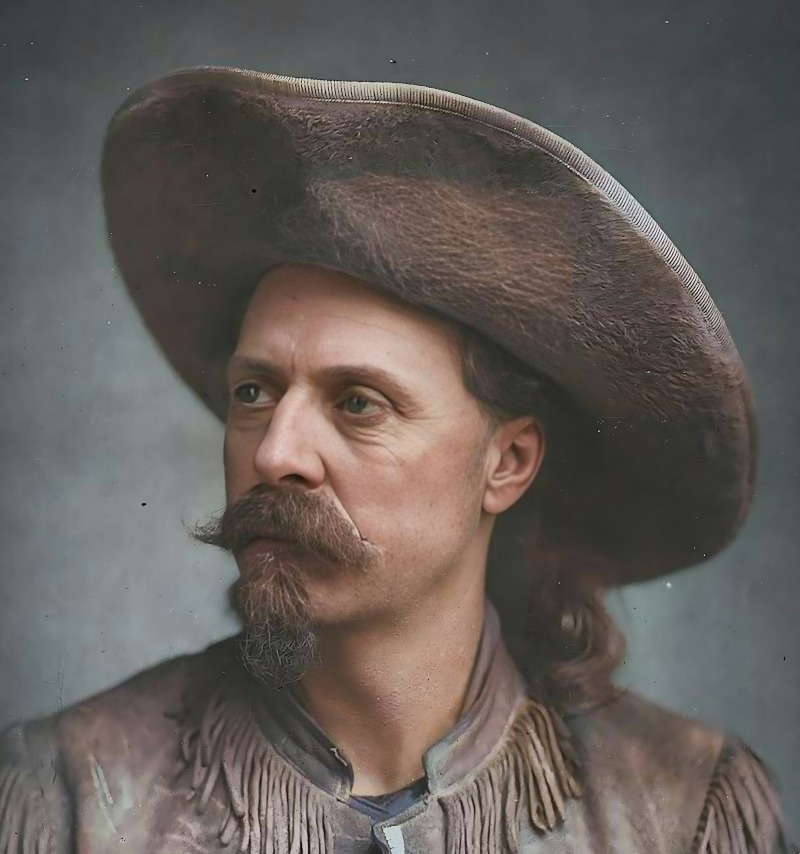
|
d.10 Jan 1917
William Frederick Cody, known as Buffalo Bill, was an American soldier, bison hunter, and showman. He was born in Le Claire, Iowa Territory, but he lived for several years in his father's hometown in modern-day Mississauga, Ontario, Canada, before the family returned to the Midwest and settled in the Kansas Territory
| ≡ | ⇧ |
Emily Pankhurst
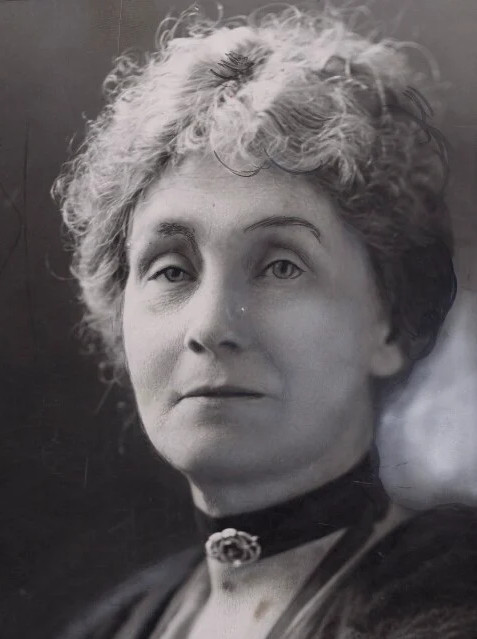
|
d.14 June 1928, Hampstead, London
Independent Labour Party
Emmeline (Emily) Pankhurst was a British political activist who organised the UK suffragette movement and helped women win the right to vote.
| ≡ | ⇧ |
Florence Nightingale
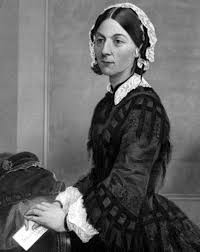
|
d.13 Aug 1910, London, England
Florence Nightingale OM RRC DStJ, known as “The Lady With the Lamp,” was an English social reformer, statistician and the founder of modern nursing. Nightingale came to prominence while serving as a manager and trainer of nurses during the Crimean War, in which she organised care for wounded soldiers at Constantinople. She established St. Thomas’s Hospital and the Nightingale Training School for Nurses in 1860. Her efforts to reform healthcare greatly influenced the quality of care in the 19 and 20 centuries.
| ≡ | ⇧ |
George Washington
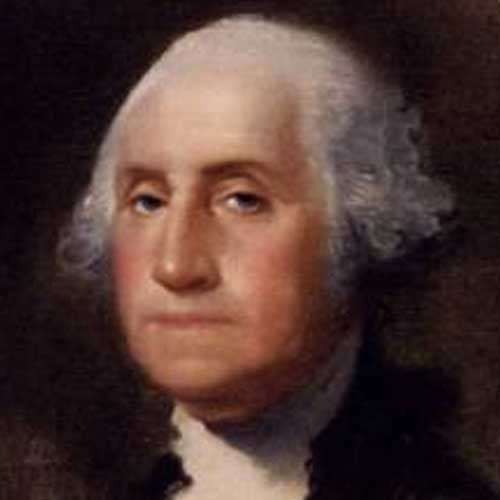
|
d.14 Dec 1799, Virginia, US
George Washington was an American military officer, statesman, and Founding Father who served as the first president of the United States from 1789 to 1797.
| ≡ | ⇧ |
Leonardo da Vinci
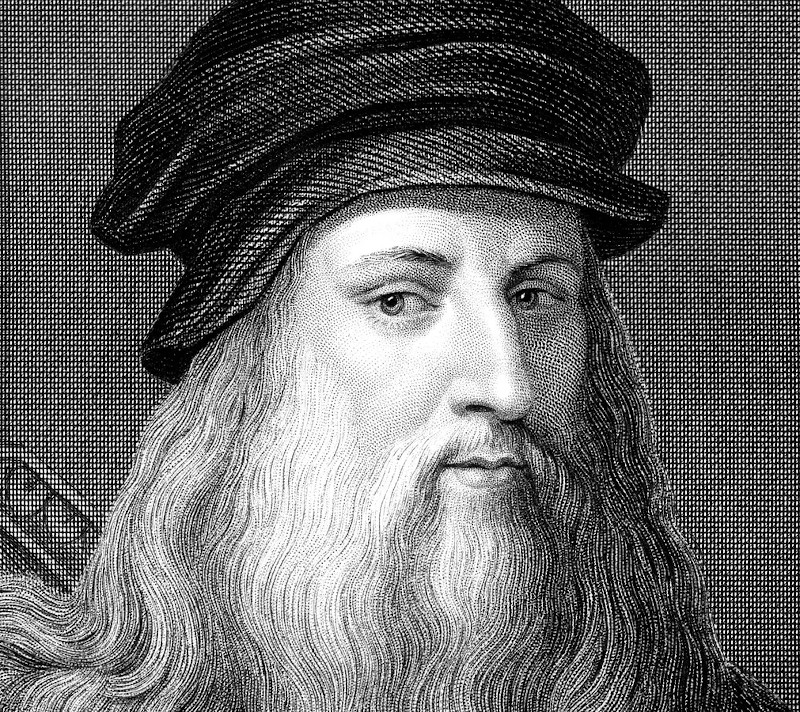
|
d.2 May 1519, Amboise, France
Leonardo di ser Piero da Vinci was an Italian polymath of the High Renaissance who was active as a painter, draughtsman, engineer, scientist, theorist, sculptor, and architect.

|
He is famous for a number of practical (and not so practical) invensions plus, of course, painting the Mona Lisa (sometime between 1503 & 1519)
| ≡ | ⇧ |
Michaelangelo
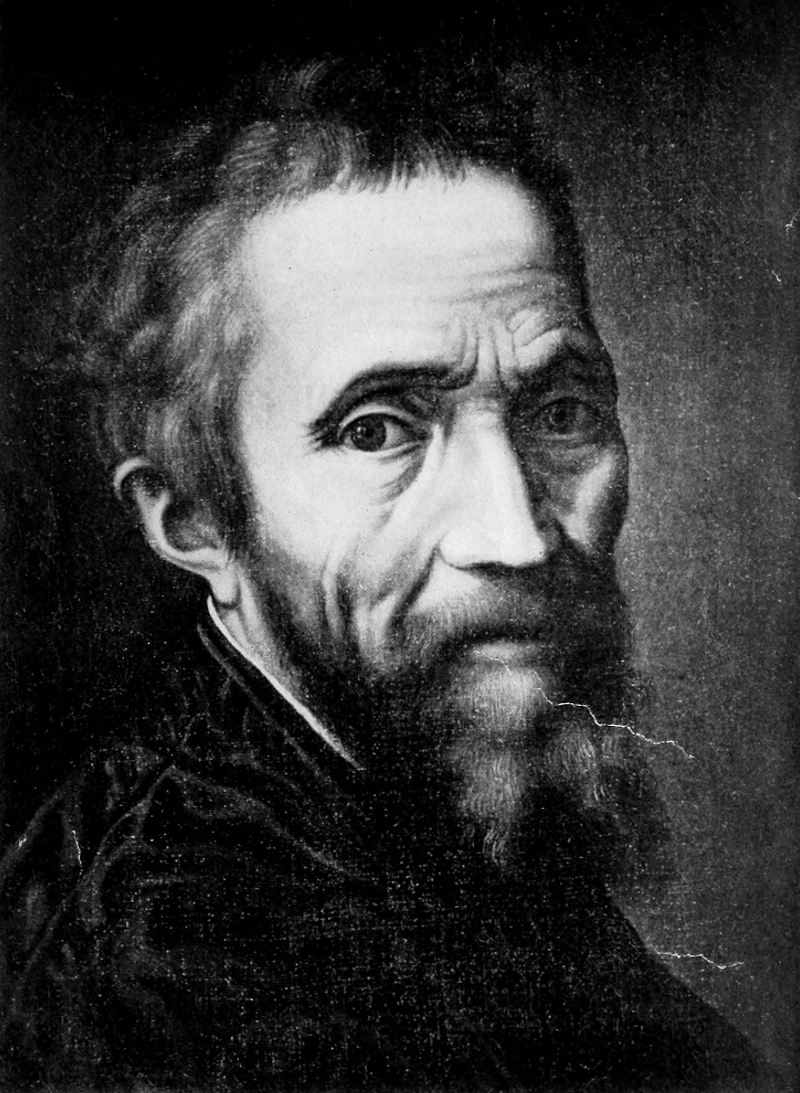
|
d.18 Feb 1564, Rome, Italy
Michelangelo di Lodovico Buonarroti Simoni, known as Michelangelo, was an Italian sculptor, painter, architect, and poet of the High Renaissance. Born in the Republic of Florence, his work was inspired by models from classical antiquity and had a lasting influence on Western art.
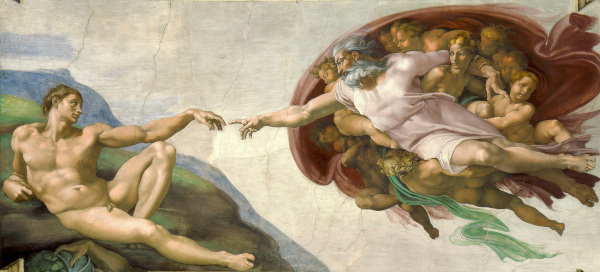
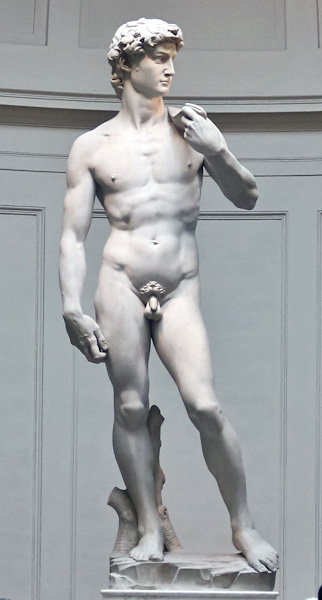
|
He is most famous for painting the ceiling of the Sistine Chapel (1508-1512) and for the sculpture of David (1501-1504)
| ≡ | ⇧ |
Nelson Mandela

|
d.5 December 2013, Johannesburg, South Africa
Son of a chief, Nelson Mandela studied law and became one of South Africa's first black lawyers. Early in the 1950s he was elected leader of the youth wing of the ANC (African National Congress) liberation movement. When the country's white minority government prohibited the ANC in 1960, Mandela became convinced that armed struggle was inevitable. Inspired by the guerrilla wars in Algeria and Cuba, he organized a military underground movement that engaged in sabotage.
In 1962 he was arrested and sentenced to life imprisonment for high treason and conspiracy against the state.
From 1964 to 1982 he was confined to the notorious prison island Robben Island, together with several other resistance leaders. He was then moved to prison on the mainland until his release in 1990. During his imprisonment, Mandela became a rallying point for South Africa's oppressed, and the world's most famous political prisoner.
Nelson Mandela shared the Peace Prize with the man who had released him, President Frederik Willem de Klerk, because they had agreed on a peaceful transition to majority rule.
| ≡ | ⇧ |
Stories
Sense and Sensibility
It tells the story of the Dashwood sisters, Elinor (age 19) and Marianne (age 16½) as they come of age. They have an older half-brother, John, and a younger sister, Margaret (age 13).
The novel follows the three Dashwood sisters as they must move with their widowed mother from the estate on which they grew up, Norland Park. Because Norland is passed down to John, the product of Mr. Dashwood's first marriage, and his young son, the four Dashwood women need to look for a new home. They have the opportunity to rent a modest home, Barton Cottage, on the property of a distant relative, Sir John Middleton. There Elinor and Marianne experience love, romance, and heartbreak
Elinor Dashwood, Marianne Dashwood, Margaret Dashwood
Colonel Brandon, John Willoughby
| ≡ | ⇧ |
Pride and Prejudice
Mrs Bennet insists that her daughters find rich husbands and settle down. When a wealthy bachelor starts living near them, Mrs Bennet's happiness knows no bounds.
Mr & Mrs Bennet
Jane, Elizabeth, Mary, Lydia, Kitty
Fitzwilliam D'Arcy, Charles Bingham, George Wickham, William Collins
| ≡ | ⇧ |
Mansfield Park
The story follows the young, poor protagonist Fanny Price who at age ten is sent to live with her rich aunt and uncle Bertram at their grand estate of Mansfield Park. Growing up in their family circle, Fanny navigates love, loneliness and rivalry.
| ≡ | ⇧ |
Emma
Emma Woodhouse's friend and former governess, Miss Taylor, has just married Mr. Weston. Having introduced them, Emma takes credit for their marriage and decides that she likes matchmaking. After returning home to Hartfield with her father, Emma forges ahead with her new interest against the advice of her friend Mr. Knightley, who is also brother-in-law to Emma's elder sister Isabella. She attempts to match her new friend Harriet Smith to Mr. Elton, the local vicar. Emma persuades Harriet to refuse a marriage proposal from Robert Martin, a respectable, educated, and well-spoken young farmer, though Harriet likes him. Mr. Elton, a social climber, mistakenly believes Emma is in love with him and proposes to her. When Emma reveals she believed him attached to Harriet, he is outraged, considering Harriet socially inferior ...
| ≡ | ⇧ |
Northanger Abbey
The story concerns Catherine Morland, the naïve young protagonist, and her journey to a better understanding of herself and of the world around her. How Catherine views the world has been distorted by her fondness for Gothic novels and an active imagination.
| ≡ | ⇧ |
Persuasion
The story concerns Anne Elliot, an Englishwoman of 27 years, whose family moves to lower their expenses and reduce their debt by renting their home to an admiral and his wife. The wife's brother, Captain Frederick Wentworth, was engaged to Anne in 1806, but the engagement was broken when Anne was persuaded by her friends and family to end their relationship. Anne and Captain Wentworth, both single and unattached, meet again after a separation lasting almost eight years, setting the scene for many humorous encounters as well as a second, well-considered chance at love and marriage for Anne...
| ≡ | ⇧ |
Pickwick Papers
The Pickwick Papers follows the Pickwick Club, which works to spread scientific knowledge. The club is explained as a group of men who travel to learn more about different cultures, but over time, the travels focus more on fun than on the original scientific purpose...
| ≡ | ⇧ |
Oliver Twist
The titular character is born an orphan and is forced into unjust and cruel situations from child farms to workhouses to a life of crime. He is constantly thrown into trusting the wrong adults. The boy's innocence reveals the extreme suffering of the poor in Victorian England.
| ≡ | ⇧ |
Nicholas Nickleby
Nicholas Nickleby's father dies unexpectedly after losing all of his money in a poor investment. Nicholas, his mother and his younger sister, Kate, are forced to give up their comfortable lifestyle in Devonshire and travel to London to seek the aid of their only living relative, Nicholas's uncle, Ralph Nickleby. Ralph, a cold and ruthless businessman, has no desire to help his destitute relations and hates Nicholas at first sight. He gets Nicholas a very low-paying job as an assistant to Wackford Squeers, who runs the school Dotheboys Hall in Yorkshire. Nicholas is wary of Squeers because of his attitude towards his young charges, but tries to quell his suspicions. As Nicholas prepares to travel to Yorkshire, he receives a letter from Ralph's clerk, Newman Noggs, offering assistance if Nicholas ever requires it. Once he arrives in Yorkshire, Nicholas finds that the school is a scam: Squeers takes in unwanted children for a high fee, and starves and abuses them while keeping the money sent by their parents, who only want to get them out of their way. While there, Nicholas befriends a "simple" boy named Smike, who is older than the other boys and now acts as an unpaid servant...
| ≡ | ⇧ |
Old Curiosity Shop
The novel tells the story of Nell Trent, a beautiful and virtuous young girl who has not attained the age of fourteen. Being an orphan, Nell lives with his grandfather (whose name is never revealed) in his antique shop, which the book its title. Although she is very much loved by her grandfather, Nell leads a lonely existence and has very few companions her own age. Her only friend is Kit, a young boy and honest employee who also lives in the shop, and whom Nell is teaching to read and write. Secretly obsessed with ensuring that Nell does not die in poverty, her grandfather turns to gambling in a misguided effort to make money. But he has little luck, and becomes heavily indebted to Daniel Quilp, a malicious and deformed money lender (who then drowns in the river Thames towards the end of the book). Unable to repay his debts, Nell's grandfather loses the store. He and Nell are driven out onto the streets and survive by begging, wandering all over London and surrounding area.
Nell and Ger Grandfather Thrown Out on the Street Old Curiosity Shop: Nell and Her Grandfather Thrown Out on the Street Meanwhile, Nell's brother is convinced that the grandfather has hidden money for Nell and forms a plan to have his simpleton friend Mr. Swiveller marry Nell so that they can share in the supposed fortune. The two, aided by the malicious Mr. Quilp pursue Nell and her grandfather. Quilp knows that there is no money but he joins in the scheme for the simple sadistic pleasure of tormenting Nell...
| ≡ | ⇧ |
Barnaby Rudge
Gathered around the fire at the Maypole Inn, in the village of Chigwell, on an evening of foul weather in the year 1775, are John Willet, proprietor of the Maypole, and his three cronies. One of the three, Solomon Daisy, tells an ill-kempt stranger at the inn a well-known local tale of the murder of Reuben Haredale which had occurred 22 years earlier on that very day. Reuben had been the owner of the Warren, a local estate which is now the residence of Geoffrey, the deceased Reuben's brother, and Geoffrey's niece, Reuben's daughter Emma Haredale. After the murder, Reuben's gardener and steward went missing and were suspects in the crime. A body was later found and identified as that of the steward, so the gardener was assumed to be the murderer...
| ≡ | ⇧ |
Martin Chuzzlewit
Martin Chuzzlewit is a rich old man who has hired a nurse to take care of him named Mary. Mary will only be paid as long as Martin is alive, while many others want Martin dead so they can inherit his money. Meanwhile, Martin's grandson, also named Martin, falls in love with Mary and wants to marry her...
| ≡ | ⇧ |
Christmas Carol
The story of Ebenezer Scrooge, an elderly miser who is visited by the ghost of his former business partner Jacob Marley and the spirits of Christmas Past, Present and Yet to Come. In the process, Scrooge is transformed into a kinder, gentler man...
| ≡ | ⇧ |
Dombey and Son
It follows the fortunes of a shipping firm owner, who is frustrated at the lack of a son to follow him in his footsteps; he initially rejects his daughter's love before eventually becoming reconciled with her before his death.
| ≡ | ⇧ |
David Copperfield
The story is told in the first person by a middle-aged David Copperfield, who is looking back on his life. David is born in Blunderstone, Suffolk, six months after the death of his father, and he is raised by his mother and her devoted housekeeper, Clara Peggotty. As a young child, he spends a few days with Peggotty at the home of her brother, Mr. Peggotty, in Yarmouth, which Mr. Peggotty shares with Ham and Emily, his orphaned nephew and niece, respectively. When the visit ends, David learns that his mother has married the cruel and controlling Mr. Edward Murdstone. That evening Murdstone’s sister also moves in and assumes the management of the household.
One day Mr. Murdstone takes David to his bedroom to beat him, and David bites his hand. After that, the eight-year-old David is sent to a boarding school run by the sadistic Mr. Creakle. There David becomes friends with the kind and steadfast Tommy Traddles and with the charismatic and entitled James Steerforth. Partway through David’s second semester at the school, his mother dies shortly after giving birth to a son, who also perishes. After that, Peggotty is dismissed, and she marries Barkis, who drives a wagon. David is not returned to school, and at the age of 10 he is sent to work at Murdstone’s wine-bottling factory in London. He lodges at the home of Mr. and Mrs. Micawber, a generous couple who are constantly facing financial disaster. Eventually, Mr. Micawber is sent to debtors’ prison, after which David runs away to Dover to find his great-aunt, the self-sufficient Miss Betsey Trotwood, and, on the advice of her simpleminded and good-hearted boarder, Mr. Dick, she takes him in.
Miss Betsey arranges for David to go to a school run by Doctor Strong and to stay with her business manager, Mr. Wickfield, and his daughter, Agnes. Working for Mr. Wickfield is an off-putting teenaged clerk named Uriah Heep. After David completes his schooling, he goes to visit Peggotty. On the way to Yarmouth, David encounters Steerforth, and together they visit Peggotty and Mr. Peggotty. Emily’s engagement to Ham is announced, but she appears interested in Steerforth.
After agreeing to Miss Betsey’s idea that he should become a proctor (a type of attorney), David begins an apprenticeship at the London office of Spenlow and Jorkins. He maintains his friendship with Steerforth, though Agnes Wickfield disapproves. He is reacquainted with Uriah Heep, who is about to become Wickfield’s partner and who intends to marry Agnes. One day Spenlow invites David to his home, and David becomes infatuated with Spenlow’s childlike daughter, Dora.
David finds that Traddles is now a boarder with Mr. and Mrs. Micawber. Upon learning that Barkis is on the point of death, he returns to Yarmouth. After Barkis’s funeral, Emily runs away with Steerforth, and Mr. Peggotty vows to find her. David returns to London and becomes engaged to Dora. Miss Betsey unexpectedly arrives with the news that she has been financially ruined as a result of Uriah Heep’s partnership with Wickfield. To add to his income, David begins working for Doctor Strong as a secretary, and at Traddles’s suggestion he starts reporting on parliamentary debates for newspapers; later he also writes fiction.
Uriah Heep hires Mr. Micawber as a clerk. Eventually, David marries Dora. After she suffers a miscarriage, she never regains her strength and she dies. During this time Emily returns to London after being abandoned in Naples by Steerforth. One day Mr. Micawber, in concert with David and Traddles (who is now a lawyer), confronts Uriah Heep with detailed evidence that he has been cheating Wickfield and was responsible for Miss Betsey’s losses; Heep is required to return the money. Plans are then made for Mr. and Mrs. Micawber to join Mr. Peggotty and Emily when they immigrate to Australia to make a fresh start. Ahead of the departure, David goes to Yarmouth to deliver a letter from Emily to Ham, but a dangerous storm arises. Several ships are lost, and one shipwreck occurs close enough to shore that Ham tries to swim out and save the last two survivors. Ham drowns, and, when the body of one of the sailors is washed ashore, it proves to be Steerforth. David spends the next three years in continental Europe, and, when he returns, he marries Agnes.
| ≡ | ⇧ |
Bleak House
The story begins in the High Court of Chancery, where the case of Jarndyce and Jarndyce has gone on for generations and has “become so complicated that no man alive knows what it means.” The current issue concerns two young wards of the court, Ada Clare and Richard Carstone, who are seeking permission to take up residence with a distant cousin, Mr. John Jarndyce. Later, the lawyer Mr. Tulkinghorn stops by the London home of Sir Leicester Dedlock and his wife, Lady Dedlock. She is also connected with the suit, and, as the lawyer goes over affidavits with her, she takes a sudden interest in the handwriting on one of the documents.
Esther Summerson is then introduced into the story. She was raised by her unfeeling godmother, who died when Esther was almost 14 years old. She then learned that her godmother was actually her aunt and that Mr. Jarndyce was now her guardian. He paid for her education in a boarding school and then engaged her to be a companion to Ada. The three young people arrive at Jarndyce’s home, Bleak House, to a warm welcome. As the novel goes on, Richard tries and discards several vocational options in the belief that he will inherit a substantial sum when the lawsuit is settled, and he and Ada fall in love.
Tulkinghorn learns that the handwriting Lady Dedlock asked about belongs to a copyist named Nemo and that he has died of an opium overdose. The lawyer also meets Jo, a street urchin who declares that Nemo was kind to him. Tulkinghorn subsequently relays this information to Lady Dedlock, and, after disguising herself as her maid, Hortense, she seeks out Jo and asks him to show her every place connected with Nemo. Later Tulkinghorn has a police detective, Inspector Bucket, seek Jo’s help in identifying the woman who was interested in Nemo. Jo recognizes Hortense’s clothing but not Hortense, who has been fired by Lady Dedlock. However, Tulkinghorn has promised to help Hortense find employment in return for her cooperation. Tulkinghorn begins searching for a sample of handwriting from a Captain Hawdon.
A lawyer’s clerk, Mr. William Guppy, tells Lady Dedlock that he has learned that Esther’s name is actually Esther Hawdon and that Nemo’s last name was Hawdon. Lady Dedlock realizes that Esther is her daughter from an affair with Captain Hawdon and that her sister, who had told her that the baby died, had taken Esther and secretly raised her. One day Lady Dedlock encounters Esther and reveals to her that she is her mother. During this time Tulkinghorn succeeds in acquiring a sample of Hawdon’s handwriting. Tulkinghorn subsequently reveals to Lady Dedlock that he has learned her secret but promises not to tell Sir Leicester without notice. Later, a furious Hortense confronts Tulkinghorn for not having gotten her a job, and she offers to help him bring Lady Dedlock down, but he dismisses her. Meanwhile, Esther tells Jarndyce the story of her parentage. Not long after, Jarndyce proposes marriage to Esther, and she accepts. Tulkinghorn later decides that he will tell Sir Leicester the secret without consulting Lady Dedlock. That night, however, Tulkinghorn is shot to death, and Bucket arrests George Rouncewell, an estranged son of the Dedlock household’s housekeeper. Jarndyce and Esther ask Mr. Allan Woodcourt, a doctor who works among the poor and is a friend, to look in on Richard, whose obsession with the lawsuit is taking a toll on his health. Ada reveals that she and Richard have married.
Bucket is not convinced that George is guilty of Tulkinghorn’s murder and continues to investigate. Eventually, he tells Sir Leicester about Lady Dedlock’s relationship with Hawdon and the resultant daughter. He then arrests Hortense for the murder, having discovered that she was trying to frame Lady Dedlock. Those attempts led Lady Dedlock to believe that she was suspected of the murder, and she is certain that her humiliating secret will soon be revealed. She writes a letter to her husband denying her involvement in the murder but admitting her past.
When Sir Leicester, who has had a stroke from the shock of Bucket’s revelations, reads the letter from his wife, he instructs Bucket to find her and tell her that he fully forgives her. Bucket enlists the aid of Esther, and, after an exhaustive search, they find Lady Dedlock at the gate of Hawdon’s burial ground, dead. After Esther falls ill, Woodcourt tends to her, and one night he tells Esther that he is in love with her. Esther and Jarndyce then decide to set their wedding date for the following month. Bucket reports that a Jarndyce will has been found that is more recent than those involved in the lawsuit. Later Jarndyce gives Woodcourt a house to be called Bleak House and gives Esther his blessing to marry Woodcourt instead of him. The new will finally ends the case in Richard’s favour, but all the money in the estate has already been eaten up in legal costs. Although Richard dies that day, the remaining major characters enjoy happier fates.
| ≡ | ⇧ |
Hard Times
Superintendent Mr. Gradgrind opens the novel at his school in Coketown stating, "Now, what I want is Facts. Teach these boys and girls nothing but Facts", and interrogates one of his pupils, Cecilia (nicknamed Sissy), whose father works at a circus. Because her father works with horses, Gradgrind demands the definition of a horse. When she is scolded for her inability to factually define a horse, her classmate Bitzer gives a zoological profile, and Sissy is censured for suggesting that she would carpet a floor with pictures of flowers or horses...
| ≡ | ⇧ |
Little Dorrit
| ≡ | ⇧ |
Tale of Two Cities
A Tale of Two Cities is set in the late 18th century against the background of the French Revolution. Although Dickens borrowed from Thomas Carlyle’s history, The French Revolution, for his sprawling tale of London and revolutionary Paris, the novel offers more drama than accuracy. The scenes of large-scale mob violence are especially vivid, if superficial in historical understanding.
The plot involves Sydney Carton’s sacrifice of his own life on behalf of his friends Charles Darnay and Lucie Manette. While political events drive the story, Dickens takes a decidedly antipolitical tone, lambasting both aristocratic tyranny and revolutionary excess — the latter memorably caricatured in Madame Defarge, who knits beside the guillotine.
The book is perhaps best known for its opening lines,
“It was the best of times, it was the worst of times ...”,
and for Carton’s last speech, in which he says of his replacing Darnay in a prison cell,
“It is a far, far better thing that I do, than I have ever done; it is a far, far better rest that I go to, than I have ever known.”
| ≡ | ⇧ |
Great Expectations
| ≡ | ⇧ |
Wuthering Heights
Wuthering Heights is an 1847 novel by Emily Brontë, initially published under her pen name "Ellis Bell". It concerns two families of the landed gentry living on the West Yorkshire moors, the Earnshaws and the Lintons, and their turbulent relationships with the Earnshaws' foster son,
Heathcliffe, Catherine Earnshaw, Hindley Earnshaw
| ≡ | ⇧ |
Jane Eyre
| ≡ | ⇧ |
Black Tulip
The city of Haarlem had set the prize of 100,000 Francs to whoever could grow a black tulip. At stake was not only the prize, but fame and honour. Also, the gardener would perpetuate his name in history by the tulip's recorded name.
| ≡ | ⇧ |
Little Women
The city of Haarlem had set the prize of 100,000 Francs to whoever could grow a black tulip. At stake was not only the prize, but fame and honour. Also, the gardener would perpetuate his name in history by the tulip's recorded name.
| ≡ | ⇧ |
Far from the Madding Crowd
Gabriel Oak is a young shepherd. With the savings of a frugal life, and a loan, he has leased and stocked a farm. He falls in love with a newcomer eight years his junior, Bathsheba Everdene, a proud beauty who arrives to live with her aunt. Over time, Bathsheba and Gabriel grow to like each other well enough, and Bathsheba even saves his life once. However, when he makes her an unadorned offer of marriage, she refuses; she values her independence too much and him too little. After a few days, she moves to Weatherbury, a village some miles off.
After a lot of drama, and some difficult situations, Boldwood kills Troy and Bathsheba chases down Oak.
Characters: Bathsheba Everdene, Gabriel Oak, William Boldwood, Sergeant Troy
| ≡ | ⇧ |
Mayor of Casterbridge
The Mayor of Casterbridge: The Life and Death of a Man of Character is an 1886 novel by the English author Thomas Hardy. One of Hardy's Wessex novels, it is set in a fictional rural England with Casterbridge standing in for Dorchester in Dorset where the author spent his youth
Susan Henchard, Lucetta Templeman, Michael Henchard, Donald Farfrae, Elizabeth-Jane Newson
| ≡ | ⇧ |
Tess of the D'Urbervilles
| ≡ | ⇧ |
Black Beauty
| ≡ | ⇧ |
Tom Sawyer
| ≡ | ⇧ |
Prince and the Pauper
| ≡ | ⇧ |
Huckleberry Finn
| ≡ | ⇧ |
Scarlet Pimpernel
An Englishman who uses many clever disguises (i.e. ways of changing your clothes and appearance so that people do not recognise you) to help French people from a high social class to escape from France and from the possibility of having their heads cut off by the guillotine during the French Revolution.
Sir Percy Blakeney
| ≡ | ⇧ |
National Velvet
| ≡ | ⇧ |
Swallows and Amazons
| ≡ | ⇧ |
Wars and Battles
English wars and campaigns
| Date | Campaign |
|---|---|
| 1587-1603 | War against Spain |
| 1642-1646 | English Civil War |
| 1652-1654 | 1st Anglo-Dutch War |
| 1665-1667 | 2nd Anglo-Dutch War |
| 1702-1713 | War of the Spanish Succession |
| 1739-1742 | War of Jenkins' Ear |
| 1740-1748 | War of the Austrian Succession |
| 1753-1763 | Seven Years' War |
| 1755-1763 | French and Indian War (in North America) |
| 1775-1783 | War of American Independence |
| 1775-1782 | War with Marathas (in India) |
| 1779-1783 | Siege of Gibraltar |
| 1793-1802 | French Revolutionary War |
| 1803-1815 | Napoleonic Wars |
| 1808-1814 | Peninsular War |
| 1812-1815 | War in America |
| 1824-1826 | 1st Anglo-Burmese War |
| 1838-1842 | 1st Afghan War |
| 1982 | Falklands Campaign |
| 1992 | War in Iraq |
| 2001- | War in Iraq and Afghanistan |
| ≡ | ⇧ |
Battle of Hastings
William of Normandy fought Harold who had just returned from York and the battle of Stamford Bridge. The two armies were very evenly matched but the Normans prevailed and Harold was killed.
| ≡ | ⇧ |
100 Years War
The Hundred Years' War was a significant conflict in the Middle Ages. For 116 years, interrupted by several truces, five generations of kings from two rival dynasties fought for the throne of France, the dominant kingdom in Western Europe. The war's effect on European history was lasting. Both sides produced innovations in military technology and tactics, including professional standing armies and artillery, that permanently changed warfare in Europe; chivalry, which reached its height during the conflict, subsequently declined. Stronger national identities took root in both countries, which became more centralised and gradually rose as global powers.
The term "Hundred Years' War" was adopted by later historians as a historiographical periodisation to encompass related conflicts, constructing the longest military conflict in European history. The war is commonly divided into three phases separated by truces: the Edwardian War (1337–1360), the Caroline War (1369–1389), and the Lancastrian War (1415–1453). Each side drew many allies into the conflict, with English forces
| ≡ | ⇧ |
30 Years War
In European history, a series of wars fought by various nations for various reasons, including religious, dynastic, territorial, and commercial rivalries. Its destructive campaigns and battles occurred over most of Europe, and, when it ended with the Treaty of Westphalia in 1648, the map of Europe had been irrevocably changed.
| ≡ | ⇧ |
English Civil War
Three wars, which were fought between Charles I and Parliament. The wars were part of a wider conflict involving Wales, Scotland and Ireland, known as the Wars of the Three Kingdoms.
The human cost of the wars was devastating. Up to 200,000 people lost their lives, or 4.5% of the population. This was as great a loss, proportionally, as during the First World War.
The causes of the wars were complex and many-layered. At the centre of the conflict were disagreements about religion, and discontent over the king’s use of power and his economic policies.
In 1649, the victorious Parliamentarians sentenced Charles I to death. His execution resulted in the only period of republican rule in British history, during which military leader Oliver Cromwell ruled as Lord Protector of the Commonwealth. This period is known as the Interregnum, and lasted for 11 years until 1660 when Charles’s son, Charles II, was restored to the throne.
The Civil Wars saw the beginning of the modern British Army tradition with the creation of the New Model Army – the country’s first national army, comprised of trained, professional soldiers. Many castles were besieged during the wars, resulting in severe damage. Others were deliberately destroyed, or ‘slighted’, after the fighting. The ruinous state of many of England’s castles that we see today can be traced back to these events.
King Charles I, Cromwell
| ≡ | ⇧ |
Boston Tea Party
The Boston Tea Party was an American political and mercantile protest by the Sons of Liberty in Boston, Massachusetts. The target was the Tea Act of May 10, 1773, which allowed the British East India Company to sell tea from China in American colonies without paying taxes apart from those imposed by the Townshend Acts. The Sons of Liberty strongly opposed the taxes in the Townshend Act as a violation of their rights. Protesters, some disguised as Indigenous Americans, destroyed an entire shipment of tea sent by the East India Company.
The demonstrators boarded the ships and threw the chests of tea into the Boston Harbor. The British government considered the protest an act of treason and responded harshly.
| ≡ | ⇧ |
French Revolution
The French Revolution was a watershed event in world history that began in 1789 and ended in the late 1790s with the ascent of Napoleon Bonaparte. During this period, French citizens radically altered their political landscape, uprooting centuries-old institutions such as the monarchy and the feudal system.
Napoleon
| ≡ | ⇧ |
Crimean War
Fought between and mainly on the Crimean Peninsula between the Russians and the British, French, and Ottoman Turkish, with support from January 1855 by the army of Sardinia-Piedmont. The war arose from the conflict of great powers in the Middle East and was more directly caused by Russian demands to exercise protection over the Orthodox subjects of the Ottoman sultan. Another major factor was the dispute between Russia and France over the privileges of the Russian Orthodox and Roman Catholic churches in the holy places in Palestine.
| ≡ | ⇧ |
American Civil War
The war was fought between the Northern United States (the Yankees) and the 11 Southern (or Confederate) states who wanted to remain separate from the Union.
The Northern states had modernised and adopted significant mechanisation. The Southern states were still predominantly plantations manned mainly by slave labour
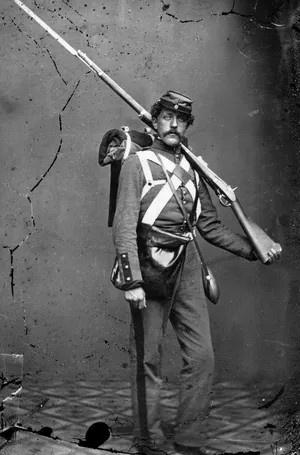 |
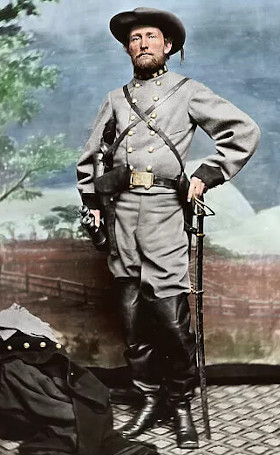 |
||
| Union soldier | Confederate soldier |
| ≡ | ⇧ |
Rorke's Drift
During the Zulu War, a huge force of Zulus attacked a small British garrison, but was eventually repelled after more than 12 hours of bitter fighting.
Eleven VCs were awarded to survivors.
| ≡ | ⇧ |
Boer War
The origins of the Boer War lay in Britain's desire to unite the British South African territories of Cape Colony and Natal with the Boer republics of the Orange Free State and the South African Republic (also known as the Transvaal). The Boers, Afrikaans-speaking farmers, wanted to maintain their independence.
| ≡ | ⇧ |
1st World War
World War I, also known as the Great War, began in 1914 after the assassination of Archduke Franz Ferdinand of Austria. His murder catapulted into a war across Europe that lasted until 1918. During the conflict, Germany, Austria-Hungary, Bulgaria and the Ottoman Empire (the Central Powers) fought against Great Britain, France, Russia, Italy, Romania, Canada, Japan and the United States (the Allied Powers). Thanks to new military technologies and the horrors of trench warfare, World War I saw unprecedented levels of carnage and destruction. By the time the war was over and the Allied Powers claimed victory, more than 16 million people—soldiers and civilians alike—were dead
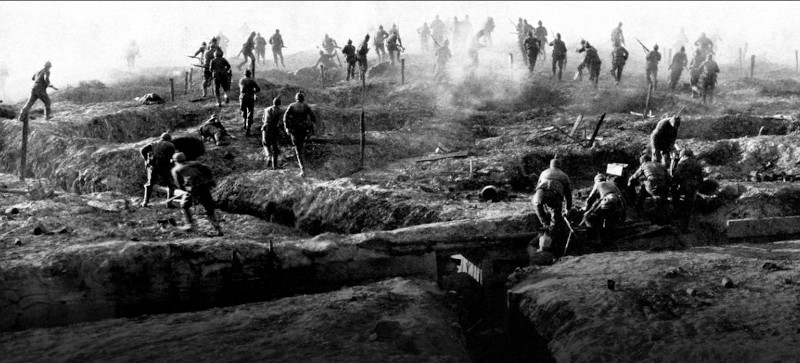 |
| ≡ | ⇧ |
2nd World War
World War II, also called Second World War, conflict that involved virtually every part of the world during the years 1939–45. The principal belligerents were the Axis powers—Germany, Italy, and Japan—and the Allies—France, Great Britain, the United States, the Soviet Union, and, to a lesser extent, China. The war was in many respects a continuation, after an uneasy 20-year hiatus, of the disputes left unsettled by World War I. The 40,000,000 – 50,000,000 deaths incurred in World War II make it the bloodiest conflict, as well as the largest war, in history.
Winston Churchill, Harry Truman, and Joseph Stalin
Along with World War I, World War II was one of the great watersheds of 20th-century geopolitical history. It resulted in the extension of the Soviet Union’s power to nations of eastern Europe, enabled a communist movement to eventually achieve power in China and marked the decisive shift of power in the world away from the states of western Europe and toward the United States and the Soviet Union.
| ≡ | ⇧ |
Seige of Leningrad
The siege of Leningrad was a prolonged military blockade undertaken by the Axis powers against the Soviet city of Leningrad on the Eastern Front of World War II. Germany's Army Group North advanced from the south, while the German-allied Finnish army invaded from the north and completed the ring around the city.
| ≡ | ⇧ |
Vietnam War
The Vietnam War was a long, costly and divisive conflict that pitted the communist government of North Vietnam against South Vietnam and its principal ally, the United States. The conflict was intensified by the ongoing Cold War between the United States and the Soviet Union. More than 3 million people (including over 58,000 Americans) were killed in the Vietnam War, and more than half of the dead were Vietnamese civilians. Opposition to the war in the United States bitterly divided Americans, even after President Richard Nixon signed the Paris Peace Accords and ordered the withdrawal of U.S. forces in 1973. Communist forces ended the war by seizing control of South Vietnam in 1975, and the country was unified as the Socialist Republic of Vietnam the following year.
 |